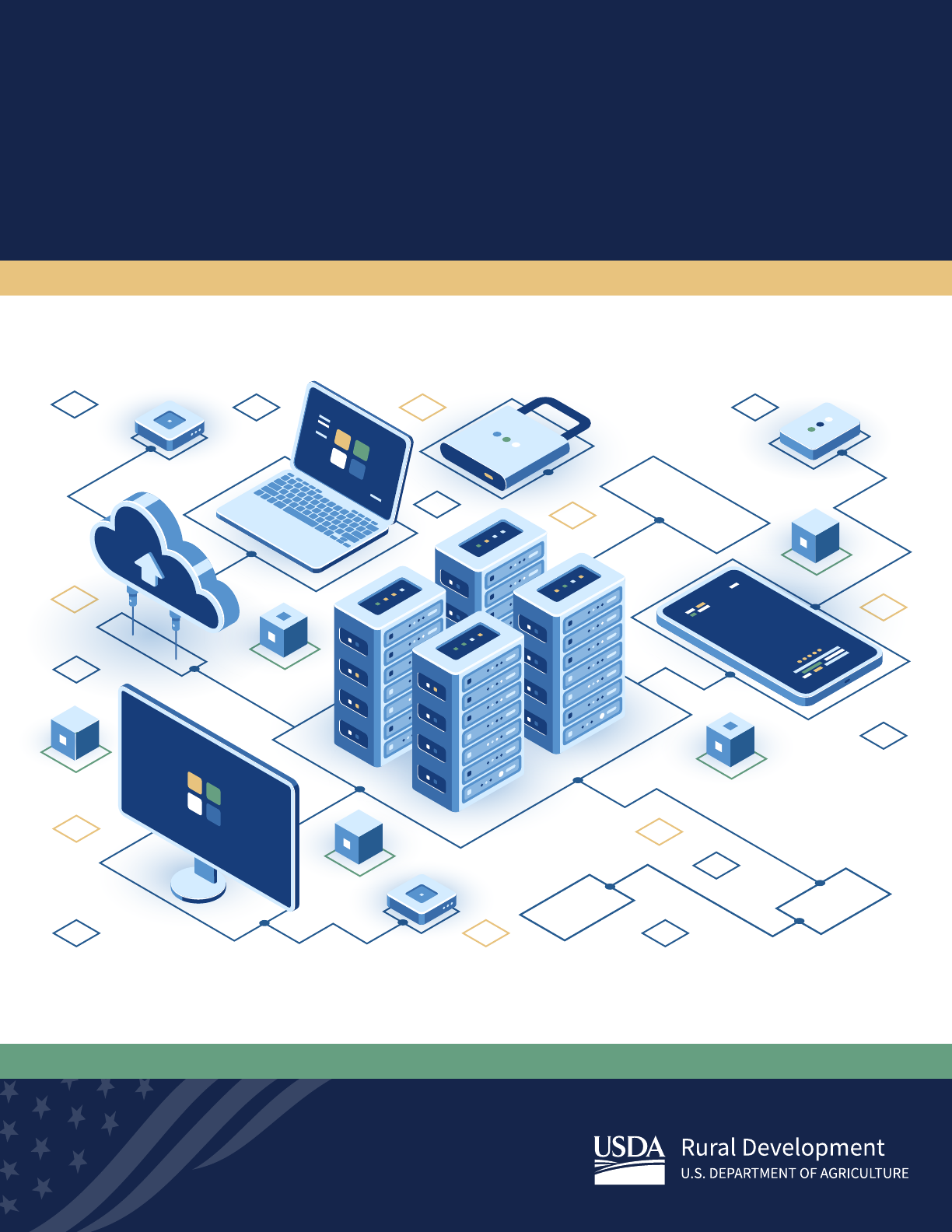
Rural Development
Reporting & Compliance
User Guide

Rural Development Reporting & Compliance User Guide 2
Version 4, April 2024
Table of Contents
Overview 6
1 Reporting & Compliance Access 7
1.1 Login.gov and USDA eAuthentication Account 7
1.2 User Security Roles & Permissions 8
1.3 Authorized Representative Request 9
2 Reporting & Compliance Navigation 14
2.1 Home Page 14
2.2 Switch Entity View 16
2.3 My R&C Profile 17
2.4 Entity Profile 18
2.4.1 Entity Details 18
2.4.2 User Management 19
2.5 Reports Dashboard 24
3 Reporting & Compliance Reports 26
3.1 R&C Report Types 26
3.2 Completing Account-Level Reports 28
3.2.1 Financial Report 28
3.2.2 Export Financial Report 47
3.2.3 System Data Report 49
3.2.4 Errors and Warnings for Financial & System Data Report Schedules 53
3.2.5 Review Page for Financial & System Data Report Schedules 53
3.2.6 Audit Report 53

Rural Development Reporting & Compliance User Guide 3
Version 4, April 2024
3.3 Completing Project-Level Reports 57
3.3.1 Construction Progress Report 57
3.3.2 How to Use the Construction Progress Map 58
3.3.3 Reporting Construction Progress to the Construction Progress Map 62
3.3.4 New Broadband Subscribers to Report for this Period 66
3.3.5 Annual Performance Report 67
3.3.6 Close Out Report 69
3.3.7 Annual Project Performance Activity Report 69
3.3.8 Final Project Performance Activity Report 70
3.4 Certifying and Submitting Financial and System Data Reports 71
3.4.1 Review Report Page 71
3.4.2 Initiate Report Certification 73
3.4.3 Certifying and Submitting the Report 74
3.4.4 Quarter 4 Financial Report Certification 75
3.5 Certifying and Submitting Project-Level Reports 76
3.5.1 Initiate Report Certification 76
3.5.2 Certifying and Submitting the Report 77
3.6 Post-Submission Process 78
Contact Us 81
Glossary of Key Terms 82
Appendix A: System-Generated Message Types 83
Appendix B: System-Generated Email Notifications 95
Appendix C Network Access Services Revenue Line Item Expansion 96

Rural Development Reporting & Compliance User Guide 4
Version 4, April 2024
Appendix D: Accounting Guidance for Grant Revenue 98
D1: Utility Cooperatives and Regulated Companies 98
D2: Governmental Entities, Indian Tribes, Territories and Possession of the United States98
D3: Not-For-Profit Organizations 98
D5: For-Profit Entities 98
Appendix E: Example of Reconciled Statement of Cash Flows 100
Appendix F: Depreciation Rates Crosswalk 103
Appendix G: Generate and Export R&C Reports to PDF 105
G1: Create and View a PDF for an UNSUBMITTED Report 105
G2: View a PDF for a SUBMITTED Report 111
G3: PDFs of Resubmitted Reports 114
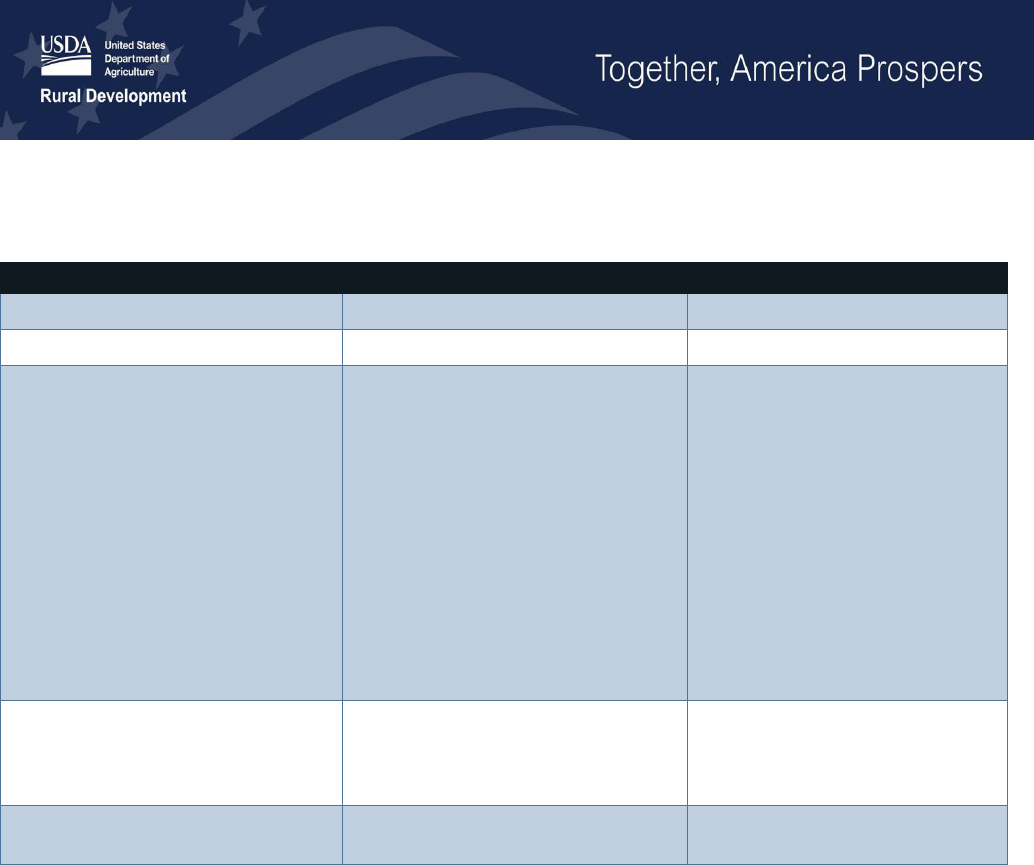
Rural Development Reporting & Compliance User Guide 5
Version 4, April 2024
Version History
Version
Change
Date
V1
Initial publication
December 2020
V1.1
Corrections and clarifying updates
March 2021
V2
Corrections and clarifying updates;
added new information addressing
the content of Financial Statements,
and Appendices C, D, E, and F.
Appendix C provides information on
the Network Access Services
Revenues schedule. Appendix D
provides accounting guidance for
grant revenues. Appendix E
contains an example of a reconciles
Statement of Cash Flows. Appendix
F provides a comparison of
depreciation categories between
DCS and R&C.
November 2021
V3
Added Appendix G to address new
feature: creating, viewing,
downloading of report PDFs;
Clarifying updates.
December 2023
V4
Updated New User Access
processes
April 2024

Rural Development Reporting & Compliance User Guide 6
Version 4, April 2024
Overview
The Reporting & Compliance (R&C) system is a reporting system that streamlines the reporting
process for entities receiving financial assistance from the Rural Utilities Service (RUS), an agency of
the U.S. Department of Agriculture (USDA). Users can access the R&C system at
reporting-and-
compliance.rd.usda.gov/s/. Entities receiving financial assistance from RUS are required to report
certain financial, operational, construction, and performance data on a quarterly or annual basis. Some
reports in R&C are to be submitted at an entity-level, whereas others are at the project-level. The
reporting requirements vary depending on the type of financial assistance that was approved for the
entity. These requirements are covered in the executed legal agreements between RUS and the entity.
This user guide is separated into three parts to allow users to consult only the sections that are
applicable to them.
• Part 1: Reporting & Compliance Access
• Part 2: Reporting & Compliance Navigation
• Part 3: Reporting & Compliance Reports
***As of January 1, 2024***
• Telecom Program Awardees reporting in R&C
o All Telecom Program awardees who received financial assistance under any of the
sub programs, excluding DLT only awardees, will be required to complete and
submit all their reports in R&C. They will not be required to submit any Telecom
Reports in DCS.
o DLT awardees that do not have any other Telecom Program awards will continue
to email their reports or report through the Federal Clearing House.
• Electric Companies with ReConnect Awards
o All ReConnect Program awardees who also received financial assistance under the
Electric Program will complete and submit their ReConnect award reports in R&C
and continue to submit their Electric Program reports in the Data Collection System
(DCS).

Rural Development Reporting & Compliance User Guide 7
Version 4, April 2024
1 Reporting & Compliance Access
USDA strongly recommends using one of the supported browsers listed below when accessing the
R&C to avoid any technical challenges associated with unsupported browsers.
Table 1: Supported Website Browsers
Icon
Supported Browser
Download Source
Microsoft Edge for Windows 10 Microsoft
Most recent stable version Google Chrome
Users must complete the following steps to access R&C:
1. Obtain a verified Login.gov account and link to USDA eAuth
Refer to Section 1.1 Login.gov and USDA eAuthentication Account below.
Users who already have a verified Login.gov account linked to eAuth can
skip this step.
2. Understand the different user security roles in R&C
Refer to the User Security Roles and Permissions
section for a complete
description of all the different security roles in R&C.
3. Submit an Authorized Representative Request (ARR)
Refer to the Authorized Representative Request
section below for
additional details on how to submit an ARR.
4. Add users to the entity account
After the ARR is approved, the Representative Signature Certifier (Rep
Sign Cert) and the Administrator(s) listed on the ARR receive an email
notification that access to R&C has been granted. These users can log in
R&C and add additional users to the entity’s account. Refer to the
User
Management section located under Section 2.4, Entity Profile, on how to
add new users to the entity account.
1.1 Login.gov and USDA eAuthentication Account
USDA eAuthentication has partnered with Login.gov to provide customers a multi-factor authentication
login option for secure and convenient access to USDA sites, including those developed and
maintained by the RUS Telecommunications Program.
Step 1 Applies To:
Users that do not have a
verified Login.gov
account
Step 2 Applies To:
All users
Step 3 Applies To:
Rep Sign Cert &
Administrators
Step 4 Applies To:
Rep Sign Cert &
Administrators

Rural Development Reporting & Compliance User Guide 8
Version 4, April 2024
As of March 2024, you may access Reporting and Compliance using two different login
credentials depending on when you first registered for access. The two credentials are
Login.gov and Level 2 eAuthentication (eAuth). This process will be transitioning to Login.gov
credentials only in the future.
• For help creating a new account to access Reporting &Compliance, please reference the
Login.gov User Aid found here:
https://www.rd.usda.gov/media/file/download/usda-rd-
loginuseraid.pdf.
1.2 User Security Roles & Permissions
All users who will be accessing R&C must be assigned a security role. Each user can only have one
security role per entity. Each role has different security permissions associated to it, which limits what
the user can or cannot do in R&C. The different security roles that are available in R&C are as follows:
• Representative Signature Certifier (Rep Sign Cert) – This security role is limited to one
employee of the entity. Every entity must have a single user designated as the Rep Sign Cert.
The user must be identified on the ARR and in the ARR Resolution as the Rep Sign Cert. This
security role allows the user to:
o Submit the ARR on behalf of the entity
o View and update all reports
o Add, edit, and remove users except the Rep Sign Cert
o Replace Rep Sign Cert
o Authorize certifications on behalf of the entity
o Submit reports to USDA
• Administrator – This security role is limited to employees of the entity. This security role can
be identified on the ARR as long as the user’s name and role are clearly stated in the ARR
Resolution. If the user is not stated in the ARR Resolution, then the user will not be added to
the entity’s account when the ARR is approved. The Rep Sign Cert can add this user to the
entity’s account once the ARR is approved by USDA. Unlike the Rep Sign Cert role, which is
limited to a single user, an entity’s account could include more than one Administrator. This
security role allows the user to:
o Submit the ARR on behalf of the entity
o View and update all the reports
o Add, edit, and remove users, except for the Rep Sign Cert
o Replace the Rep Sign Cert
General Login.gov and eAuth Help
I have general questions about my Login.gov and eAuth account.
Where can I find information about this?
For the most up to date information, refer to the USDA eAuth website FAQs
listed here, https://www.eauth.usda.gov/eauth/b/usda/faq.
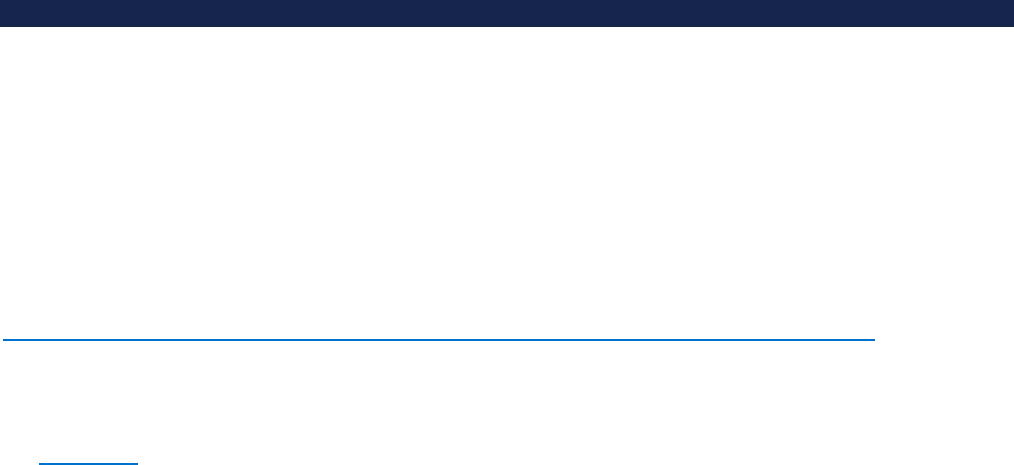
Rural Development Reporting & Compliance User Guide 9
Version 4, April 2024
• Representative Update Data (Rep Update Data) – This security role is limited to employees of
the entity. This security role allows the user to view and update all the reports. Users with this
security role can be added to the entity’s account by the Rep Sign Cert or the Administrator.
This security role allows the user to:
o View and update all the reports
o Replace the Rep Sign Cert
• Consultant – This security role is for the entity’s consultants. Users with this security role can
be added to the entity’s account by the Rep Sign Cert or the Administrator. Do not assign a
security role, other than the Consultant, to users that do not work for the entity.
o View and update all the reports
o Replace the Rep Sign Cert
• Viewer – This security role allows the user to view the reports. Users with this security role can
be added to the entity’s account by the Rep Sign Cert or the Administrator.
1.3 Authorized Representative Request
The ARR process ensures that only the users authorized by an entity will have access to the entity’s
account and reports in R&C. Users that previously submitted an ARR through the Application Intake
system will not be required to submit another ARR to gain access to R&C.
The ARR must be submitted by either the Rep Sign Cert or Administrator who is identified in the ARR
resolution. Only the Rep Sign Cert designation is required on the ARR; however, Administrators can
also be included on the ARR. The ARR and ARR Resolution must clearly identify the user(s) who will
have the security role of a Representative Signature Certifier (Rep Sign Cert) and any Administrator(s),
if mentioned on the ARR Resolution. Since each user can only have one security role per entity, do
not assign both the Rep Sign Cert and any Administrator security role to one user. Sample board
resolutions are available in the Instructions for Submitting a Resolution as Part of the ARR document:
https://www.usda.gov/sites/default/files/documents/arr-resolution-instructions-samples.pdf
.
Follow the steps below for submitting an ARR:
1. The Rep Sign Cert or Administrator who will be identified in the ARR resolution must navigate to the
R&C login
page.
2. At the Customer Login screen, depending on if you are using a Login.gov or eAuth User ID, select
the appropriate link to login.
3. Enter your verified Login.gov or eAuth credentials (i.e. Login.gov or eAuth User ID and password).
This sends you to the R&C Home page.
4. Click the [Start an ARR] button on the Home page.
1. Enter the entity’s Tax Identification Number (TIN) and Unique Entity Identifier (UEI) under the Entity
Information, as shown in Figure 1 below. The DUNS number is no longer required.
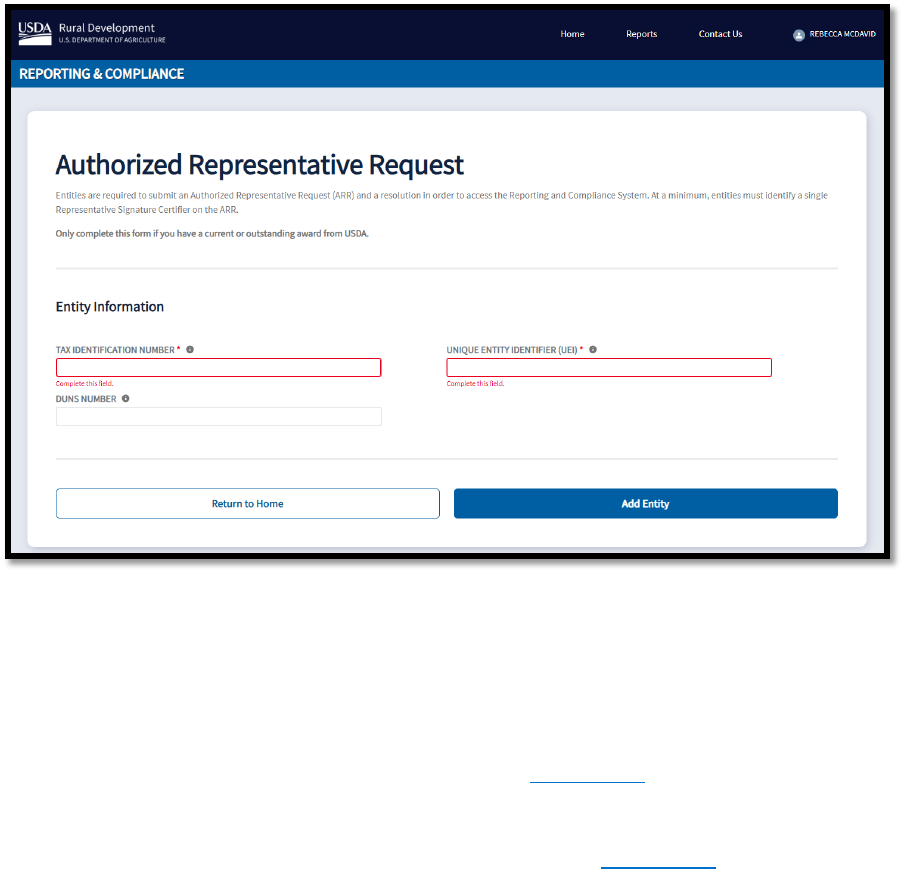
Rural Development Reporting & Compliance User Guide 10
Version 4, April 2024
Figure 1: Authorized Representative Request
2. Click the [Add Entity] button.
• If a match on the TIN and UEI is not found, an error message, “Entity cannot be found. Please
check the accuracy of the TIN, UEI, and DUNS numbers. If you have been awarded, try again
or contact us for further help.” displays on the screen. Please check the accuracy of the TIN and
DUNS that was entered. If the error persists, please Contact Us
to report the issue.
• If a match on the TIN and UEI is found, the Legal Name and the Headquarters State of the
entity auto-populates on the ARR. Both these fields are non-editable, as shown in Figure 2
below, so if any changes need to be made, the user should Contact Us
to request the changes.
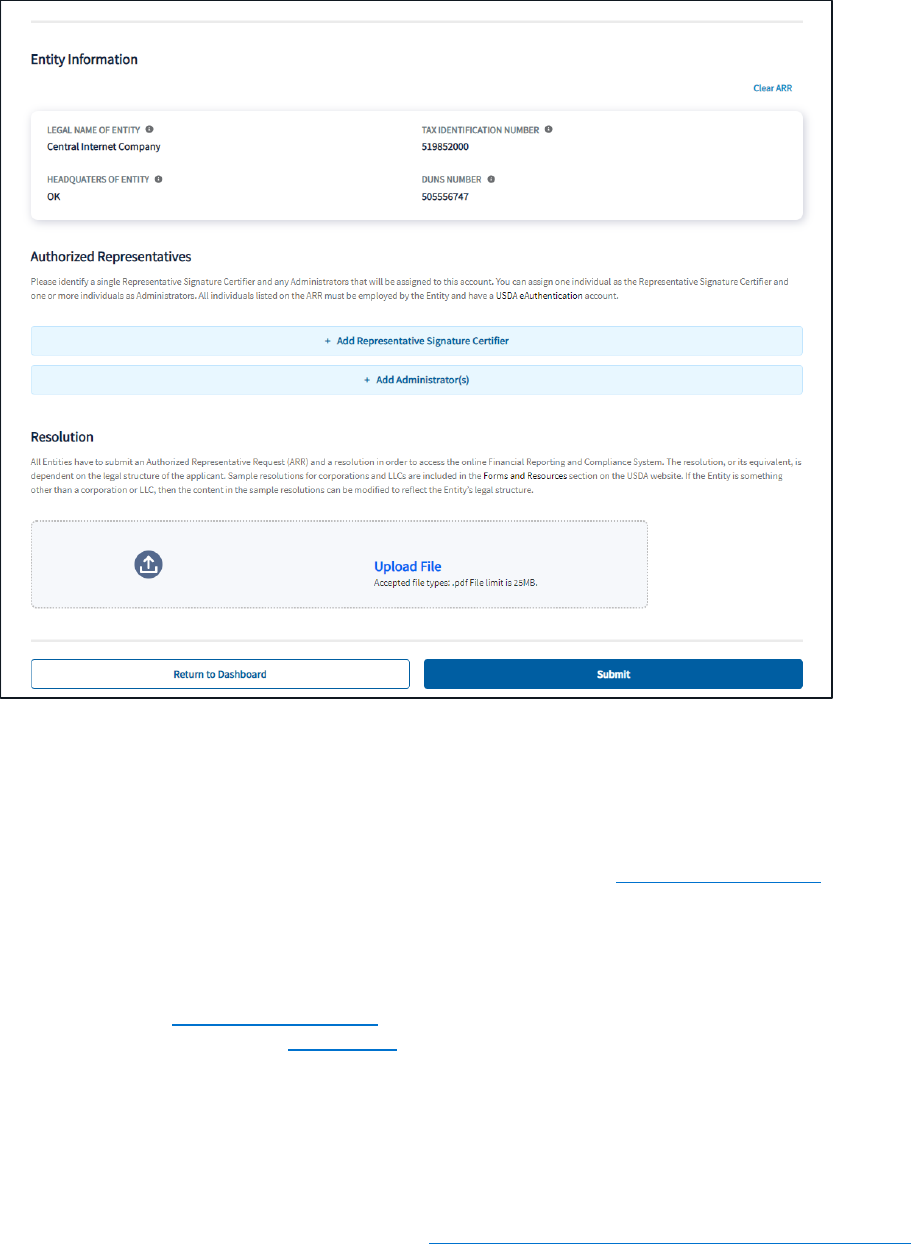
Rural Development Reporting & Compliance User Guide 11
Version 4, April 2024
Figure 2: Completing the ARR
3. If all the Entity Information is correct, click the [Add Representative Signature Certifier] button, as
shown above, to enter the information on the Rep Sign Cert. A window will display requesting
additional information on the user. Enter the Rep Sign Cert’s eAuth user ID.
3.1. The system will validate the user’s eAuth ID and auto-populate the user’s information from their
eAuth account. Check the user’s information for accuracy. If any updates need to be made to
the user’s auto-populated information, the user should go to the USDA eAuth website
to make
those updates in their USDA eAuth account.
3.2. Enter the current phone number for the user and click the [Save] button.
3.3. If the eAuth ID is not validated by the system, an error message “User not found” will display
on the screen. Check the eAuth ID of the user for accuracy and enter it again. If the error
persists, go to the USDA eAuth website
and verify that the eAuth account is a verified Level II
account, or if needed, use the Contact Us link in the upper right of the Home page in R&C to
submit a request for assistance.
4. Follow the same steps as outlined above to add any Administrator(s) on the ARR if the user is
identified on the ARR Resolution. If not, this user can be added later by the Rep Sign Cert once the
ARR is approved.
5. Click the [Upload] button to upload the signed ARR resolution that matches the information entered
on the ARR. The R&C only accepts a PDF file type with a maximum file size of 25 MB. Additional
tips and sample ARR resolutions are available in
Instructions for Submitting a Resolution as Part of
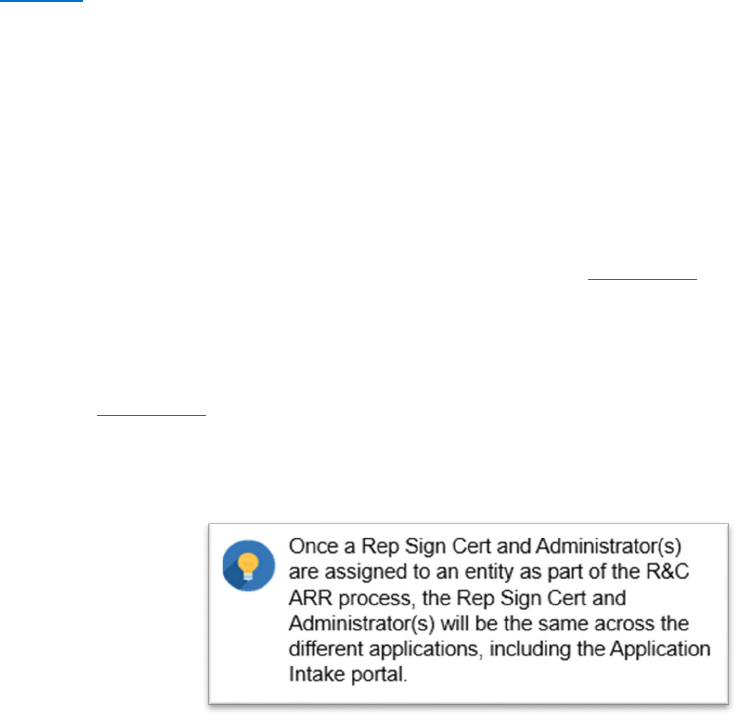
Rural Development Reporting & Compliance User Guide 12
Version 4, April 2024
the ARR. Yo
u can download and view the ARR resolution before submitting the ARR by clicking on
the file shown on the page.
6. Clic
k the [Submit] button at the bottom of the page. If an error message displays, you must address
the identified errors. In most cases, the user skipped a required field or forgot to upload the ARR
Resolution.
7. Once the ARR is submitted, USDA will review and process the ARR generally within two business
days.
• If the ARR is approved, the authorized representative(s) listed on the ARR will receive an
email notification that the ARR is approved. These users can then login to R&C and begin
reporting activities or add additional users to the entity’s account. If you have any difficulties
adding Level II eAuth users, please contact us using the Contact Us
l
ink in the upper right of the
Home page in R&C and select Reporting on the Subject drop down. Please make sure to
include your entity’s name and the user’s email address you are trying to add.
• If
the ARR is rejected, only the user who submitted the ARR will receive an email notification
identifying the reason(s) for rejection. Direct any further questions regarding the ARR rejection
to the Contact Us
l
ink in the upper right of the Home page in R&C and select Authorized
Representative Request on the Subject drop down. Please make sure to include your entity’s
name and the question you have in the Question box.

Rural Development Reporting & Compliance User Guide 13
Version 4, April 2024
ARR FAQs
1. My entity submitted an Authorized Representative Request (ARR) and linked the
account to our employees and consultants in the Application Intake System. Do
we need to submit another ARR for R&C?
No. In the Application Intake System, the Rep Sign Cert and Administrator associated
with the ARR will have access to the R&C System and be able to add users to the
entity’s account.
2. I am trying to submit my ARR, but the system isn’t recognizing my entity’s Tax
ID Number (TIN) and UEI Number. What should I do?
If your entity cannot be found when entering the TIN and UEI combination, please try
again checking for accuracy as you enter the numbers. If the issue persists and your
entity has received an award, please Contact Us to report the issue and receive the
necessary assistance.
3. I am trying to add the same person as the Rep Sign Cert and Administrator on
the ARR. Is this allowed?
No. Each user can only have one security role per entity assigned in R&C.
4. How do I fill out the ARR Resolution on behalf of my Entity?
Tips and sample ARR resolutions are available in the Instructions for Submitting a
Resolution as Part of the ARR.
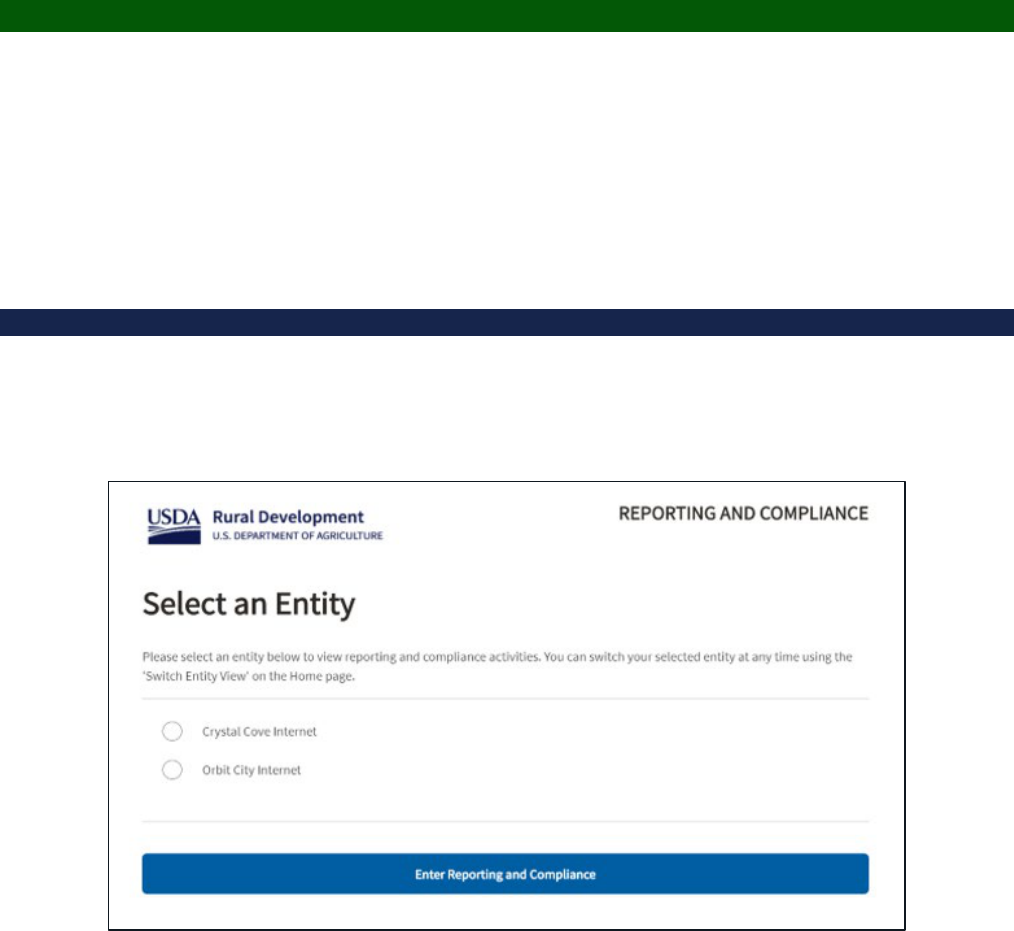
Rural Development Reporting & Compliance User Guide 14
Version 4, April 2024
2 Reporting & Compliance Navigation
Part 2 of this guide provides guidance for navigating across, into, and back out from the different
portions of the R&C system. This part is organized in five sections:
• Home Page
• Switch Entity View
• My R&C Profile
• Entity Profile
• Reports Dashboard
2.1 Home Page
When you log in, the R&C Home page displays. If you have credentials for multiple entity accounts, a
Select an Entity window, as shown in the Figure 3 below, displays so that you can select the Entity for
which you are reporting before the R&C Home page displays.
Figure 3: Select an Entity
The Home page link will always send you to the Home page. The Reports link sends you to the
Reports dashboard. A dropdown menu under your name displays the links for My R&C Profile, Entity
Profile, and Logout, as shown in Figure 4, below.
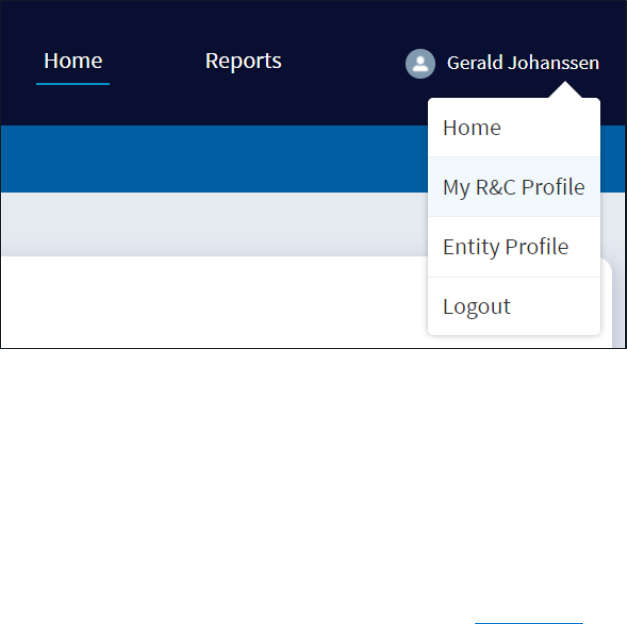
Rural Development Reporting & Compliance User Guide 15
Version 4, April 2024
Figure 4: Dropdown Menu under the user’s name
The Home page displays all the current reports that the entity needs to submit as shown in the Figure 5
below. If the entity is current on all its reports, the Home page displays “Nothing to do for now!” As R&C
generates reports, they display on this page with their respective reporting periods and due dates. In
addition, if a report has not been submitted by its due date, an OVERDUE indicator displays in the
status column. If a report is returned by USDA for additional information, a RESUBMISSION
REQUESTED indicator displays in the status column.
You can click the [View Reports] button below the table or click the Reports dashboard link to access
the reports. If there are any inconsistencies between the reports displayed on the Home page and the
reporting requirements in the executed legal agreement, please use Contact Us
.
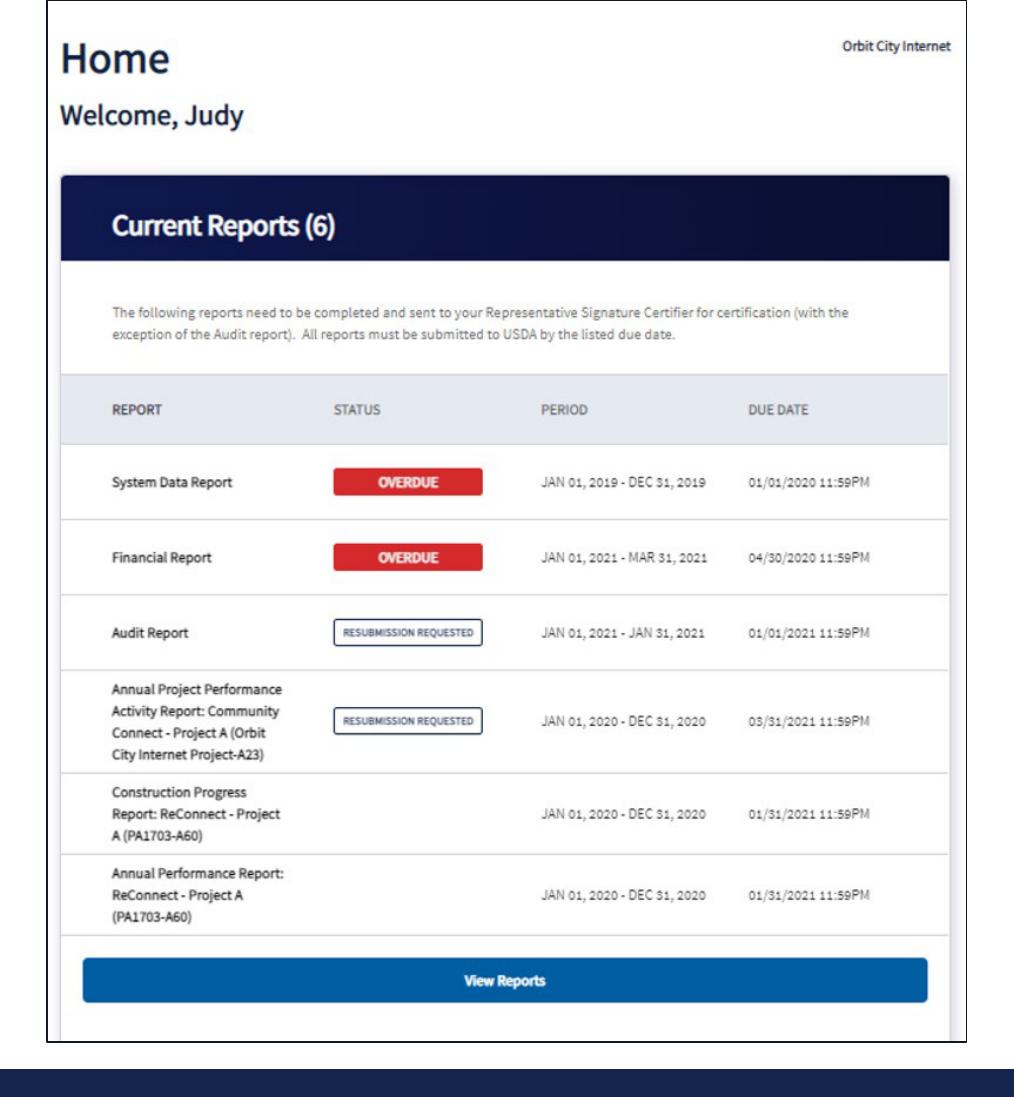
Rural Development Reporting & Compliance User Guide 16
Version 4, April 2024
Figure 5: Home Page, Current Reports Table with Required Reports Overview
2.2 Switch Entity View
In R&C, users can be linked to more than one entity account with a single eAuth ID. Users that have
been added to several entity accounts must select the entity account they want to work on when they
enter R&C. To change the entity account after logging in, you can switch the entity account as follows:
1. Click the [Switch Entity View] link located on the top right corner of the Home page as shown in
Figure 6.
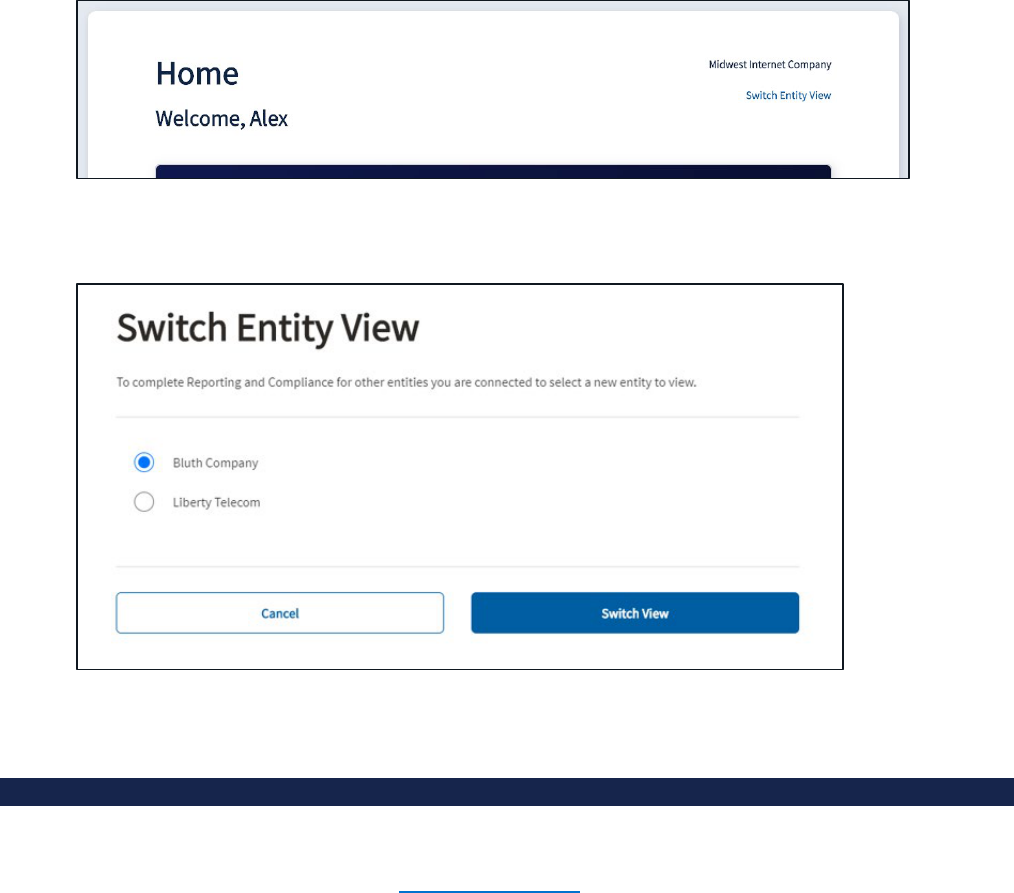
Rural Development Reporting & Compliance User Guide 17
Version 4, April 2024
Figure 6: R&C Dashboard – Switch Entity
2. A window displays, as shown in Figure 7, that lists all the entities the user is linked to in R&C.
Figure 7: Switch Entity Window
3. Select the desired entity and click the [Switch View] button.
4. Your Home page will now display the name of the selected entity in the top right corner.
2.3 My R&C Profile
My R&C Profile features your Profile Details and the Associated Entities to which you are linked.
This information is based on the eAuth ID that was used to add you to an entity’s account either
through the ARR process or through the User Management
process.
In addition, if the user needs to associate another active entity to themselves in R&C, they may start an
ARR in their R&C Profile by clicking the [Start an Authorized Representative Request] button on this
page.
• The Profile Details displays your Name, Email, and Phone Number, as shown in Figure 8 below.
The first two items auto-populate from your eAuth account so if the information needs any updates,
go to the USDA eAuth website to make the necessary changes. The updated information will be
available the next time you log into R&C. To update the phone number, click the [Edit] button. Enter
the new phone number in the window that pops up and click the [Save] button.
• The Associated Entities displays the Primary Borrower ID, Entity Name, and the Security Role
assigned for each entity to which you’re linked.

Rural Development Reporting & Compliance User Guide 18
Version 4, April 2024
Figure 8: My Reporting and Compliance Profile Details
2.4 Entity Profile
The Entity Profile page displays the Entity’s legal name, the Primary Borrower ID (number assigned by
USDA), the Fiscal Year-end date, and the Tax Identification Number. It also includes two tabs: Entity
Details and Users as shown in Figure 9 below.
2.4.1 Entity Details
The Entity Details tab displays the DUNS, UEI, CAGE Code, legal structure, congressional district of
the entity’s headquarters, phone number, physical address and the correspondence address of the
entity, as shown in Figure 9 below. None of the fields on this tab are editable; therefore, if any
information needs to be updated, please use Contact Us
.
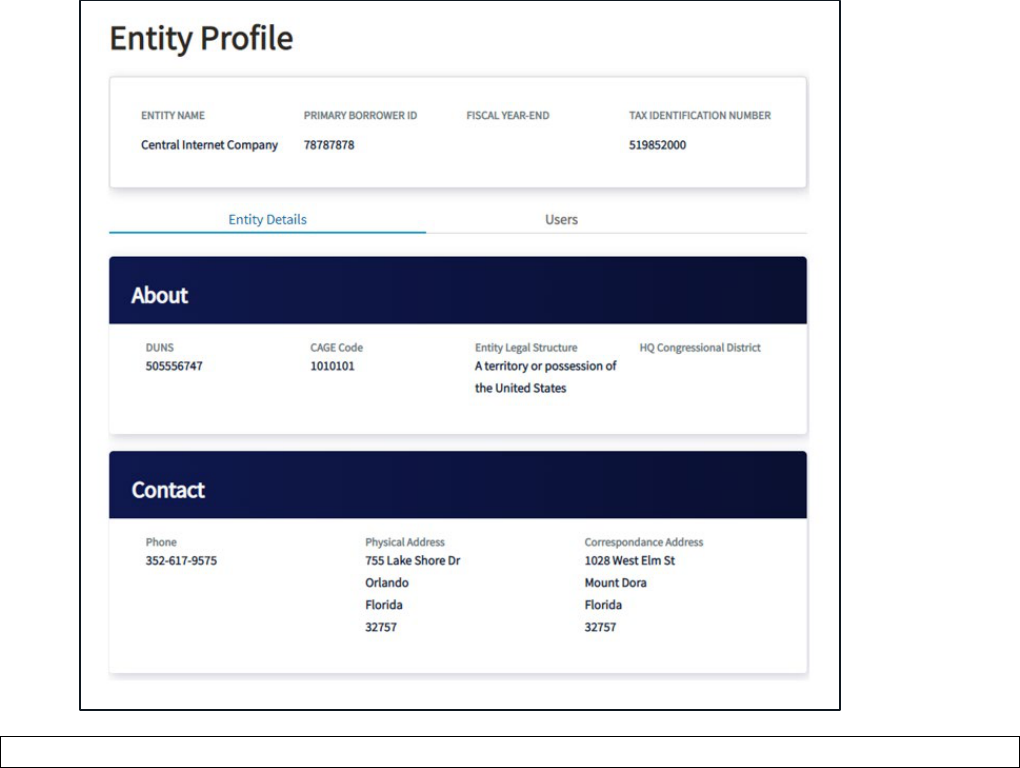
Rural Development Reporting & Compliance User Guide 19
Version 4, April 2024
Figure 9: Entity Profile page, Entity Details tab
2.4.2 User Management
The Users tab displays all the users linked with the Entity’s account, as shown in Figure 10 below. Only
the Rep Sign Cert and Administrator(s) can add a new user, edit a user’s details, or remove a user. All
other users can only view the user details for each user.
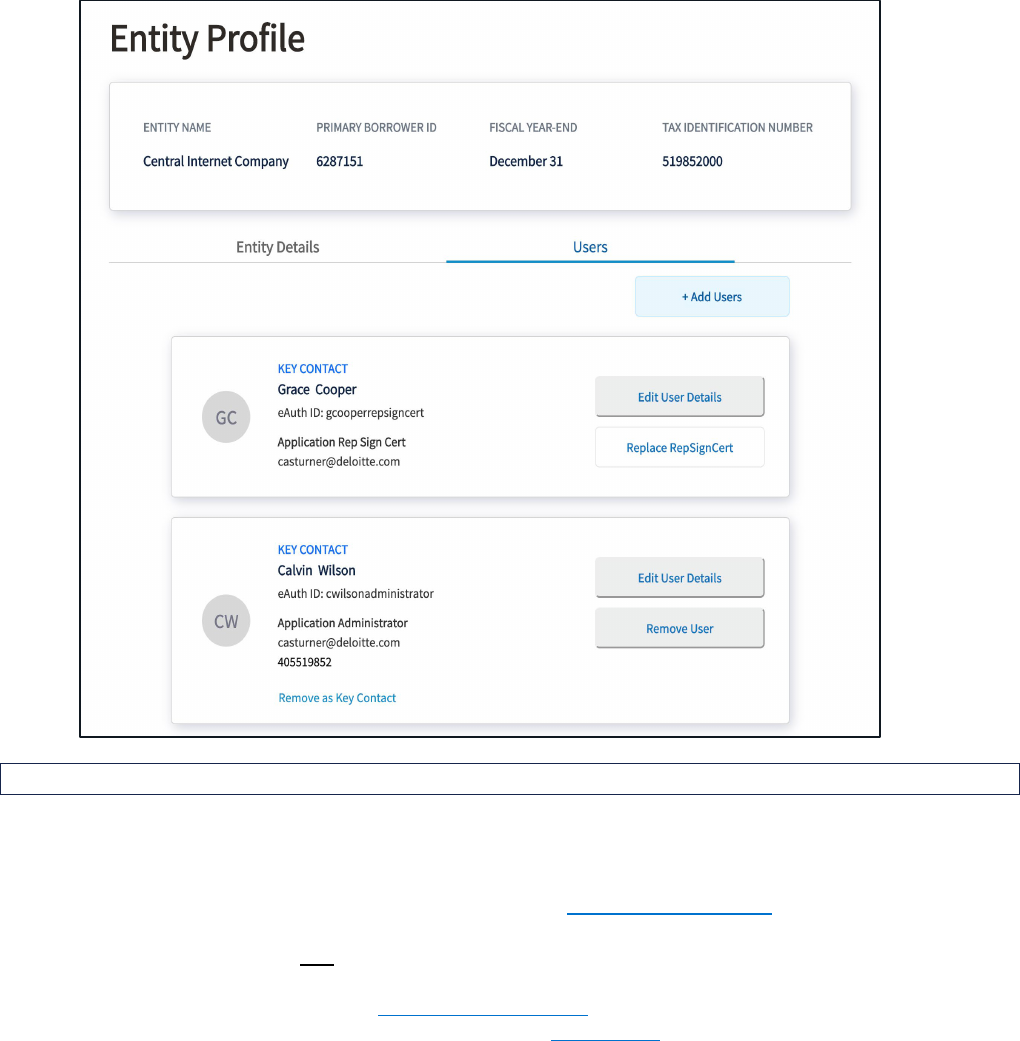
Rural Development Reporting & Compliance User Guide 20
Version 4, April 2024
Figure 10: Entity Profile, Users Details tab
2.4.2.1 Adding a New User
1. Click the [+Add Users] button located on the top right corner of the Users tab shown in Figure 10
above.
2. An Add User window, as shown in Figure 11 below, displays. Enter the new user’s USDA eAuth ID.
The USDA eAuth ID will be the User ID shown on the USDA eAuth website
. If the eAuth ID is valid,
then the First Name, Middle Name, Last Name, and Email auto-populate from the user’s eAuth
account. If the eAuth ID is not validated by the R&C system, an error message “User not found”
displays on the screen. Check the eAuth ID of the user for accuracy and enter it again. If the error
persists, the user should go to the
USDA eAuth website to verify that their eAuth account exists,
confirm it is a verified account, or if needed, use the Contact Us link in the upper right of the Home
page in R&C to contact us.
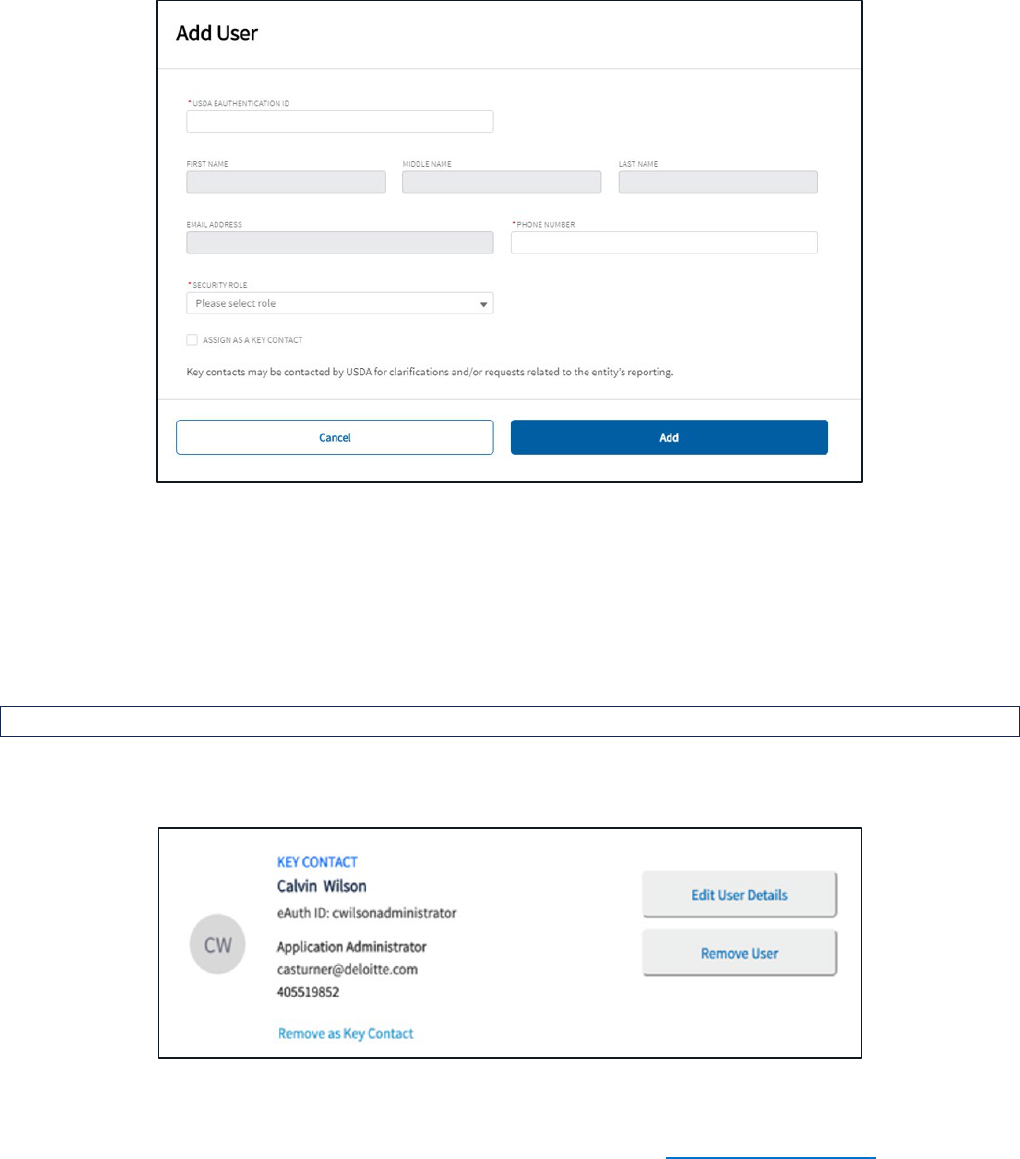
Rural Development Reporting & Compliance User Guide 21
Version 4, April 2024
Figure 11: Add User window
3. Enter the phone number of the user.
4. Select the new user’s security role from the drop-down list.
5. Select the checkbox next to ASSIGN AS A KEY CONTACT if this user needs to be assigned as a
Key Contact.
6. Click the [Add] button located at the bottom of the window. A message “User added” displays at the
top of the window.
2.4.2.2 Editing an Existing User
1. Click the [Edit User Details] button in the user details box as shown in Figure 12 below.
Figure 12: Key Contact, Edit User Details or Remove User
2. The Edit User window displays, as shown in Figure 13 below. The only editable fields in this window
are the user’s Phone Number, Security Role, and Key Contact fields. If the user’s information in the
auto-populated fields requires updates, that user must go to the USDA eAuth website
to make the
necessary updates in their USDA eAuth account. The updated information will be available the next
time the user logs in R&C.

Rural Development Reporting & Compliance User Guide 22
Version 4, April 2024
3. Update the phone number, security role, or key contact designation as necessary, and click the
[Save] button
4. A message “Contact Updated” displays at the top of the window.
Figure 13: Edit User window
2.4.2.3 Removing a User
1. Click the [Remove User] button in the user details box as shown in Figure 12 above.
2. The Remove User window, as shown in Figure 14 below, displays to confirm the Rep Sign Cert’s or
Administrator’s intention to remove the user from the entity’s account.
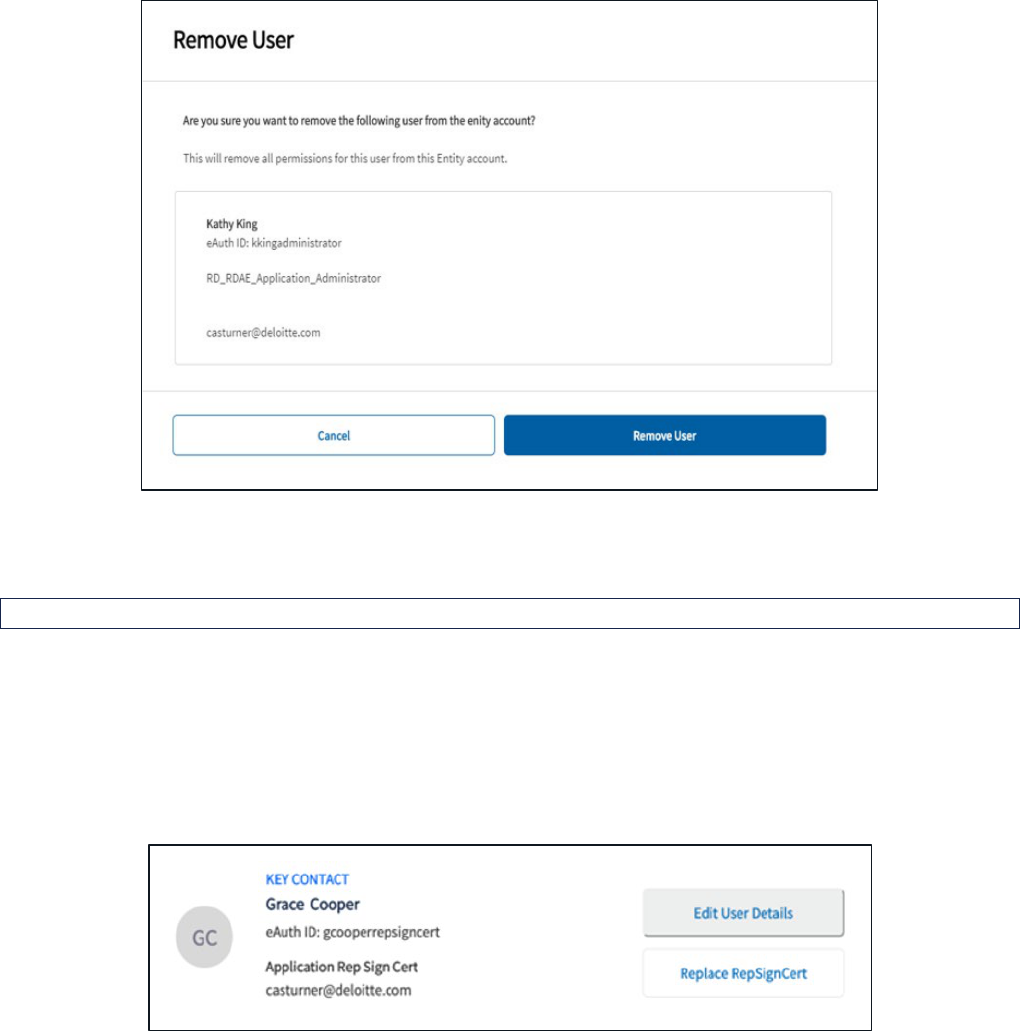
Rural Development Reporting & Compliance User Guide 23
Version 4, April 2024
Figure 14: Remove User confirmation window
3. Click the [Remove User] button.
4. A message “Contact has been removed” displays at the top of the window.
2.4.2.4 Replacing the Representative Signature Certifier
As mentioned earlier, any user can be removed from the entity’s account following the Remove User
process described above, except for the Entity’s Rep Sign Cert. If an entity needs to replace its current
Rep Sign Cert with another person, then any user on the entity’s account can submit a request to
update the Rep Sign Cert by following the steps below:
1. Click the [Replace RepSignCert] button in the user details box as shown in Figure 15.
Figure 15: Replace Rep Sign Cert
2. The Update Representative Signature Certifier window displays, as shown in Figure 16 below.

Rural Development Reporting & Compliance User Guide 24
Version 4, April 2024
Figure 16: Update Representative Signature Certifier confirmation window
3. Enter the new Rep Sign Cert’s eAuth ID. If the eAuth ID is not validated by the R&C system, an
error message “User not found” displays on the screen. Check the eAuth ID of the user for accuracy
and enter it again. If the error persists, the user should go to the
USDA eAuth website to verify that
their eAuth account exists, confirm it is a verified account, or if needed create a new verified eAuth
account.
4. Enter the phone number of the user.
5. Click the [Upload] button to upload the updated ARR resolution authorizing the user as the new Rep
Sign Cert.
6. Select the checkbox next to ASSIGN AS A KEY CONTACT to assign the user as a Key Contact.
7. Click the [Submit] button. The user details on the Users tab, displays a Pending Removal status for
the existing Rep Sign Cert, and a Pending Approval status for the new Rep Sign Cert. These
statuses will remain until USDA approves the update request.
2.5 Reports Dashboard
The Reports dashboard displays all the R&C reports that were generated for the entity in three
separate tabs: Current Reports, Pending Certification and Submitted to USDA.
Table 2: Reports Dashboard Tabs
Tab Name
Details
User Role Access
Current Reports
Displays all the reports that are in progress and have
not been forwarded to the Rep Sign Cert.
All user roles, except for the Viewer,
can view and edit any of the Current
Reports.
Pending
Certification
Displays all the reports that have been forwarded to
the Rep Sign Cert to be reviewed, certified, and
submitted to USDA.
All user roles can view the reports
but only the Rep Sign Cert can edit
the reports.
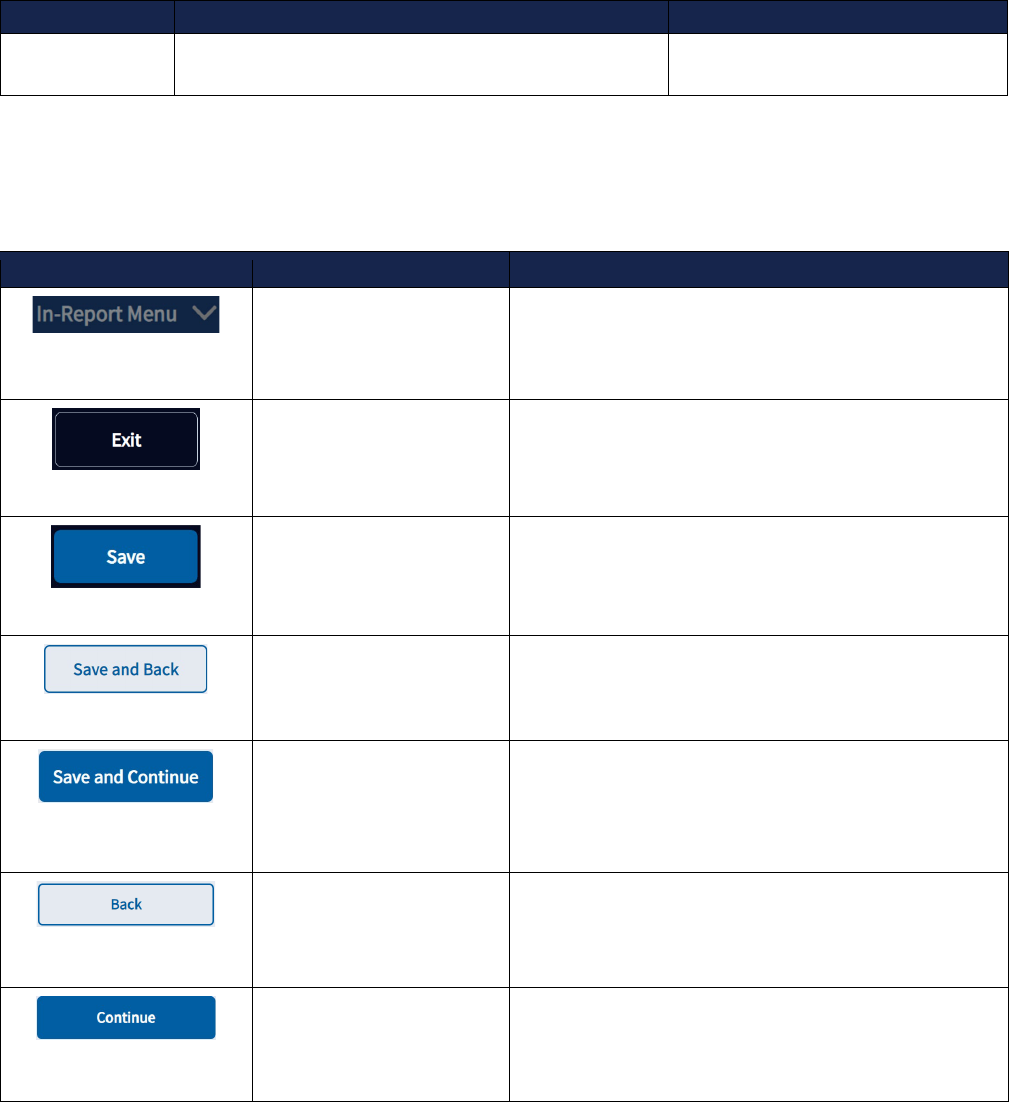
Rural Development Reporting & Compliance User Guide 25
Version 4, April 2024
Tab Name
Details
User Role Access
Submitted to
USDA
Displays all the reports that were submitted to USDA
by the entity.
All user roles can view the reports.
Table 3: Navigation Tools in the R&C
This table provides pictures of buttons and other navigation tools in R&C, and their locations on the
page, as well as a brief description of how to use them.
Icon & Name
Screen Location
Function
In-Report Menu accordion
Top left of the page
The In-Report Menu is an “accordion” because it can
expand and collapse part of the page. Click on the In-
Report Menu to toggle the menu on and off.
[Exit] button
Top right of the page
Does not save the data entered on the page
User is directed to the Reports Dashboard
[Save] button
Top right of data entry
pages
Saves the data entered on the page
User remains on the page
[Save and Back] button
Bottom left of data entry
pages
Saves the data entered on the page
User is directed to previous reporting section
[Save and Continue]
button
Bottom right of data entry
pages
Saves the data entered on the page
User is directed to the next reporting section
[Back] button
Bottom left of review pages
No data is entered on this page
This page is a read-only page
User is directed to previous reporting section
[Continue] button
Bottom right of review
pages
No data is entered on this page
This page is a read-only page
User is directed to next reporting section

Rural Development Reporting & Compliance User Guide 26
Version 4, April 2024
3 Reporting & Compliance Reports
Part 3 of this guide provides instructions on how to complete, certify, submit, and access each report.
This part also describes the post-submission process once a report has been submitted to USDA.
Reports will display on both the Home page and the Reports dashboard. This part is organized in three
sections:
• Completing the Reports provides instructions on how to complete each report. It is organized by
report type, so that you can quickly find the information on a specific report.
• Certifying and Submitting the Reports provides instructions on initiating the certification process
for the Rep Sign Cert and submitting the report to USDA. The Audit Report does not require
certification to be submitted to USDA.
• Post-Submission Process provides instructions on how to access reports already submitted to
USDA and how to resubmit a report if USDA has returned it for additional information.
Answers to common questions about how to complete reports can be found in the
Frequently Asked
Questions document located on the Reporting and Compliance page of the ReConnect website:
https://www.usda.gov/reconnect/reporting-compliance.
3.1 R&C Report Types
Reports are categorized as either an account-level report or a project-level report. Account-level reports
are required at the entity level and project-level reports are required for each award. The variability and
frequency of account-level reports are based on the entity’s legal structure and its portfolio of awards.
Project-level reports are based on the specific requirements of the award the entity received. At any
time, USDA reserves the right to adjust frequencies and deadlines for the required reports.
The tables below list all the R&C reports that are specific to Telecommunications Program awardees.

Rural Development Reporting & Compliance User Guide 27
Version 4, April 2024
Table 4: Telecommunications Program – Account-Level Reports
Report Name
Reporting
Frequency
Creation Date
Due Date
Financial Report
Quarterly
Initial generation of report is the
first day of the calendar-year
quarter after funds are released
(ReConnect) or legal
agreement date exists (other
Telecommunications
subprograms). Then, the first
day of each subsequent
calendar-year quarter.
January 31
System Data
Report
Annually
Initial generation of report is the
first day of the calendar year
after funds are released
(ReConnect) or legal
agreement date exists (other
Telecommunications
subprograms). Then, the first
day of each subsequent
calendar year.
January 31
Audit Report
Annually
Initial generation of report is the
first day of the entity’s fiscal
year after the first advance
occurs. Then, the first day of
each subsequent audit year.
Based on audit review
type:
7 CFR 1773: 120 days
after creation date
2 CFR 200: 276 days
after creation date
Table 5: Telecommunications Program – Project-Level Reports
Report Name
Reporting Frequency
Creation Date
Due Date
Construction
Progress Report
Annually
First day of the calendar year
January 31
Annual
Performance
Report
Annually for a period of three
years following the year that
construction was completed
and certified in the R&C
First day of the calendar year
following the year that
construction was completed
and certified in the R&C
January 31
Close Out Report
N/A
Created following the event that
occurs last:
• expiration date of the award
• termination of the award
• project completion
• final disbursement of the
award by the awardee
120 days after
creation date
Annual Project
Performance
Activity Report
Annually
First day of the calendar year
after the first advance occurs.
January 31
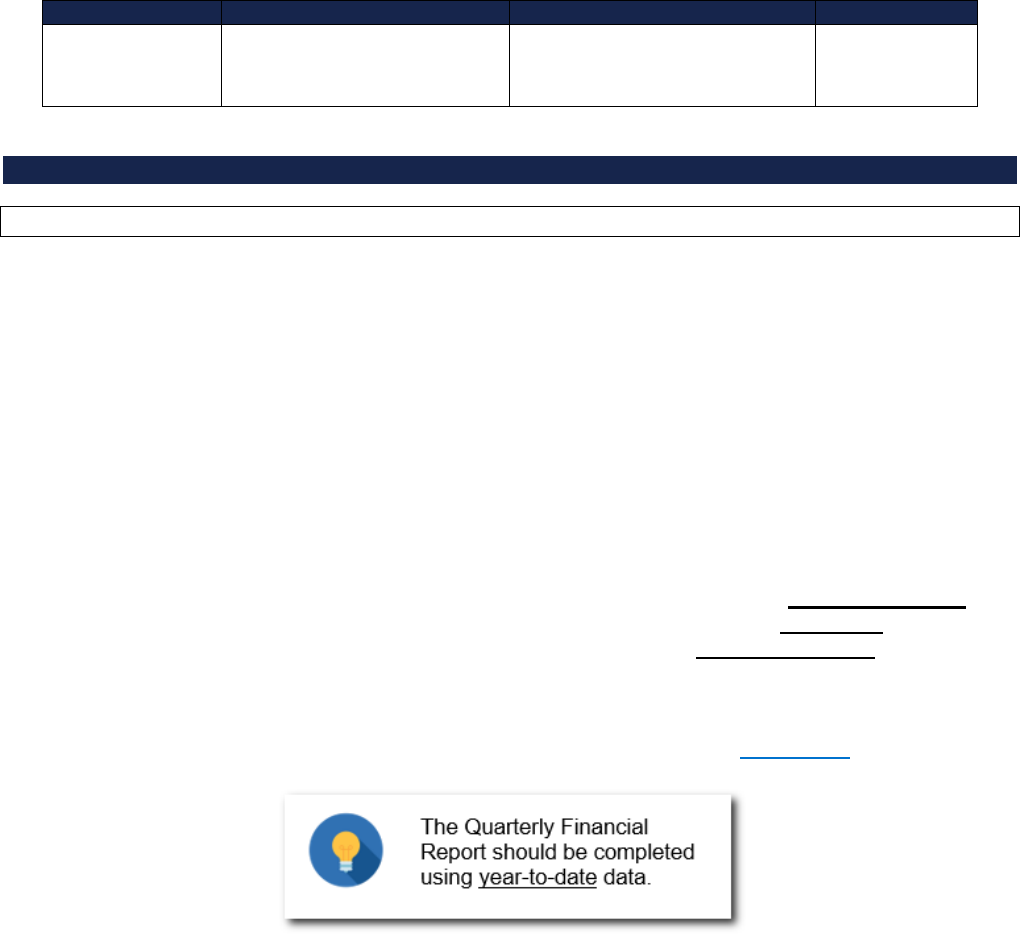
Rural Development Reporting & Compliance User Guide 28
Version 4, April 2024
Report Name
Reporting Frequency
Creation Date
Due Date
Final Project
Performance
Activity Report
N/A
Same as Close Out Report
creation requirements
120 days after
creation date
3.2 Completing Account-Level Reports
3.2.1 Financial Report
The Financial Report is an account-level report that collects information on the current financial
performance of the entity. This report consists of six report schedules and each report schedule
includes a Data Entry page and a Review page:
• Network Access Services Revenue- Year to Date
• Non-Operating Net Income- Year to Date
• Income Statement- Year to Date
• Balance Sheet- As of the end of the Current Reporting Period
• Statement of Cash Flows- Calendar Year to Date Change
• Subscriber Data- Quarterly Changes
If the entity required to submit the Financial Report is a parent company, the parent company must
report its Income Statement, Balance Sheet, and Statement of Cash Flows on a standalone basis. If
the entity required to submit the Financial Report is a subsidiary, the subsidiary must also report its
Income Statement, Balance Sheet, and Statement of Cash Flows on a standalone basis.
Data appears in the Financial Report the following ways: auto-populated from the previous Financial
Report or the current Financial Report schedules; calculated by the system; or entered manually by
the user. To make edits to a previously submitted Financial Report, refer to Section 3.6
.
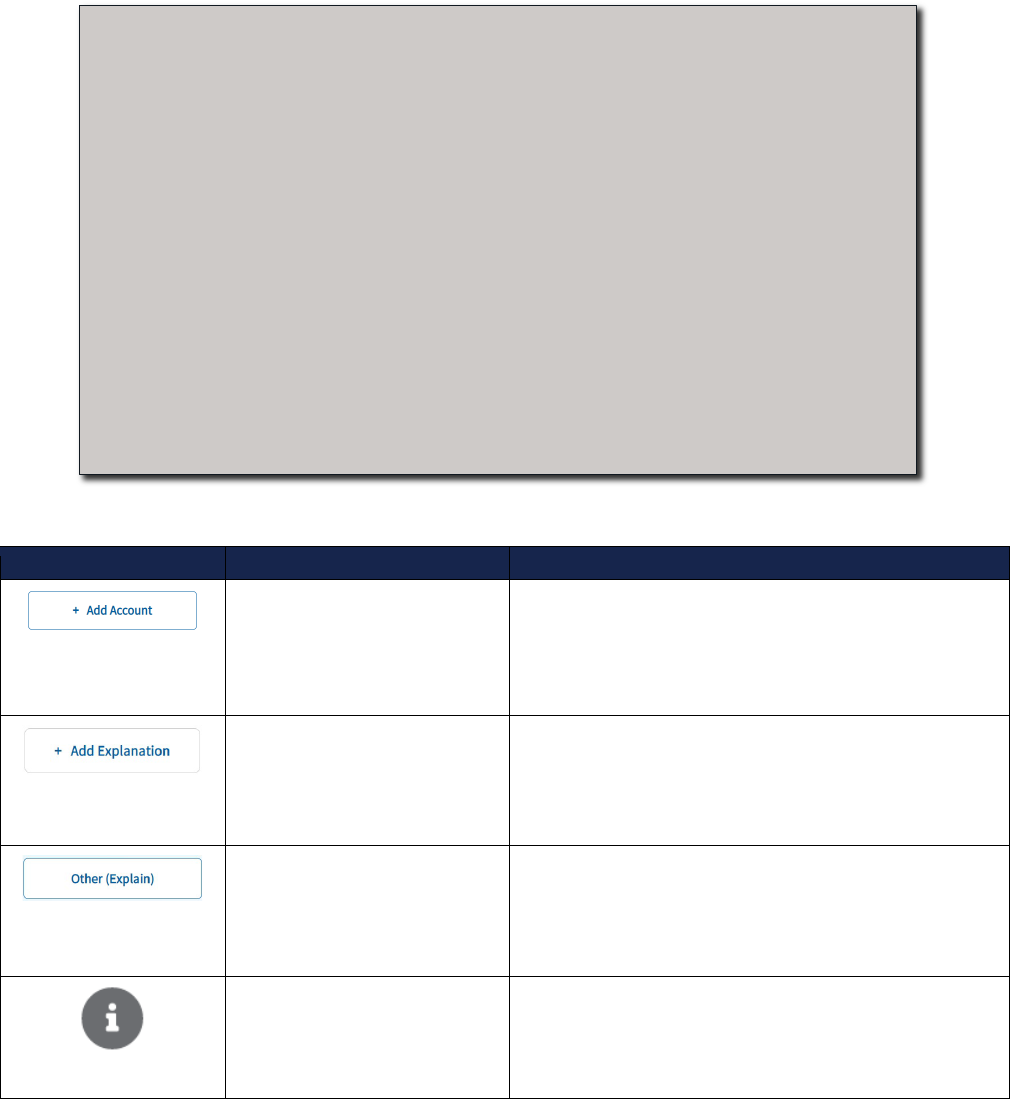
Rural Development Reporting & Compliance User Guide 29
Version 4, April 2024
Table 6: Image and description of Financial Report tools
Icon & Name
Screen Location
Function
[+ Add Account] button
Lefthand column on Non-
Operating Net Income
schedule
Allows users to enter the name of an account and add
it as a line item. The View link can be used to view the
account name. The Delete link can be used to delete
any accounts created during the current reporting
period.
[+Add Explanation]
button
Righthand column in all the
Financial Report schedules,
except Subscriber Data
Allows users to provide a description of a line item; an
explanation about the line item; or an explanation
when a warning is triggered. The Edit link can be used
to edit an explanation.
[Other (Explain)] button
Lefthand column on the
Statement of Cash Flows
schedule
Allows users to enter the name of an account and add
it as a line item.
Tooltip Icon
Below certain line items
Displays an informational text box when the user
moves the mouse over the icon
Data Entry Tips for the Financial Report
• Values must be entered as whole numbers for all schedules, except
Subscriber Data.
• Values containing special characters such as dollar signs, decimals (except for
the Subscriber Data schedule), or commas are not accepted.
• Values containing negative numbers must be entered with a hyphen before the
number (e.g., -10000).
• Values entered in the Subscriber Data schedule must be positive.
• The system will not allow any fillable fields to be blank. Enter a value in each
blank space, even if it is zero (0).
• Values must be corrected, or an explanation must be provided for line items
where a warning is triggered.
• Submit reports in chronological order as some data entered in previous
quarters will flow into the following quarter’s report.
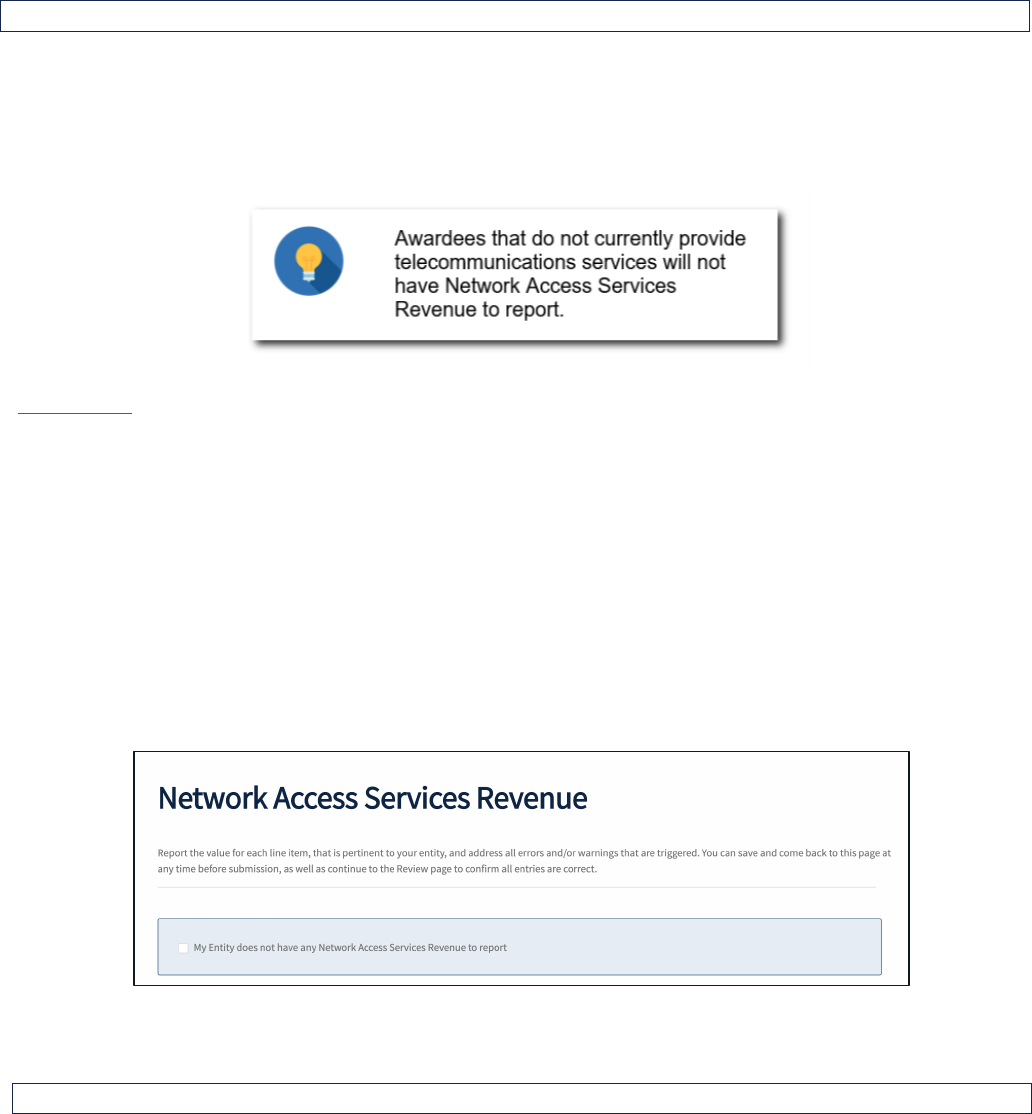
Rural Development Reporting & Compliance User Guide 30
Version 4, April 2024
3.2.1.1 Network Access Services Revenue
The Network Access Services Revenue schedule is used to report revenues derived from the
provision of exchange access services to an interexchange carrier or to an end user of
telecommunications services beyond the exchange carrier's network. If an entity is receiving revenues
directly assigned on the basis of telecommunications rate analyses and studies, then they likely have
Network Access Services Revenue to report.
Appendix C
provides information on each of the line items for the Network Access Services Revenue
schedule.
The “Total Network Access Services Revenue” line item auto-populates on the Income Statement
once this page is saved.
1. Click the Network Access Services Revenue link on the Current Reports tab. This takes you to the
Data Entry page.
2. Select the check box “My Entity does not have any Network Access Services Revenue to report”,
as shown in Figure 17 below, if the entity does not have any Network Access Services Revenue to
report for the current reporting period. If the entity has Network Access Services Revenue to report,
enter the amounts associated with the respective line items.
Figure 17: Financial Report, Network Access Services Revenue schedule – Nothing to Report
3. Click the [Save] button to save the data and stay on the page or click the [Save and Continue]
button to save the data and proceed to the “Review” page.
3.2.1.2 Non-Operating Net Income
The Non-Operating Net Income schedule gathers information on net income arising from transactions
or activities not related to the furnishing of telecommunications service. Included in this account are
receipts from investments, income from investments, and income from subsidiaries. The “Total Non-
Operating Net Income” line item auto-populates the “Non-Operating Net Income” line item on the
Income Statement once this page is saved.
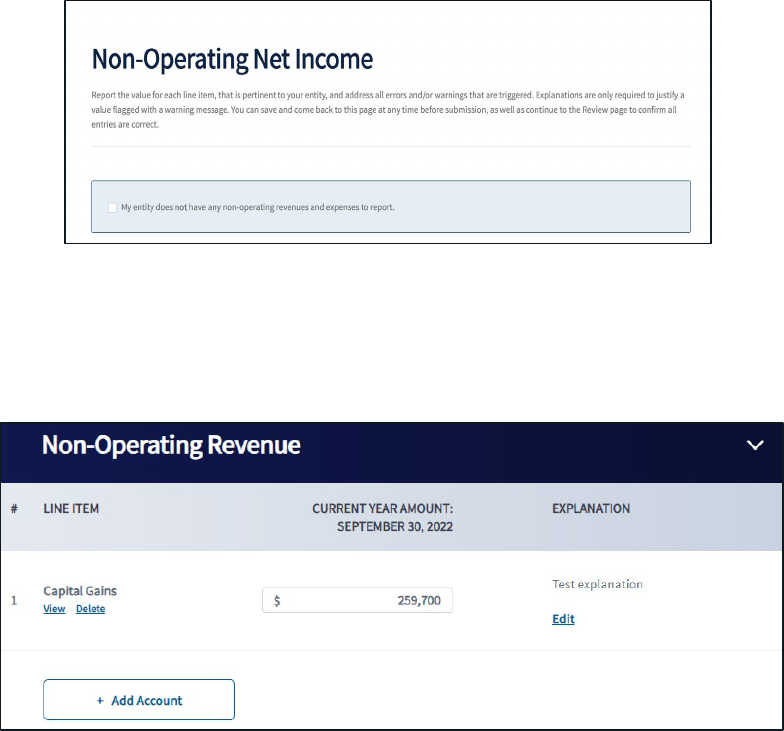
Rural Development Reporting & Compliance User Guide 31
Version 4, April 2024
1. Click the Non-Operating Net Income link on the Current Reports tab. This takes you to the Data
Entry page.
2. Select the check box “My entity does not have any non-operating revenues and expenses to
report.”, as shown in Figure 18 below, if the entity does not have any Non-Operating Net Income to
report for the current reporting period and proceed to Step (10). If the entity has Non-Operating Net
Income to report, continue to the next step.
Figure 18: Financial Report, Non-Operating Net Income schedule – Nothing to Report
3. Click the [right arrow] on the Non-Operating Revenue accordion as shown in Figure 19 below, to
display the line items. Enter the respective amounts for these accounts. If there is no amount to
report for a previously reported account, then enter a enter zero (0) and provide an explanation.
Figure 19: Non-Operating Net Income schedule, Non-Operating Revenue – Add Account Expanded
Accordion
4. To create a new account, click the [+ Add Account] button
5. An Add Account window displays, as shown in Figure 20 below.
NOTE: Non-Operating Revenue and Expense accounts added by users will begin to carry over from
one quarter to the next when the entity has a Financial Report that contains information for the same
period end date from the prior year.
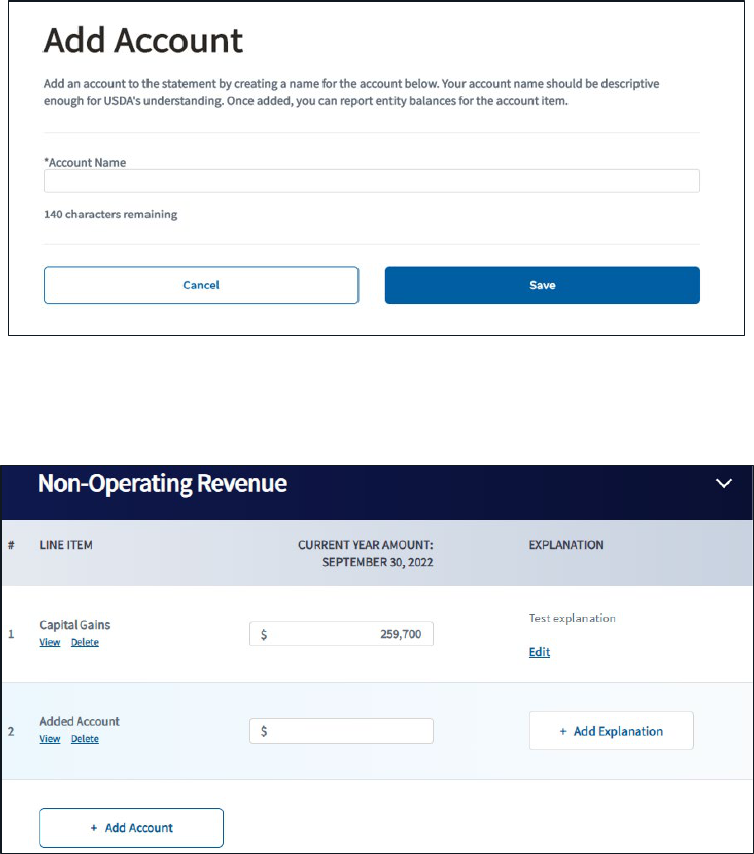
Rural Development Reporting & Compliance User Guide 32
Version 4, April 2024
Figure 20: Add Account Window, - Add a New Non-Operating Account Item
6. Enter the Account Name and click the [Save] button. The new account displays as a line item under
the Non-Operating Revenue section as shown in Figure 21 below.
Figure 21: Financial Report, Non-Operating Net Income schedule – New Line Item Added
7. Enter the amount for the new account.
8. Click the [+Add Explanation] button and enter a description for the new account and then click the
[Add] button.
• Click the Edit link to update the explanation.
• Click the Delete link to delete any accounts that were added for the current reporting period.
9. Repeat all the previous steps for the Non-Operating Expenses section.
10. Click the [Save] button to save the data and stay on the page or click the [Save and Continue]
button to save the data and proceed to the Review page.
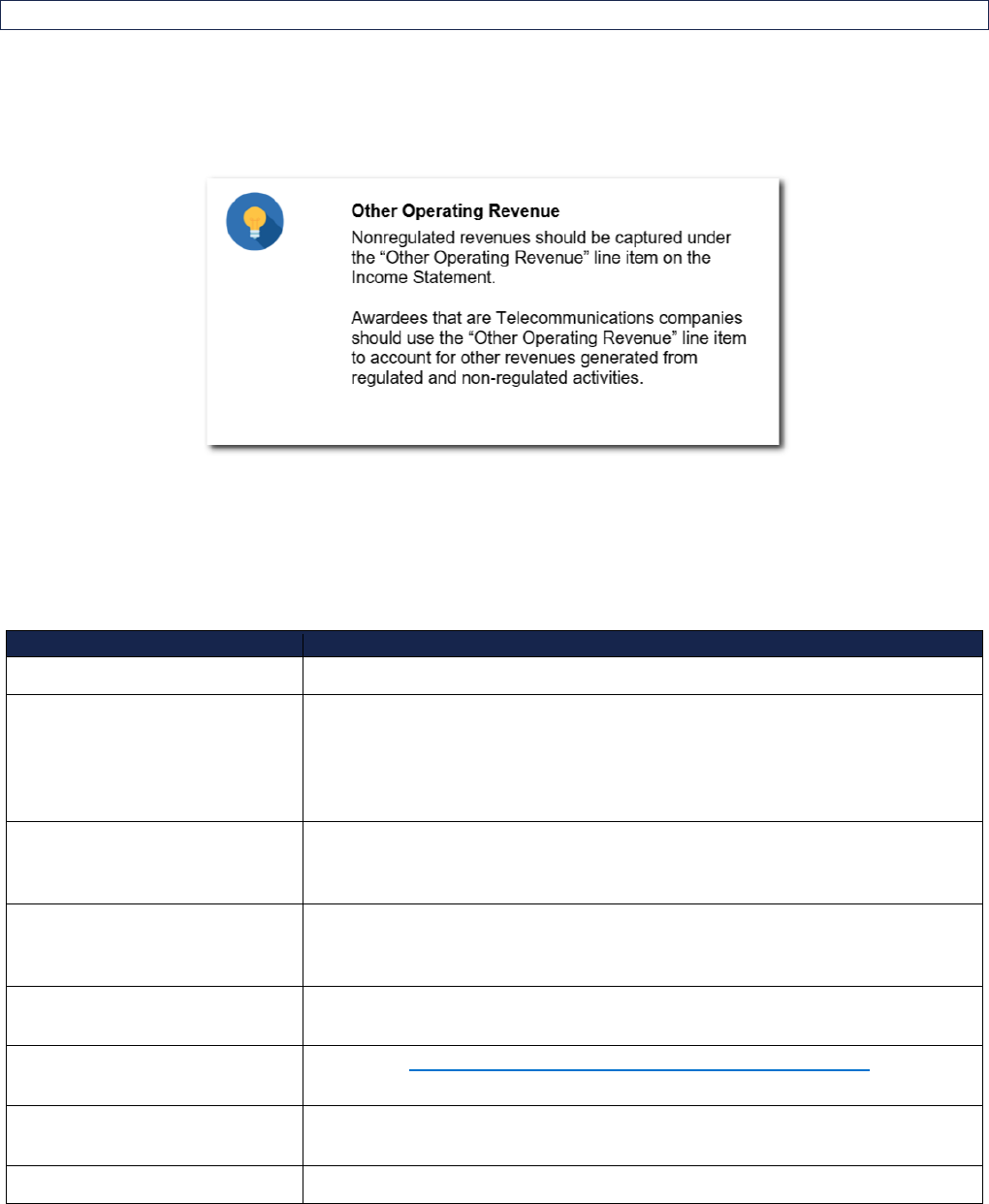
Rural Development Reporting & Compliance User Guide 33
Version 4, April 2024
3.2.1.3 Income Statement
The Income Statement is used to report the entity’s revenues, expenses, gains, and losses for the
current reporting period. If the auto-populated values from either the Non-Operating Net Income or the
Network Access Services Revenue schedules need to be updated, return to the respective
schedules, and update the values.
Some values on the Income Statement will dynamically update; however, the Income Statement
must be re-saved to reflect the updated values.
Table 7 Income Statement Line Item Descriptions
Income Statement Line Item
Description/Notes
Local Network Access Revenues
Revenues derived from the provision of voice, video, and data services.
Network Access Services
Revenue
Revenues derived from the provision of exchange access services to an
interexchange carrier or to an end user of telecommunications services
beyond the exchange carrier's network. Used by traditional/incumbent
telecommunications providers receiving USAC or state support. Data for this
line item auto-populates from the Network Access Revenues Schedule.
Long Distance Network Services
Revenue
Revenues derived from the provision of services beyond the basic service
area, whether message or flat-rate and including public network switching as
well as private.
Carrier Billing and Collection
Revenue
Revenue derived from the provision of billing and collection services (e.g.,
message recording, billing, collection, billing analysis, and billing information
services) to other telecommunications companies.
Other Operating Revenue
Include other revenues generated from regulated and non-regulated activities.
Provide a breakdown of items included in the account.
Amortized Grant Revenue
Please see Appendix D, Accounting Guidance for Grant Revenue, as different
types of organizations use different accounting treatments.
Uncollectible Revenue
Revenues that are not collectible. This item reduces revenue to account for
expected charge off of uncollectable receivables.
Net Operating Revenue
Calculated by the system

Rural Development Reporting & Compliance User Guide 34
Version 4, April 2024
Income Statement Line Item
Description/Notes
Plant Specific Operations
Expense
These expenses predominantly correspond with the telecommunications
plant-in-service assets (e.g., network support expense, general support
expense, central office switching and transmission expense, operator system
expense, information origination and termination expense, cable and wire
facilities expense, and other property, plant and equipment expense).
Plant Nonspecific Operations
Expense (Excluding
Depreciation & Amortization)
Include provisioning expenses, and network operations expenses.
Depreciation Expense
Depreciation expense associated with plant-in-service and capitalized costs.
Amortization Expense
Amortization of costs for capital leases and leasehold improvements,
intangibles, and plant adjustments.
Customer Operations and
Corporate Operations Expenses
The Customer Operations Expense accounts include the cost of performing
customer related marketing and customer services activities, including billing
and collection expenses. The Corporate Operations Expense accounts
include the costs of performing executive and planning activities and general
and administrative activities (including legal, accounting, and financial
services).
Other Operating Expense
Include the expenses corresponding to Other Operating Revenue and
expenses not includable elsewhere. Provide a breakdown of items included in
the account.
Total Operating Expenses
Calculated by the system.
Operating Income or Margins
Calculated by the system. Generally, this value should be greater than $0.
Provide an explanation if it is less than or equal to $0.
Non-Operating Net Income
Data for this line item auto-populates from the Non-Operating Net Income
Schedule. Generally, this value should be greater than $0. Provide an
explanation if it is less than or equal to $0.
Interest on Funded Debt (RUS,
RTB and FFB Notes)
Include the interest on all RUS funded debt.
Other Interest Expense
Include interest on all non-RUS funded debt and capital leases.
Interest on Line(s) of Credit
Include interest on all line(s) of credit.
Allowance for Funds Used
During Construction
Cost of financing the construction of plant. The amount of interest cost
capitalized in an accounting period should not exceed the total amount of
interest cost incurred by the company in that period.
Total Fixed Charges
Calculated by the system.
Taxes
Include federal, state, and local income taxes, and property taxes.
Extraordinary Items
Extraordinary items are events or transactions that are distinguished by both
their unusual nature and by the infrequency of their occurrence (e.g., losses
attributable to a natural disaster). Transactions can be positive (e.g., a gain)
or negative (e.g., losses attributable to a natural disaster).
Total Net Income or Margins
Calculated by the system. Generally, this value should be greater than $0.
Provide an explanation if it is less than or equal to $0.
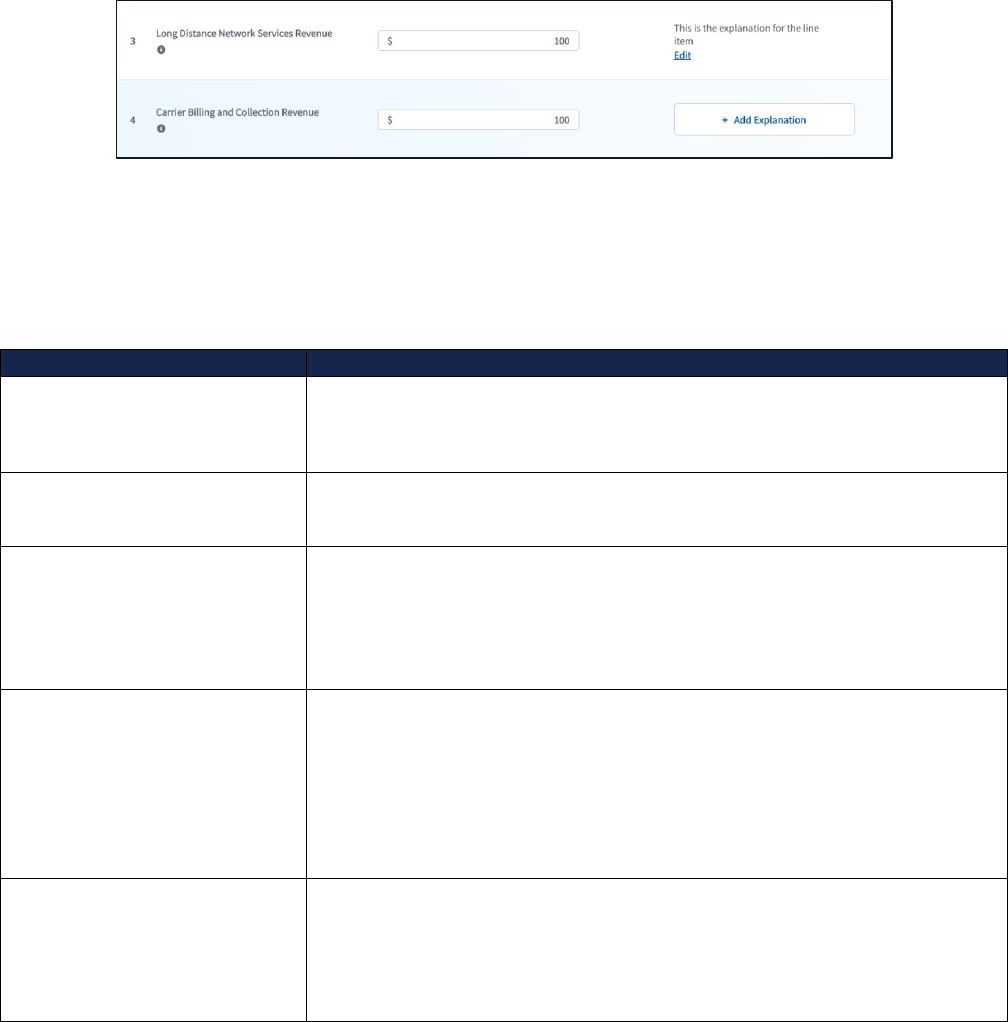
Rural Development Reporting & Compliance User Guide 35
Version 4, April 2024
1. Click the Income Statement link on the Current Reports tab. This navigates the user to the Data
Entry page.
2. Enter the amounts associated with the respective line items.
3. Enter an explanation for any line item as necessary; however, if a warning is triggered on a line
item, an explanation must be provided.
4. Click the [+Add Explanation] button as shown in Figure 22 below, enter an explanation and then
click the [Add] button. If you need to update the explanation, click the Edit link.
Figure 22: Financial Report, Income Statement page - Add Or Edit an Explanation
5. Click the [Save] button to save the data and stay on the page or click the [Save and Continue]
button to save the data and proceed to the Review page.
The Income Statement has six Financial Performance Metrics at the bottom of the statement. R&C
calculates these items. Table 8 below provides information on each metric.
Table 8: Income Statement Financial Performance Metrics
Metric
Definition
EBITDA (Earnings Before
Interest, Taxes, Depreciation &
Amortization)
An indicator of overall profitability of a business.
Summation of Total Net Income or Margins, Total Fixed Charges, Taxes,
Depreciation Expense, and Amortization Expense
EBIT (Earnings Before Interest
and Taxes)
Measures a company’s earning power from ongoing operations.
Summation of Total Net Income or Margins, Total Fixed Charges, and Taxes
TIER (Times Interest Earned
Ratio)
Measures a company’s ability to meet the interest payments on its debt and
capital lease obligations.
Total Net Income or Margins plus Total Fixed Charges
divided by
Total Fixed Charges
DSCR (Debt Service Coverage
Ratio)
Indicates the amount of a company’s earnings available for servicing debt,
including interest, principal, and lease payments.
(Total Net Income or Margins + Total Fixed Charges + Depreciation +
Amortization - Amortized Grant Revenue)
divided by
(Interest on Funded Debt + Other Interest + Interest on Line(s) of Credit +
Principal Payment on Debt and Capital Leases)
Network Access Services
Revenue/Net Operating
Revenues
Measures a company’s reliance on Network Access Services Revenue, as
compared to total net operating revenues.
Network Access Services Revenue
divided by
Net Operating Revenues
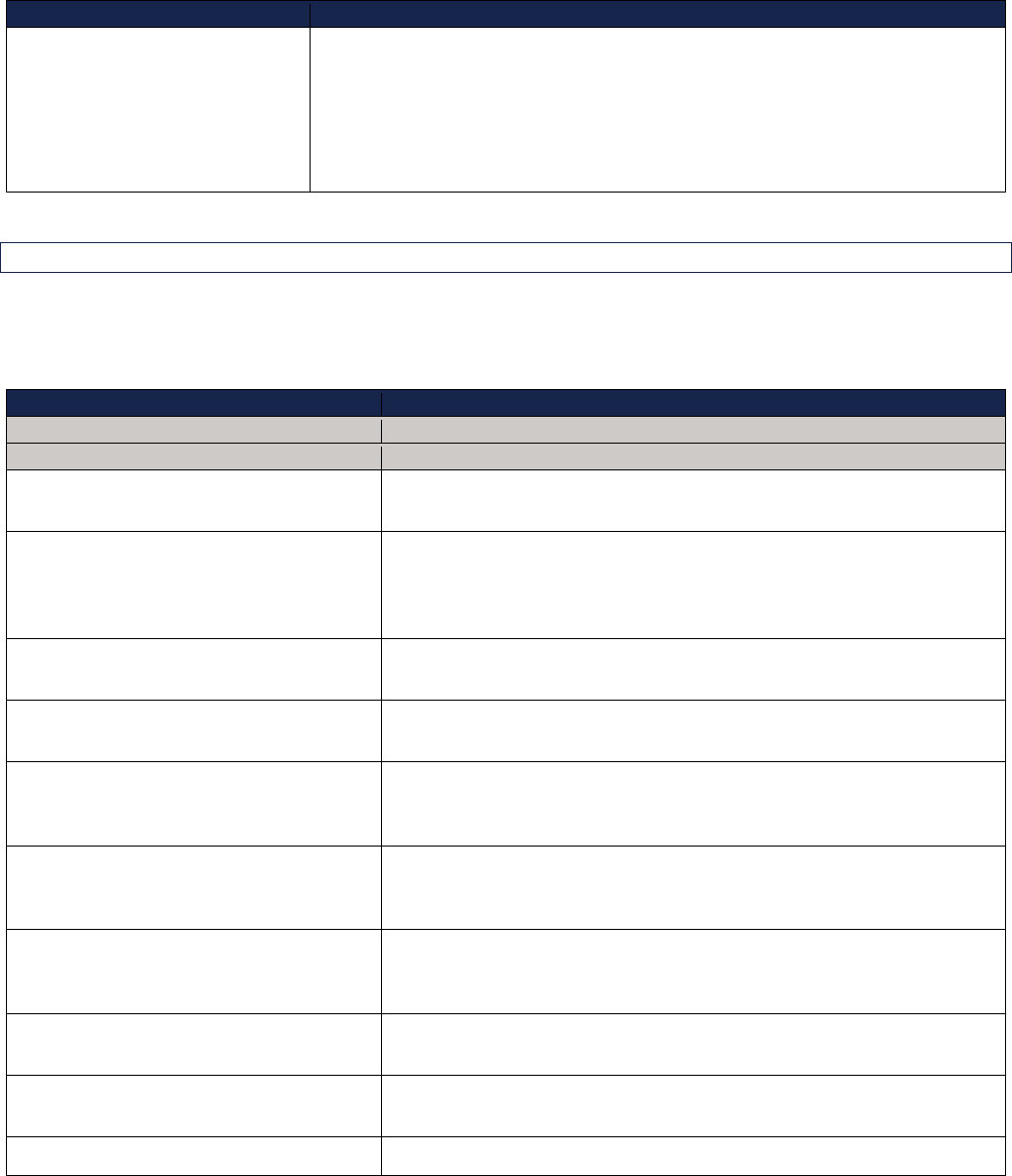
Rural Development Reporting & Compliance User Guide 36
Version 4, April 2024
Metric
Definition
Cash Flow from Operations/Total
Debt Service
Measures how much cash flow the company generated from its operating
activities as compared to its total debt service payments in a fiscal year.
(Net Cash Provided (Used) by Operations)
divided by
Interest on Funded Debt (RUS, RTB, FFB) plus Other Interest Expense and
Principal Payments on Long-Term Debt and Capital Leases
3.2.1.4 Balance Sheet
The Balance Sheet schedule is used to report the entity’s assets, liabilities, and shareholders’ equity
as of the end of the current reporting period.
Table 9: Balance Sheet Line Item Descriptions
Balance Sheet Line Item
Description/Notes
Assets
Current Assets
Cash & Equivalents
All unrestricted funds derived from revenues and other sources which
are available on demand, and other cash deposits of a special nature.
Cash-RUS Construction Fund
All loan funds received from RUS, the Rural Telephone Bank, the
Federal Financing Bank, CoBank, ACB, the Rural Telephone Finance
Cooperative, and all non-loan funds supplied under the terms of the
loan contract or otherwise required by RUS.
Accounts Receivable - Affiliates
Amounts due from affiliate customers for services rendered or billed
or for products sold.
Accounts Receivable - Non-Affiliates
Amounts due from non-affiliate customers for services rendered or
billed or for products sold.
Notes Receivable – Affiliates
Cost of demand or time notes due from affiliates evidencing money
receivable on demand or within a time not exceeding one year from
date of issue.
Notes Receivable - Non-Affiliates
Cost of demand or time notes due from non-affiliates evidencing
money receivable on demand or within a time not exceeding one year
from date of issue.
Interest and Dividends Receivable
Amount of interest accrued to the date of the balance sheet on
bonds, notes, and other commercial paper owned, on loans made,
and the amount of dividends receivable on stocks owned.
Materials and Inventory
Cost of materials and supplies held in stock including plant supplies,
motor vehicle supplies, tools, and fuel.
Other Current Assets
Amount of all current assets which are not includable above. Provide
a breakdown of items included in this line.
Total Current Assets
Calculated by the system.

Rural Development Reporting & Compliance User Guide 37
Version 4, April 2024
Non-Current Assets
Investment in Affiliated Companies -
Rural Development
Sum of investments in equity or other securities of affiliates for Rural
Development purposes only, and any advances to affiliates (for rural
development) not subject to current settlement. Please identify the
affiliate and the nature of the investment.
Investment in Affiliated Companies -
Non-Rural Development
Sum of investments in equity or other securities of affiliates for non-
Rural Development purposes. Also include any advances to affiliates
not subject to current settlement. Please identify the affiliate and the
nature of the investment.
Intangible Assets
The cost of non-plant related intangible assets.
Other Noncurrent Assets
Amount of all noncurrent assets which are not includable above.
Provide a breakdown of items included in this line.
Total Non-Current Assets
Calculated by the system.
Plant, Property and Equipment
Plant-in-Service
Sum of the book balances for cost of plant used to provide service,
including land, buildings, central office equipment, outside plant,
station equipment, furniture and office equipment, and vehicles and
work equipment.
Plant Under Construction
All costs incurred in the construction of plant performed under
contract, force account, or work orders. For forecast years, treat all
plant investments as additions to plant-in-service and enter zero on
this line.
Plant Adjustment, Nonoperating Plant &
Goodwill
Sum of: (A) Plant Adjustment: the difference between (1) the fair
market value of plant acquired, plus preliminary expenses incurred in
connection with the acquisition; and (2) the original cost of such plant,
less the amounts of reserve requirements for depreciation and
amortization of the property acquired; (B) Nonoperating plant: The
investment in regulated property not includable in the plant accounts
as operating plant; and (C) Goodwill: Any portion of the plant
purchase price that cannot be assigned to specifically identifiable
property acquired.
Less Accumulated Depreciation
Accumulated depreciation associated with the investment in Plant-in-
Service.
Net Plant
Calculated by the system.
Total Assets
Calculated by the system. Value must equal Total Liabilities and
Equity.
Liabilities & Equity
Current Assets
Accounts Payable – Affiliates
Amounts currently due to affiliated companies for recurring trade
obligations, and not provided for in other accounts. Please identify the
affiliate and the nature of the transaction(s).
Accounts Payable - Non-Affiliates
All amounts currently due to nonaffiliated companies for recurring
trade obligations, and not provided for in other accounts.

Rural Development Reporting & Compliance User Guide 38
Version 4, April 2024
Notes Payable – Affiliates
Face amount of affiliate notes and other evidence of indebtedness
issued or assumed by the company which are payable on demand or
not more than one year or less from date of issue. Please identify the
affiliate and the nature of the transaction(s).
Notes Payable – Non-Affiliates
Face amount of non-affiliate notes and other evidence of
indebtedness issued or assumed by the company which are payable
on demand or not more than one year or less from date of issue.
Current Maturities Long-Term Debt –
RUS, RTB, and FFB Notes
Current portion of long-term RUS, RTB, and FFB debt (matured and
unpaid).
Current Maturities Long-Term Debt –
Funded Debt – Other
Current portion of long-term non-RUS, non-RTB, and non-FFB debt
(matured and unpaid), made up of fixed-maturity types of borrowings
that are funded by interest payments. Examples would include
CoBank, ACB and RTFC debt and similar debt from other third party
institutions.
Current Maturities Long-Term Debt –
Rural Development Loan
Current portion of long-term debt issued under the USDA-RD Rural
Economic Development Loan & Grant Program (matured and
unpaid).
Current Maturities Other Long-Term Debt
Current portion of all other long-term debt (matured and unpaid)
which is not includable above.
Current Maturities – Capital Leases
Current portion of obligations applicable to property obtained under
capital leases.
Lines of Credit
Total amount of the balances outstanding, due and unpaid, for lines
of credit.
Other Current Liabilities
Amount of all current liabilities which are not includable above.
Provide a breakdown of items included in the account.
Total Current Liabilities
Calculated by the system.
Long-Term Debt
Funded Debt – RUS, RTB, and FFB
Notes
Total outstanding balances remaining unpaid, less current maturities,
of all unmatured RUS, RTB, and FFB mortgage notes
Less Unapplied Payments – Cushion of
Credit
Balance maintained with RUS in the Cushion of Credit Account.
Funded Debt – Other
Total outstanding balances remaining unpaid, less current maturities,
of non-RUS, non-RTB, and non-FFB debt that is made up of long-
term, fixed-maturity types of borrowings that are funded by interest
payments. Examples would include CoBank, ACB and RTFC debt
and similar debt from other third party institutions.
Funded Debt – Rural Development Loan
Total outstanding balances remaining unpaid, less current maturities,
of long-term debt issued under the USDA-RD Rural Economic
Development Loan & Grant Program
Obligations Under Capital Lease
Obligations, less current portion, applicable to property and
equipment obtained under capital leases.
Other Long-Term Debt
Total outstanding balances remaining unpaid, less current maturities,
of all other long-term debt not includable above.
Total Long Term Debt
Calculated by the system.
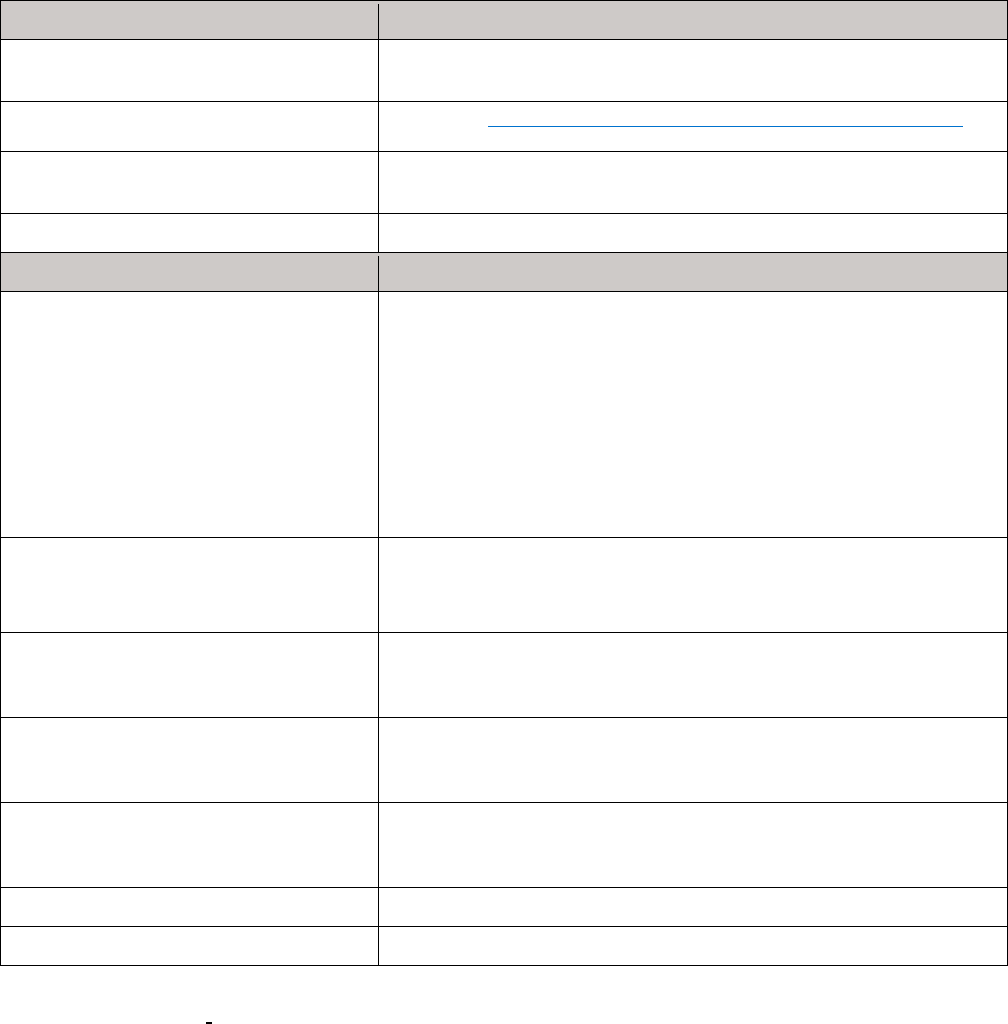
Rural Development Reporting & Compliance User Guide 39
Version 4, April 2024
Other Liabilities and Deferred Credits
Other Long-Term Liabilities and Deferred
Credits
Include total long-term liabilities and deferred credits not includable
above. Provide a breakdown of items included in this line.
Deferred Grant Revenue
Please see Appendix D, Accounting Guidance for Grant Revenue, as
different types of organizations use different accounting treatments.
Total Other Liabilities and Deferred
Credits
Calculated by the system.
Total Liabilities
Calculated by the system.
Equity
Capital Stock Outstanding & Subscribed
The par value, stated amount, or in the case of no-par stock, the
amount received for capital stock issued and outstanding; the par
value of capital stock for which legally enforceable subscriptions have
been received but for which, at the date of the balance sheet, stock
certificates have not been issued; and the amount of installments
paid on capital stock on a partial or installment payment plan by
subscribers against whom there is no legally enforceable subscription
contract, and who are entitled to be reimbursed the principal amount
of their payments, with or without interest, in the event they fail to
complete payment for the stock and receive certificates therefore.
Additional Paid-in-Capital
The difference between the net proceeds received from the issuance
of capital stock and the par value of capital stock (unless such
difference results in a debit balance for that class of stock, in which
case the amount shall be charged to Retained Earnings).
Membership & Capital Certificates
The face amount of: memberships subscribed but not issued;
members' equity certificates subscribed but not issued; membership
certificates outstanding; and members' equity certificates outstanding.
Patronage Capital Credits
Include all amounts transferred from operating margins, nonoperating
margins, and other margin accounts which are assignable to
individual patrons.
Retained Earnings or Margins
Include the undistributed balance of retained earnings derived from
the operations of the company and from all other transactions not
includable in the other equity accounts.
Total Equity
Calculated by the system.
Total Liabilities and Equity
Calculated by the system. Must equal Total Assets
1. Click the Balance Sheet link on the Current Reports tab. This takes you to the Data Entry page.
2. Click the [right arrow] of each accordion, as shown in Figure 23 below, to display the line items.

Rural Development Reporting & Compliance User Guide 40
Version 4, April 2024
Figure 23: Financial Report, Balance Sheet Schedule - Sections
3. Enter the amounts associated with the respective line items.
4. Enter an explanation for any line item as necessary; however, if a warning is triggered on a line
item, an explanation must be provided.
5. Click the [+Add Explanation] button, enter an explanation and then click the [Add] button. If the
explanation needs to be updated, click the Edit link.
6. Click the [Save] button to save the data and stay on the page or click the [Save and Continue]
button to save the data and proceed to the Review page.
The Balance Sheet has eight Financial Performance Metrics at the bottom of the statement. R&C
calculates these items. Table 10 below provides information on each metric.
Table 10: Balance Sheet Financial Performance Metrics
Metric
Definition
Total Equity/Total Assets
Measures the amount of assets that are financed by owners’ investments and
not leveraged.
Current Ratio
Measures how much liquidity is available to pay obligations due within one
year.
Total Current Assets
divided by
Total Current Liabilities
Quick Ratio
Measures how well the applicant can meet its short-term financial liabilities.
(Total Current Assets minus Materials and Inventory)
divided by
Total Current Liabilities
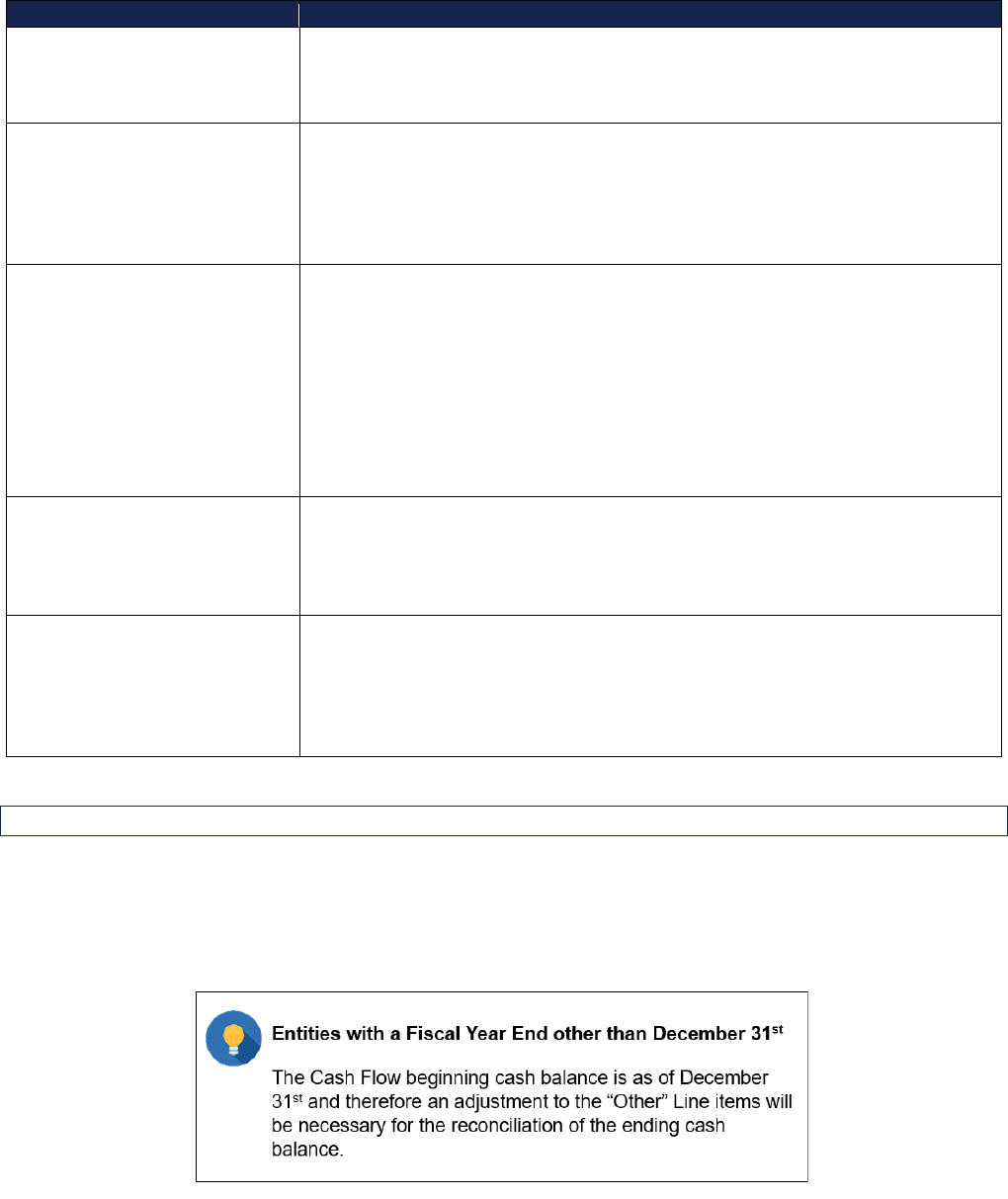
Rural Development Reporting & Compliance User Guide 41
Version 4, April 2024
Metric
Definition
Working Capital in Dollars
Similar to the Current Ratio, measures the ability to pay current liabilities with
current assets.
Total Current Assets minus Total Current Liabilities
Total Liabilities/Total Equity
Measures how much debt the applicant is using to finance its assets relative to
the amount of value represented in shareholders’ equity.
Total Liabilities
divided by
Total Equity
Net Plant/Long Term Debt
Measures the extent to which long-term debt is covered by net plant.
Net Plant
divided by
(Current Maturities-Long Term Debt - RUS, RTB, FFB Notes plus Current
Maturities-Long Term Debt - Funded Debt - Other, Current Maturities-Long
Term Debt - Rural Development Loan, Current Maturities - Capital Leases,
Funded Debt - RUS, RTB, FFB Notes, Funded Debt - Other, Funded Debt -
Rural Development Loan, Obligations Under Capital Lease, and Other Long-
Term Debt)
Tangible Equity
A measure of a company’s tangible capital; used in evaluating potential losses
by eliminating intangible assets, goodwill and preferred stock from total equity.
Total Assets minus Intangible Assets, Plant Adjustment, Nonoperating Plant &
Goodwill, and Total Liabilities
Tangible Equity/Total Assets
The tangible percentage of a company’s assets that are owned by investors
and not leveraged.
Tangible Equity
divided by
Total Assets
3.2.1.5 Statement of Cash Flows
The Statement of Cash Flows schedule is used to report the change in the Balance Sheet accounts
and Income Statement as of the current calendar year that affect cash & cash equivalents under three
different activity types: operations, financing, and investing. The Statement of Cash Flows will not
generate until the entity has submitted the Quarter 4 Financial Report for the previous year.
If the auto-populated values from either the Income Statement or the Balance Sheet need to be
updated, return to the respective schedules and update the values. The values on the Statement of

Rural Development Reporting & Compliance User Guide 42
Version 4, April 2024
Cash Flows dynamically update; however, the Statement of Cash Flows must be re-saved to reflect
the updated values.
See Appendix E, Example of Reconciled Statement of Cash Flows
for a demonstration of how the
Statement of Cash Flows uses information from the Income Statement and Balance Sheet.
Table 11: Line Items and Descriptions on the Statement of Cash Flows
NOTES:
1. References in this table to PRIOR YEAR mean the amount as of the end of the previous calendar
year.
2. References in this table to END OF PERIOD mean the current year-to-date amount for the quarterly
report being submitted.
Statement of Cash Flows Line Item
Description/Notes
Cash & Cash Equivalents Beginning
of Period
Beginning Cash (Cash & Equivalents
plus RUS Const. Fund)
Calculated by the system. Prior year, calendar year-end, cash balance.
Cash Flows from Operating
Activities
Net Income (Loss)
Current year, current period's Net Income from Income Statement
Adjustments to Reconcile Net
Income (Loss) to Net Cash Provided
By Operating Activities
Add: Depreciation Expense
Current year, current period's depreciation from Income Statement
Add: Amortization Expense
Current year, current period's Amortization from Income Statement
Other (Explain)
Use the button to add additional items not covered by other lines in this
portion of the Statement of Cash Flows. Add additional lines one at a
time and provide an explanation for each line added.
Changes in Operating Assets and
Liabilities
Decrease/(Increase) in Accounts
Receivable
Calculated by the system. (PRIOR YEAR, CALENDAR YEAR-END
Accounts Receivable: Affiliates + Accounts Receivable: Nonaffiliates) -
(END OF PERIOD Accounts Receivable: Affiliates + Accounts
Receivable: Nonaffiliates)
Decrease/(Increase) in Materials &
Inventory
Calculated by the system. (PRIOR YEAR Materials and Inventory) -
(END OF PERIOD Materials and Inventory)
Decrease/(Increase) in Other Current
Assets, Interest, and Dividends
Receivable
Calculated by the system. (PRIOR YEAR, CALENDAR YEAR-END
Interest and Dividends Receivable + Other Current Assets) - (END OF
PERIOD Interest and Dividends Receivable + Other Current Assets)
Increase/(Decrease) in Accounts
Payable
Calculated by the system. ((PRIOR YEAR Accounts Payable: Affiliates
+ Accounts Payable: Non-affiliates) - (END OF PERIOD Accounts
Payable: Affiliates + Accounts Payable: Non-affiliates))
Increase/(Decrease) in Other Current
Liabilities
Calculated by the system. (PRIOR YEAR, CALENDAR YEAR-END
Current Liabilities - END OF PERIOD Current Liabilities)
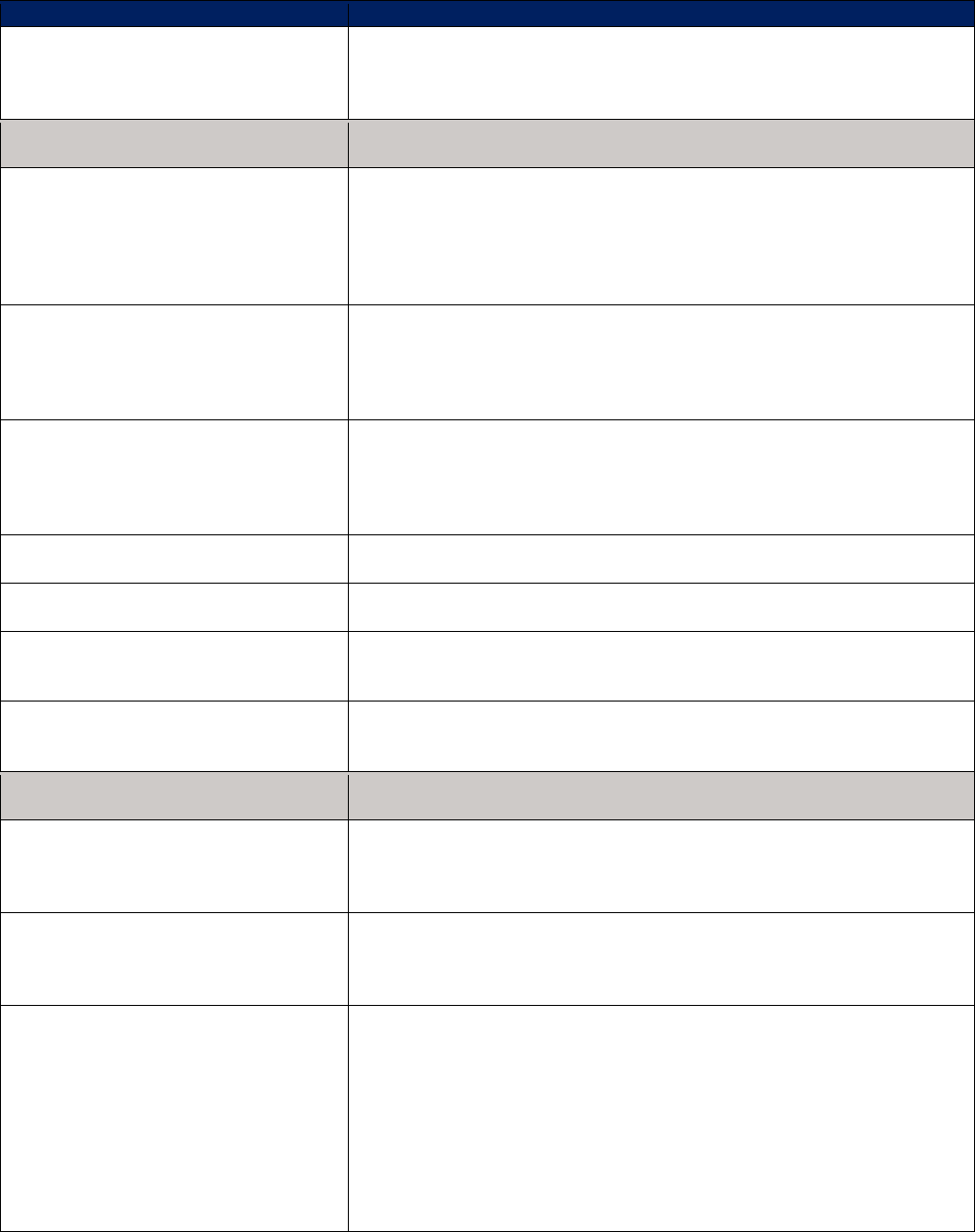
Rural Development Reporting & Compliance User Guide 43
Version 4, April 2024
Statement of Cash Flows Line Item
Description/Notes
Net Cash Provided/(Used) by
Operations
Calculated by the system. Summation of: Net Income (Loss),
Depreciation, Amortization, Other, Accounts Receivable, Materials &
Inventory, Other Current Assets, Interest, and Dividends Receivable,
Accounts Payable, and Other Current Liabilities
Cash Flows from Investing
Activities
Capital Expenditures (excluding plant
constructed using grant proceeds)
Include the amount a company has spent on the acquisition,
construction, upgrade, or maintenance of its property, plant, and
equipment during the reporting period by using RUS loan funds, prior
RUS Telecom loan funds, and non-loan funds. This value should
always be a negative number and should reflect year-to-date
expenditures.
Plant Constructed Using Grant
Proceeds
Include the amount a company has spent on the acquisition,
construction, upgrade, or maintenance of its property, plant, and
equipment during the reporting period by using grant funds. This value
should always be a negative number and should reflect year-to-date
expenditures.
Other Long-Term Investments
Calculated by the system. ((PRIOR YEAR, CALENDAR YEAR-END
Investment in Affiliated Companies: Rural Development + Investment in
Affiliated Companies: Non- Rural Development) - (END OF PERIOD
Investment in Affiliated Companies: Rural Development + Investment in
Affiliated Companies: Non- Rural Development))
Intangible Assets
Calculated by the system. (PRIOR YEAR, CALENDAR YEAR-END
Intangible Assets - END OF PERIOD Intangible Assets)
Other Noncurrent Assets
Calculated by the system. (PRIOR YEAR, CALENDAR YEAR-END
Other Noncurrent Assets - END OF PERIOD Other Noncurrent Assets)
Other (Explain)
Use the button to add additional items not covered by other lines in this
portion of the Statement of Cash Flows. Add additional lines one at a
time and provide an explanation for each line added.
Net Cash Provided/(Used) by Investing
Activities
Calculated by the system. Summation of: Capital Expenditures
(excluding plant constructed using grant proceeds), Other Long Term
Investments, Intangible Assets, Other Noncurrent Assets, and Other.
Cash Flows From Financing
Activities
Decrease/(Increase) in Notes
Receivable
Calculated by the system. (PRIOR YEAR, CALENDAR YEAR-END
Notes Receivable: Affiliates + Notes Receivable Non-affiliates) - (END
OF PERIOD Notes Receivable: Affiliates + Notes Receivable Non-
affiliates)
Increase/(Decrease) in Notes Payable
& Lines of Credit
Calculated by the system. ((PRIOR YEAR, CALENDAR YEAR-END
Notes Payable: Affiliates + Notes Payable: Non-affiliates + Lines of
Credit) - (END OF PERIOD Notes Payable: Affiliates + Notes Payable:
Non-affiliates + Lines of Credit))
Net Increase/(Decrease) in Long Term
Debt (Including Current Maturities)
Calculated by the system. ((PRIOR YEAR, CALENDAR YEAR-END
Current Maturities: RUS, RTB and FFB Notes + Current Maturities
Long-Term Debt: Other + Current Maturities Long-Term Debt: Rural
Development + Current Maturities Other Long-Term Debt + Current
Maturities: Capital Leases + Funded Debt: RUS, RTB and FFB Notes +
Funded Debt: Other + Funded Debt: Rural Development Loan +
Obligations Under Capital Lease + Other Long-Term Debt) - (END OF
PERIOD Current Maturities: RUS, RTB and FFB Notes + Current
Maturities Long-Term Debt: Other + Current Maturities Long-Term
Debt: Rural Development + Current Maturities Other Long-Term Debt +
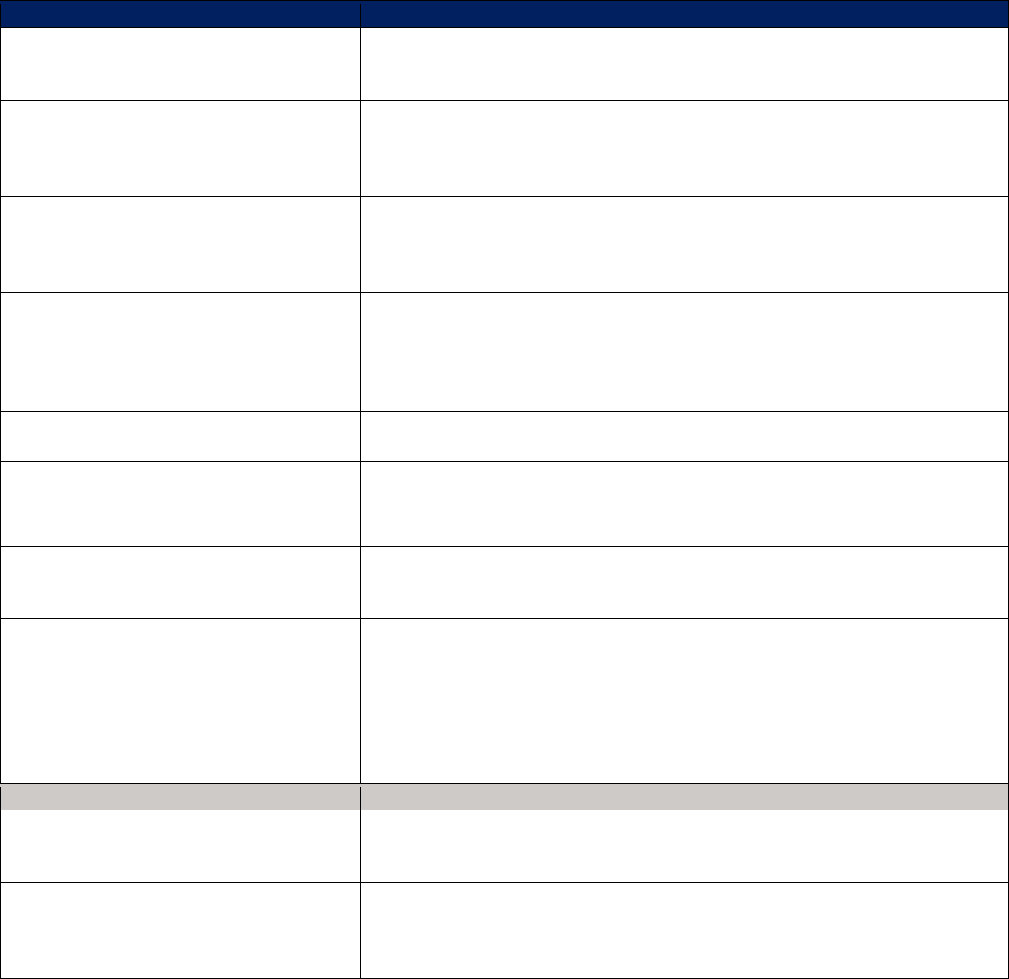
Rural Development Reporting & Compliance User Guide 44
Version 4, April 2024
Statement of Cash Flows Line Item
Description/Notes
Current Maturities: Capital Leases + Funded Debt: RUS, RTB and FFB
Notes + Funded Debt: Other + Funded Debt: Rural Development Loan
+ Obligations Under Capital Lease + Other Long-Term Debt))
Decrease/(Increase) in Unapplied
Payments – Cushion of Credit
Calculated by the system. (PRIOR YEAR, CALENDAR YEAR-END
Balance Sheet Line Less Unapplied Payments: Cushion of Credit) -
(END OF PERIOD Balance Sheet Line Less Unapplied Payments:
Cushion of Credit)
Increase/(Decrease) in Other Liabilities
& Deferred Credits
Calculated by the system. (PRIOR YEAR, CALENDAR YEAR-END
Balance Sheet Line Other Long-Term Liabilities & Deferred Credits) -
(END OF PERIOD Balance Sheet Line Other Long-Term Liabilities &
Deferred Credits)
Increase/(Decrease) in Capital Stock,
Paid-in-Capital, Membership and
Capital Certificates & Other Capital
Calculated by the system. (PRIOR YEAR, CALENDAR YEAR-END
Cap. Stock Outstanding & Subscribed + Additional Paid In-Capital +
Membership & Cap. Certificates) - (END OF PERIOD Cap. Stock
Outstanding & Subscribed + Additional Paid In-Capital + Membership &
Cap. Certificates)
Proceeds from Grant Funds
Proceeds from grant funds (perhaps from RUS, other Federal, and
state sources). Provide a breakdown of all grant sources for this item.
Less: Distributions (Payment of
Dividends, Patronage Capital Credits
Retired, or any other Distribution)
Must be in the accordance with the funding program’s requirements.
Other (Explain)
Use the button to add additional items not covered by other lines in this
portion of the Statement of Cash Flows. Add additional lines one at a
time and provide an explanation for each line added.
Net Cash Provided/(Used) by
Financing Activities
Calculated by the system. Summation of: Notes Receivable, Notes
Payable & Lines of Credit, Long-Term Debt (Including Current
Maturities), Unapplied Payments - Cushion of Credit, Other Liabilities &
Deferred Credits, Capital Stock, Paid-In-Capital, Membership and
Capital Certificates & Other Capital, Proceeds from Grant Funds,
Distributions (Payment of Dividends, Patronage Capital Credits Retired,
or any other Distribution), and Other
Totals
Net Increase/(Decrease) in Cash
Calculated by the system. Summation of: Net Cash Provided/(Used) by
Operations, Net Cash Provided/(Used) by Investing Activities, and Net
Cash Provided/(Used) by Financing Activities
Ending Cash
Calculated by the system. Summation of: Beginning Cash (Cash &
Equivalents plus RUS Constr. Fund), and Net Increase/(Decrease) in
Cash. Value must equal Cash & Cash Equivalents plus RUS
Construction Fund
1. Click the Statement of Cash Flows link on the Current Reports tab. This takes you to the Data
Entry page.
2. Click the [right arrow] of each accordion, as shown in Figure 24 below, to display the line items.
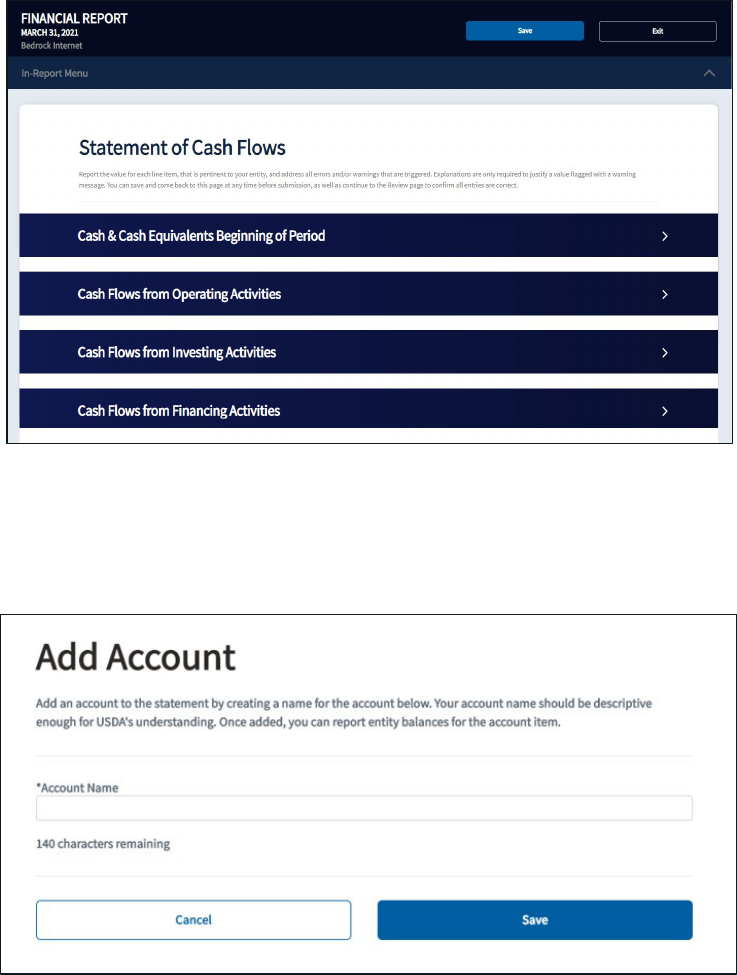
Rural Development Reporting & Compliance User Guide 45
Version 4, April 2024
Figure 24: Financial Report, Statement of Cash Flow Schedule – Expanded Accordion
3. Enter the amounts associated with the respective line items.
4. Click on the [Other (Explain)] button to add any new items.
5. An Add Account window displays as shown in Figure 25 below.
Figure 25: Add Statement of Cash Flows Account Item
6. Enter the Account Name and click the [Save] button. The new account will display as a line item on
the Statement of Cash Flows. Click the Delete link to delete any new accounts added during the
current reporting period.
7. Click the [+Add Explanation] button and enter a description for the new account and then click the
[Add] button. If the explanation needs to be updated, click the Edit link.
8. Click the [Save] button to save the data and stay on the page or click the [Save and Continue]
button to save the data and proceed to the Review page.
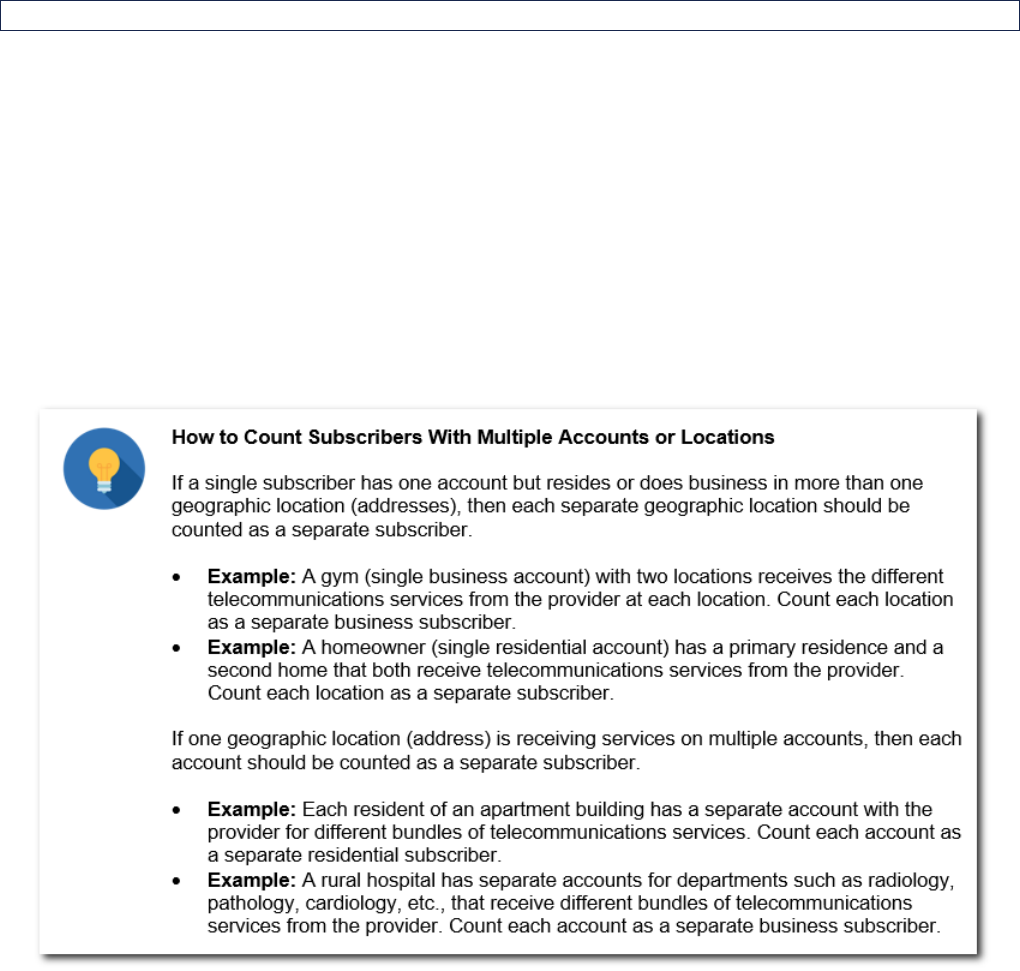
Rural Development Reporting & Compliance User Guide 46
Version 4, April 2024
3.2.1.6 Subscriber Data
The Subscriber Data schedule is used to report the number of subscribers to whom an entity is
providing service during the current reporting period. This report consists of three separate sections:
“Residential & Business Subscribers – All Services”, “Residential & Business Subscribers – Broadband
Service”, and “My Entity’s Most Subscribed Data Offering Type”. For purposes of reporting the data on
this report schedule, a subscriber is defined the following ways:
• When reporting Residential & Business Subscribers – All Services, a Subscriber is any
customer that receives data, voice, or video service, either exclusively or in a bundled package. A
customer that is receiving bundled services should be counted as a single Subscriber.
• When reporting Residential & Business Subscribers – Broadband Service, Broadband
Subscriber means any customer that receives fixed, terrestrial service as defined in the latest
federal register notice for the respective financial assistance program, under which, the submitted
project was approved, either exclusively, or as a bundled package with other services.
1. Click the Subscriber Data link on the Current Reports tab. This takes you to the Data Entry page.
2. Select the radio button that best matches the entity’s network status and subscribers, as shown is
Figure 26 below.
• If the first radio button, “My Entity has an existing network; therefore, it has subscribers
(including data) to report at the end of this reporting period.”, is selected, complete all
three sections.
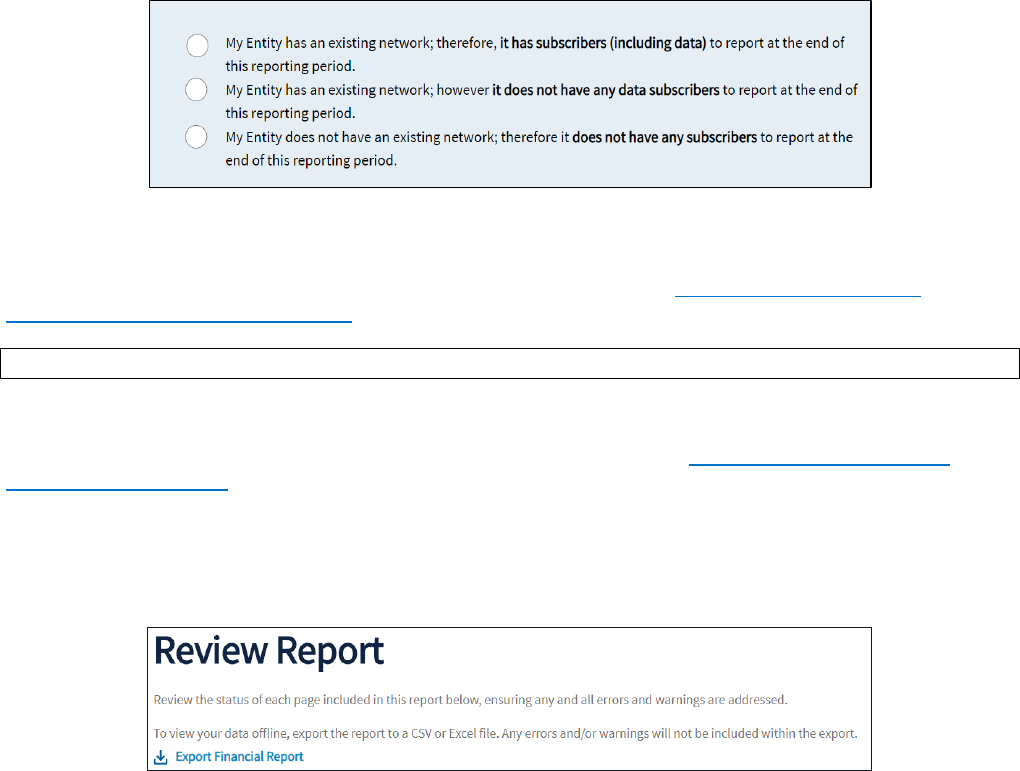
Rural Development Reporting & Compliance User Guide 47
Version 4, April 2024
• If the second radio button, “My Entity has an existing network; however, it does not have
any data subscribers to report at the end of this reporting period.”, is selected, complete
only the first section.
• If the third radio button, “My Entity does not have an existing network; therefore, it does
not have any subscribers to report at the end of this reporting period.”, is selected, none
of the sections need to be completed.
Figure 26: Financial Report, Subscriber Data Schedule – Entity’s Network and Subscriber Status Options
3. Click the [Save] button to save the data and stay on the page or click the [Save and Continue]
button to save the data and proceed to the Review page.
To review, certify, and submit the Financial Report to USDA, refer to
Certifying and Submitting
Financial and System Data Reports.
3.2.2 Export Financial Report
The Financial Report is the only R&C Report that can be exported to an Excel or csv file. Only the
financial data is exported; no errors or warnings are exported. All reports submitted after October 26,
2022, are available to be viewed and downloaded in PDF format. See
Appendix G: Generate and
Export Reports to PDF for more information.
1. Select the specific Financial Report to export and navigate to the Review Report page.
2. Click on the Export Financial Report link as shown in Figure 27 below.
Figure 27: Financial Report, Export Financial Report Link
3. The Financial Report export displays, as shown in Figure 28 below.
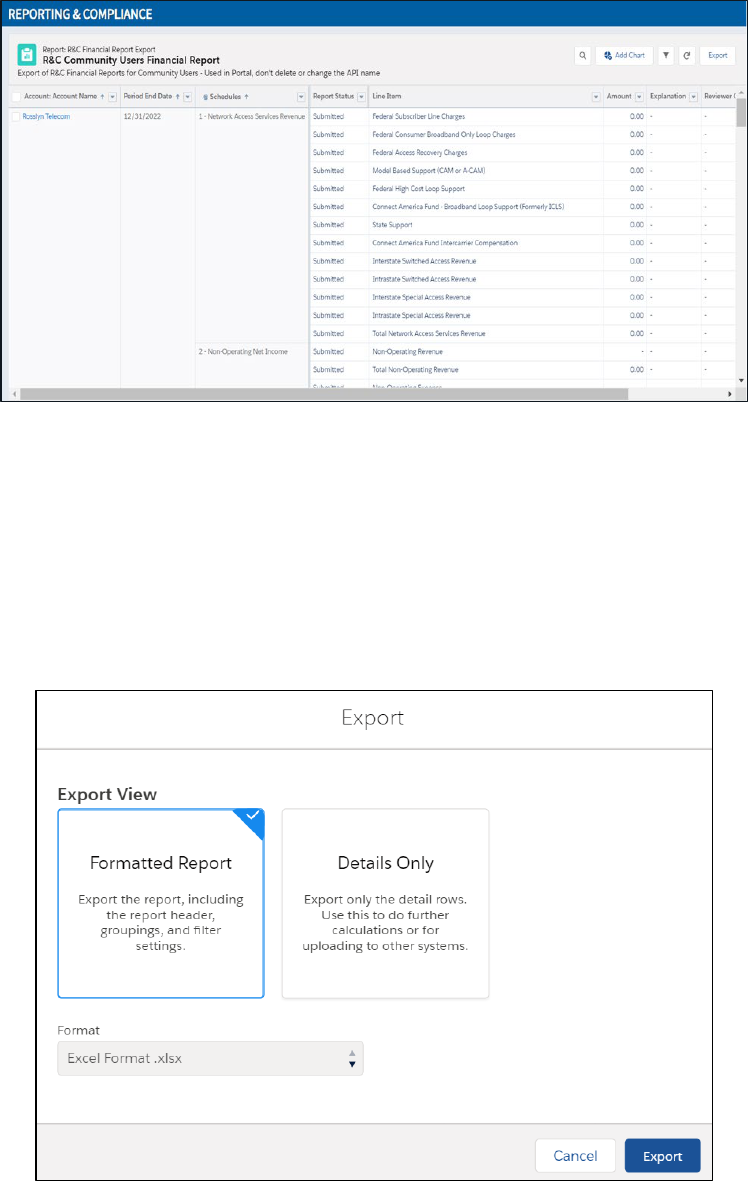
Rural Development Reporting & Compliance User Guide 48
Version 4, April 2024
Figure 28: R&C-generated, Financial Report Export
4. Click the [Export] button on the top right corner to export the financial report. An Export window
displays, as shown in Figure 29 below.
5. Users can choose to export as a Formatted Report or as Details Only.
• The Formatted Report provides the report header, filters and groupings.
• The Details Only reports provide unformatted data organized in rows and columns. If a user
chooses Details Only, they can choose the format: either .XLS or .CSV (there is also an option
to change the encoding if needed).
Figure 29: Financial Report, Export Window, Export Options
6. Select the desired Export View and Format.

Rural Development Reporting & Compliance User Guide 49
Version 4, April 2024
7. Click the [Export] button to export the report and save it in the desired location.
8. Click the Back Arrow icon on the browser menu to return to the Review Report page.
3.2.3 System Data Report
The System Data Report is an account-level report that collects specific data for the entity. This report
consists of three schedules and each schedule includes a Data Entry page and a Review page. The
three report schedules are as follows:
• Network Data
• Capital Investment Data
• Depreciation Rates
Data appears in the System Data Report the following ways: auto-populated from a previous System
Data Report, calculated by the R&C, or entered manually by the user.
Please complete reports in chronological order as data from previous reports flow into the coinciding
reports.
3.2.3.1 Network Data
The Network Data schedule is used to report the network data for the entity based on the type of
network. This schedule consists of four radio buttons and two separate sections. The two sections are
Wireline Network and Wireless Network.
1. Click the Network Data link on the Current Report tab. This takes you to the Data Entry page.
2. Select the radio button that best matches the entity’s network status as shown is Figure 30 below.
• If the first radio button, “My Entity has an existing wireline and wireless network.” is
selected, both the Wireline Network and the Wireless Network sections must be completed.
• If the second radio button, “My Entity has an existing wireline network.”, or the third radio
button, “My Entity has an existing wireless network.” is selected, only the applicable section
needs to be completed.
• If the fourth radio button, “My Entity does not have an existing network.”, is selected, neither of
the two sections need to be completed.
Routes
• A route is where copper, fiber, and/or coaxial facilities currently exist or will be installed.
Middle mile and last mile routes should be included in route mile calculations.
• When including Route Miles, include the total wireline route miles for the entire company.
• Route Miles (Modified) include fiber route miles that have replaced older facilities.
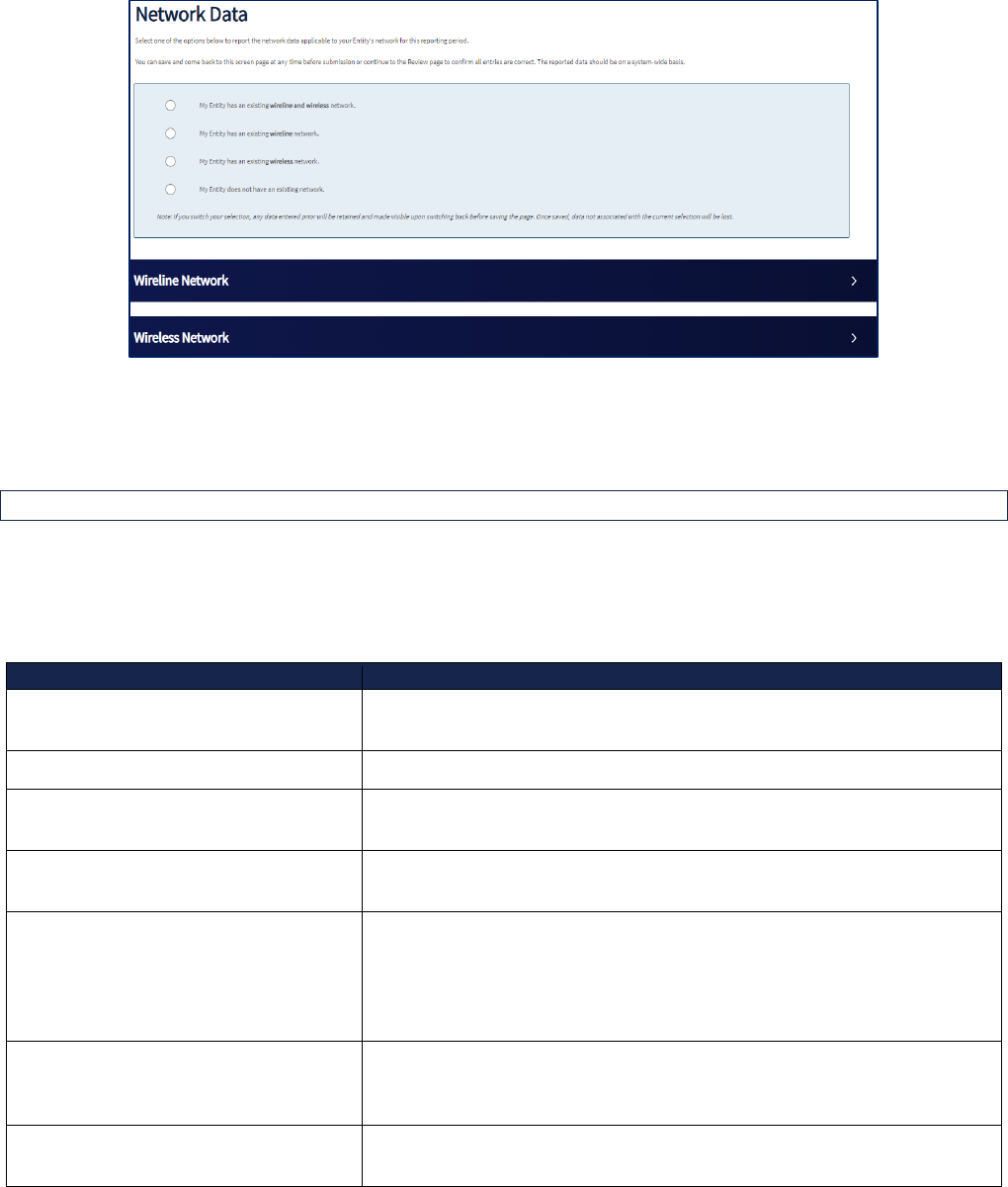
Rural Development Reporting & Compliance User Guide 50
Version 4, April 2024
Figure 30: System Data Report, Network Data schedule - Entity’s Network Status Options
3. Click the [Save] button to save the data and stay on the page or click the [Save and] button to save
the data and proceed to the Review page.
3.2.3.2 Capital Investment Data
The Capital Investment Data schedule is used to report the entity’s money that is invested in or spent
on assets during the current reporting period. Table 12 below provides the Capital Investment Data
Line Items along with their descriptions.
Table 12: Capital Investment Data Line Items
Line Item
Description
RUS, RTB, and FFB Loans
The total amount of RUS, RTB, and FFB loan funds expended during
the year.
RUS Grants
The total amount of RUS Grant funds expended during the year.
Other Long-Term Loan Funds
The total amount of all other Long-Term loan funds expended during
the year.
Other Short-Term Loan Funds
The total amount of all other Short-Term loan funds expended during
the year.
General Funds (RUS Interim Approval)
The total amount of funds (short-term borrowings and general funds)
that were expended during the year in accordance with RUS approval
for interim financing. Any amount reimbursed with RUS, RTB, or FFB
loan funds later in the same year should be accounted for under line
item 'RUS, RTB, and FFB Loans.
General Funds (Other than Interim
Approval)
The total amount of general funds expended during the year, excluding
any such amount that was expended in accordance with RUS approved
interim financing.
Other Federal/State Grants
The total amount of funds expended from other Federal/State Grants
during the year.
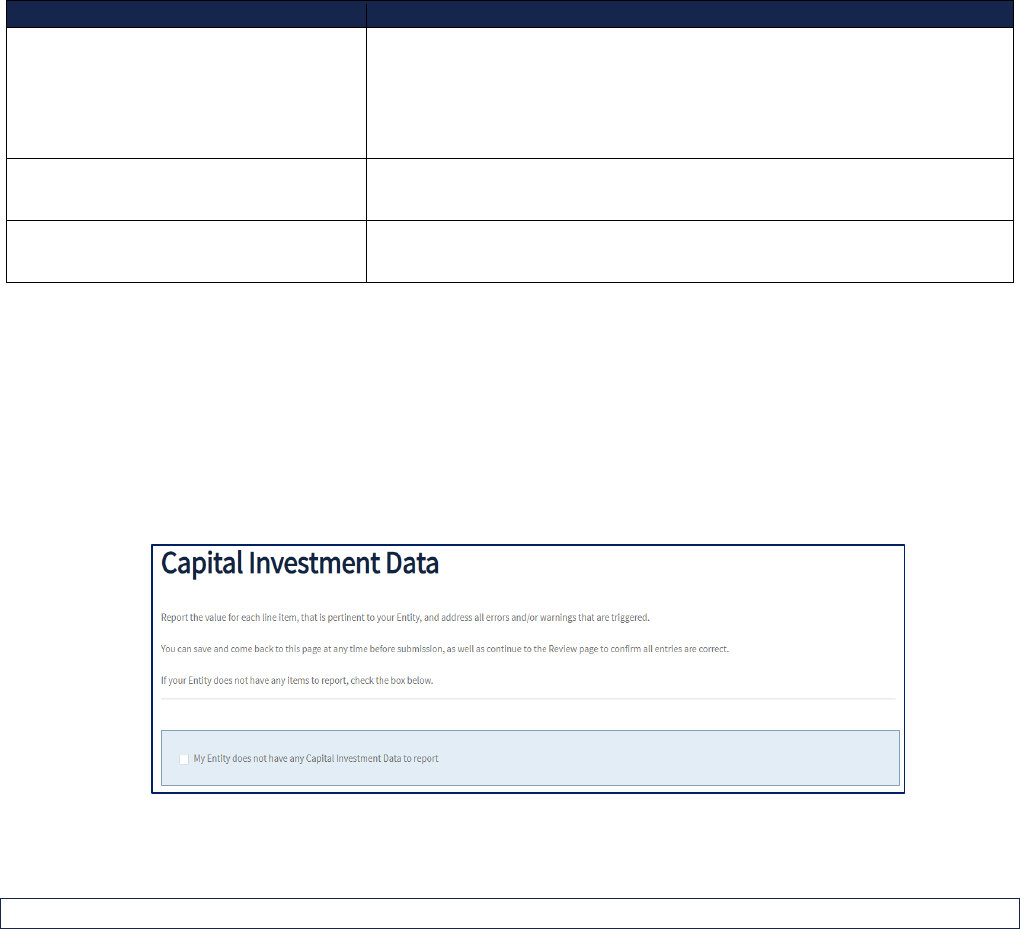
Rural Development Reporting & Compliance User Guide 51
Version 4, April 2024
Line Item
Description
Matching Funds (Equity)
The total amount of matching funds (in the form of equity) expended
during the year. Any matching funds expended in the form of short-term
or long-term loan funds should be accounted for under line items 'Other
Short-Term Loan Funds' and 'Other Long-Term Loan Funds'
respectively.
Salvaged Materials
The book value of salvaged materials used as plant but returned to
stock during the year.
Contribution in Aid to Construction
The total amount recorded for contributions to telecommunications plant
received during the year.
1. Click the Capital Investment Data link on the Current Report tab. This takes you to the Data Entry
page.
2. Select the check box, “My Entity does not have any Capital Investment Data to report”, as shown in
Figure 31 below, if the entity does not have any capital investment to report for the current reporting
period. If the entity has any capital investment to report, enter the amounts associated with the
respective line items.
Figure 31: System Data Report, Capital Investment Data Schedule – Nothing to Report
3. Click the [Save] button to save the data and stay on the page or click the [Save and Continue]
button to save the data and proceed to the Review page.
3.2.3.3 Depreciation Rates
The Depreciation Rates schedule is used to report the entity’s depreciation rates for its
telecommunications plant assets. This report schedule consists of three radio buttons and six sections.
The six sections are Network & Access Equipment, Outside Plant, Buildings, Towers, Customer
Premises Equipment and Support Assets.
1. Click the Depreciation Rates link on the Current Report tab. This takes you to the Data Entry
page.
2. Select the radio button that best corresponds to the entity’s depreciation rates as shown in Figure
32 below.
• If the first radio button, “My Entity’s depreciation rates are approved by a regulatory
authority with jurisdiction over the provision of telephone services.”, or the second radio
button, “My Entity’s depreciation rates are not approved by a regulatory authority with
jurisdiction over the provision of telephone services.”, is selected, complete the sections as
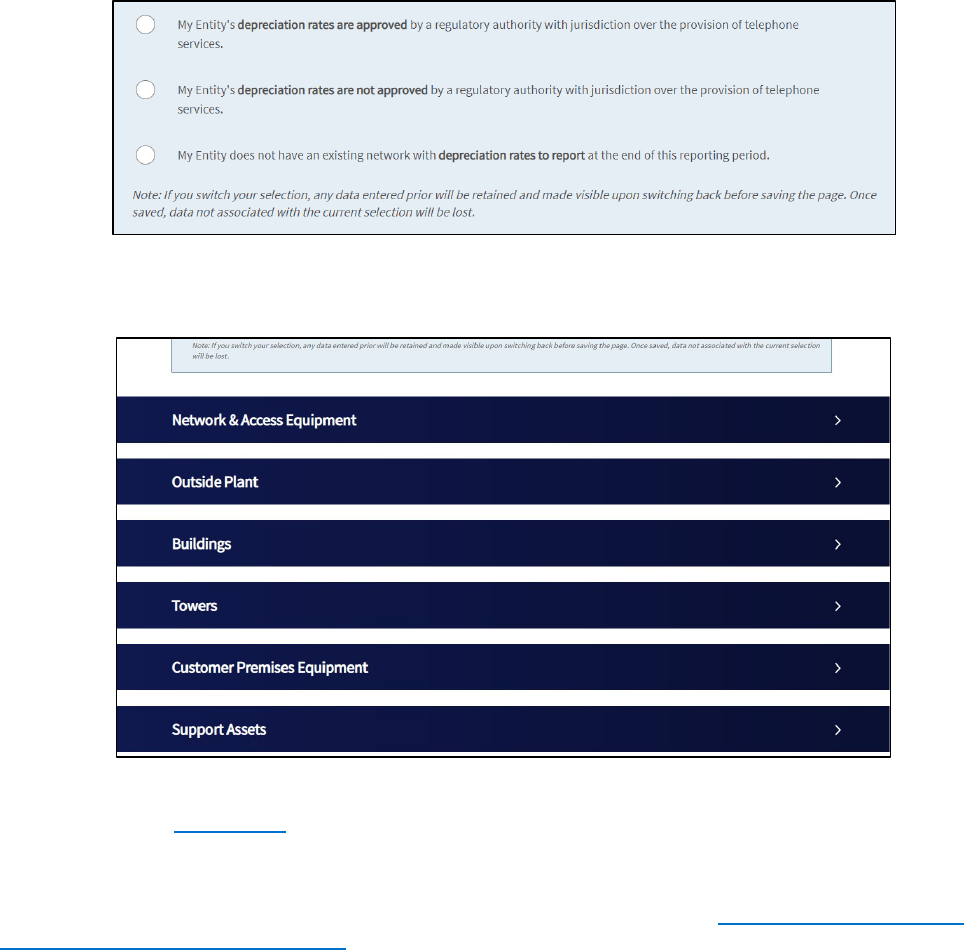
Rural Development Reporting & Compliance User Guide 52
Version 4, April 2024
applicable. If the selection of the radio button switches from the previous reporting to the current
reporting, a text box displays for the user to explain why the depreciation rates approval status
changed from the prior reporting period.
• If the third radio button, “My Entity does not have an existing network with depreciation
rates to report at the end of this reporting period.”, none of the sections need to be
completed.
Figure 32: System Data Report, Depreciation Rates Schedule – Entity’s Depreciation Rates Options
3. Click the [right arrow] of each accordion, as shown in Figure 33 below, to display the line items.
Figure 33: System Data Report, Depreciation Rate Schedule - Sections
4. Enter the depreciation rates for all asset categories that apply to the entity under each of the six
sections. See Appendix F
for additional information about the depreciation rates categories in R&C.
5. Click the [Save] button to save the data and stay on the page or click the [Save and Continue]
button to save the data and proceed to the Review page.
To review, certify, and submit the System Data Report to USDA, refer to
Certifying and Submitting
Financial and System Data Reports.
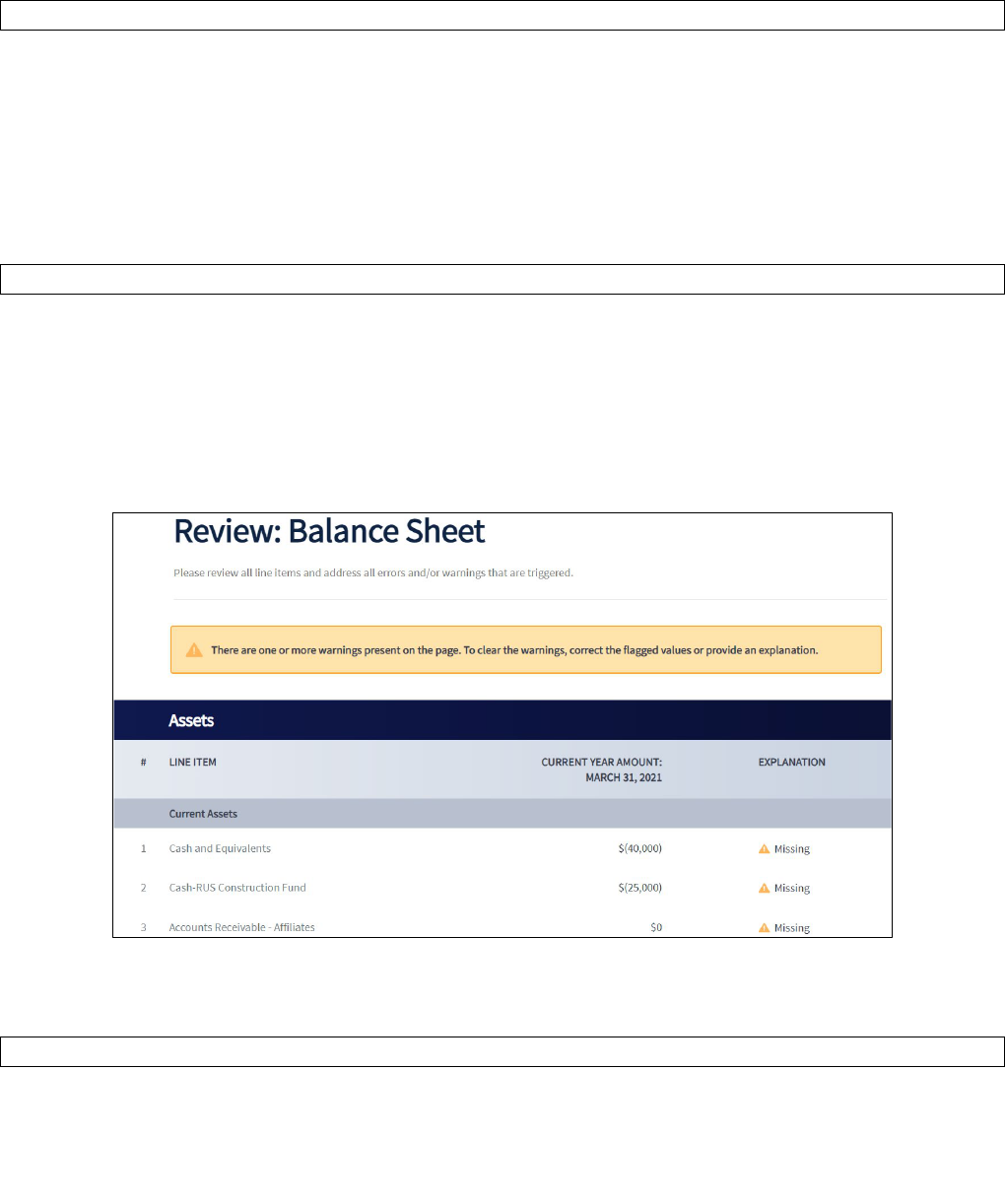
Rural Development Reporting & Compliance User Guide 53
Version 4, April 2024
3.2.4 Errors and Warnings for Financial & System Data Report Schedules
As data is entered on each report schedule, the system runs a validation check for errors and warnings.
If any errors or warnings are triggered, banner notifications appear at the top of the page and in-line
notifications appear below the line items where an error (red) or warning (amber) is triggered. Appendix
A, Warnings and Errors contains a comprehensive list of all errors and warnings along with ways to
resolve them.
A report containing errors cannot be submitted; however, a report containing warnings can be
submitted if all the warnings have been addressed.
3.2.5 Review Page for Financial & System Data Report Schedules
Once data is entered and saved on the Data Entry page for each report schedule, you can review the
information on the Review page, as shown in the Figure 34 below. The Review page is a read-only
version of the Data Entry page. Click the View link to view the explanations provided for the line item. If
a warning icon labeled “Missing” displays in the Explanation column, provide an explanation for that line
item. To update an existing explanation or enter a missing explanation, click the [Back] button to return
to the Data Entry page and make the required updates.
Figure 34: Financial Report, Balance Sheet Schedule - Review Page
If no further updates are required, click the [Continue] button to proceed to the next report schedule.
Alternatively, click the In-Report Menu link to navigate to a different report schedule.
3.2.6 Audit Report
The Audit Report is an entity-level report which provides independent assurance that the financial
statements are presented fairly, in all material respects, in accordance with accounting principles
generally accepted in the United States of America. The requirement to submit an audit and the date
when the audit is due depends on the legal structure of the entity, its fiscal year end date, and if
applicable, the amount of federal award funds the entity expended during the fiscal year.

Rural Development Reporting & Compliance User Guide 54
Version 4, April 2024
If the entity required to submit the Audit Report is a parent company, the parent must report on a
consolidated basis. The Audit Report must include consolidating schedules of the parent and its
subsidiary(ies) along with eliminating entries that add up to the consolidated totals. This requirement
can either be satisfied by being presented on the face of the consolidated financial statements or
included as supplementary schedules. If the entity required to submit the Audit Report is a subsidiary,
the subsidiary must submit a standalone audit even if the award was guaranteed by its parent
company.
• If the entity’s legal structure is a Corporation, Commercial Business, Limited Liability Company,
Cooperative, or Mutual Organization, it is subject to the audit requirements under 7 CFR 1773. For
these entities, an audit must be submitted to USDA within 120 days after the entity’s fiscal year end
date regardless of the amount of federal award funds that were expended during the fiscal year.
• If the entity’s legal structure is Authority, Municipality, Public Body, Public Power or Utilities District,
Indian Tribe, Tribal Government, Higher Education, Non-Profit, Territory or Possession of the
United States, or a State or Local Government, it is subject to the audit requirements under 2 CFR
200. For these entities, an audit must be submitted within 276 days after the entity’s fiscal year end
date, if the entity has expended more than $750,000 in federal award funds. Furthermore, if an
entity has received multiple federal awards, then it is required to submit a single audit to the Federal
Audit Clearinghouse (FAC).
o 2 CFR 200 Entities Only:
Select the radio button that best matches the amount of federal funds the entity has
expended during the current reporting period and whether the entity’s audit was already
submitted to the FAC, as shown in the Figure 35, below. The selection of the radio button
determines if an audit is required to be uploaded in the R&C.
• If the first radio button, “My Entity has expended $750,000 or more in Federal
awards during the fiscal year and we have not submitted our audit to the Federal
Audit Clearinghouse (Audit Required).” is selected, an audit must be uploaded.
• If the second radio button “My Entity has expended $750,000 or more in Federal
awards during the fiscal year and we have submitted our audit to the Federal
Audit Clearinghouse (Audit Optional).” is selected, uploading the audit is optional.
• If the third button “My Entity has not expended $750,000 or more in Federal awards
during the fiscal year (Audit Optional).” is selected, an audit does not need to be
uploaded.
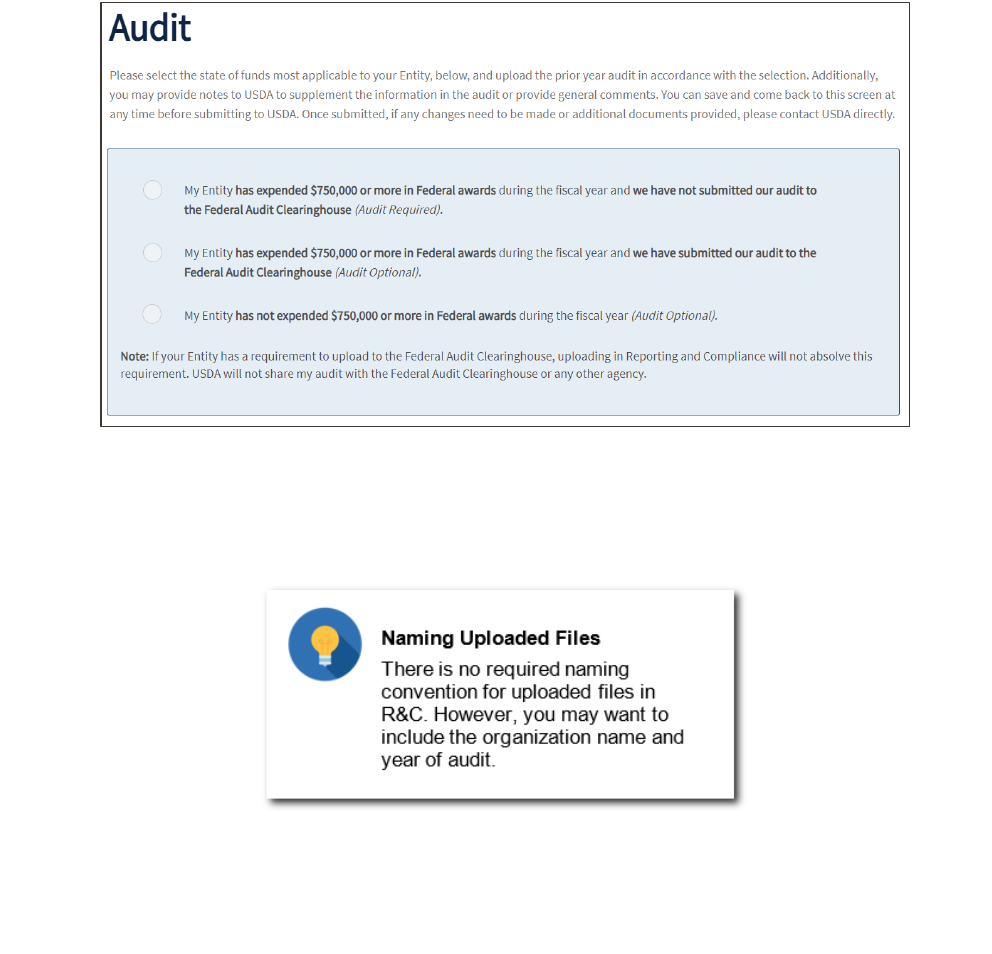
Rural Development Reporting & Compliance User Guide 55
Version 4, April 2024
Figure 35: Audit Report, 2 CFR 200 Audit page – Status of Audit for Entities Subject to 2 CFR 200 Audit
Requirements
Uploading the Audit Report:
The Audit Report can be uploaded by any user on the entity’s account, except for the user who has a
Viewer security role. Follow the steps below to upload and submit the Audit Report:
1. Click the [Upload Files] button in the Audit Upload section, as shown in Figure 36 below, to upload
the Audit Report by selecting it from your computer or dragging and dropping in the drop zone.
The file format must be a PDF and maximum file size is limited to 2GB.
2. Enter notes, if needed, in the “Notes to USDA” section.

Rural Development Reporting & Compliance User Guide 56
Version 4, April 2024
Figure 36: Audit Report, Audit Upload and “Notes to USDA” Window
3. Click the [Submit to USDA] button or click the [Save and Exit] button as shown in Figure 37 below.
• If the [Submit to USDA] button is clicked, a confirmation message, “Are you sure you want to
submit to USDA?” displays in a window.
o Click the [Yes, Submit to USDA] button to submit the Audit Report. A success page
displays to confirm that the report was successfully submitted to USDA. The report moves
from the Current Reports tab to the Submitted to USDA tab on the Reports dashboard.
An email notification is generated notifying all the users on the entity’s account that the
report was successfully submitted.
o Click the [No, Return to Report] button to navigate back to the Audit Report.
• If the [Save and Exit] button is clicked, the user is navigated to the Reports dashboard.
Figure 37: Audit Report, Notes to USDA, and [Submit to USDA] Button
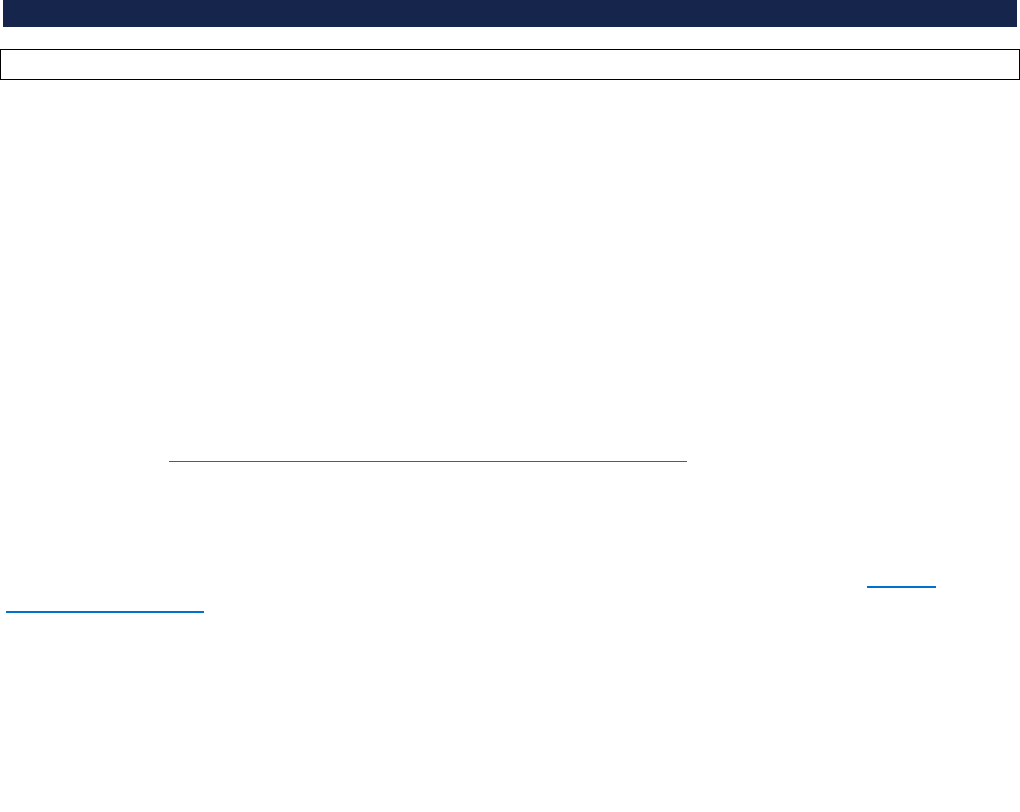
Rural Development Reporting & Compliance User Guide 57
Version 4, April 2024
3.3 Completing Project-Level Reports
3.3.1 Construction Progress Report
The Construction Progress Report is a project-level report that consists of two schedules. The
second schedule consists of two sections and one subsection:
• Construction Status
• Construction Progress Map
o Construction Progress Map
o New Broadband Subscribers to Report for this Period
Geospatial Upload of Subscriber Locations
The Construction Progress Report is used to report construction progress in the Approved Project
Service Area for each reporting period until construction of the project is complete. With the exception
of the final Construction Progress Report, the entity is required to report new broadband subscribers
that were connected in the Approved Project Service Area during the current reporting period as
explained under
New Broadband Subscribers to Report for this Period.
Once final construction progress has been reported, the entity will be required to submit the Annual
Performance Report for a period of three years starting the year following the “Date of Project
Completion”. The entity will continue to report the geospatial location data of new broadband
subscribers as part of the required Geospatial Upload of Subscriber Locations portion of
Annual
Performance Report.
Please complete reports in chronological order as data from previous reports flow into coinciding
reports.
Construction Status:
The Construction Status schedule must be completed before the entity is able to report construction
progress on the Construction Progress Map schedule of the report.
• Select the radio button to report the entity’s construction status for the reporting period, as shown in
Figure 38 below.

Rural Development Reporting & Compliance User Guide 58
Version 4, April 2024
Figure 38: Construction Progress Report, Construction Status Schedule – Entity’s Construction Status
Options
o If the first radio button, “My Entity has performed construction in the Approved Project
Service Area during the current reporting period.”, is selected, construction progress is
required to be reported on the Construction Progress layer for the current reporting period. If
this option is chosen, the partial build out of the Approved Project Service Area must be drawn
or uploaded on the Construction Process Map. Click the [Save and Continue] button to
proceed to the Construction Progress Map schedule of the report.
o If the second radio button, “My Entity has not performed any construction in the Approved
Project Service Area during the current reporting period.”, is selected, the Construction
Progress Map section is not available to report construction progress for the current reporting
period. Click the [Save and Continue] button to proceed to the Construction Progress Map
schedule of the report, navigate to, and complete
New Broadband Subscribers to Report for this
Period of the report.
o If the third radio button, “My Entity has completed construction of the Approved Project
Service Area.”, is selected, construction progress is required to be reported on the
Construction Progress layer for the current reporting period. The corresponding Approved
Project Service Area (APSA) on the Construction Progress Map should be drawn or uploaded
to reflect 100% construction complete. This would be reflected as the APSA showing completely
blue. Enter the “Date of Project Completion” and click the [Save and Continue] button to
proceed to the Construction Progress Map schedule of the report.
Note: For the purposes of reporting “My Entity has completed construction of the Approved
Project Service Area.”, completed construction means all of the broadband network has been fully
constructed and is capable of delivering broadband services to all of the Approved Project Service
Area.
3.3.2 How to Use the Construction Progress Map
The Construction Progress Map requires the use of interactive icons, buttons, and mapping tools, as
shown in Figure 39 below, to report the area(s) where construction was completed within the Approved
Project Service Area during the current reporting period.
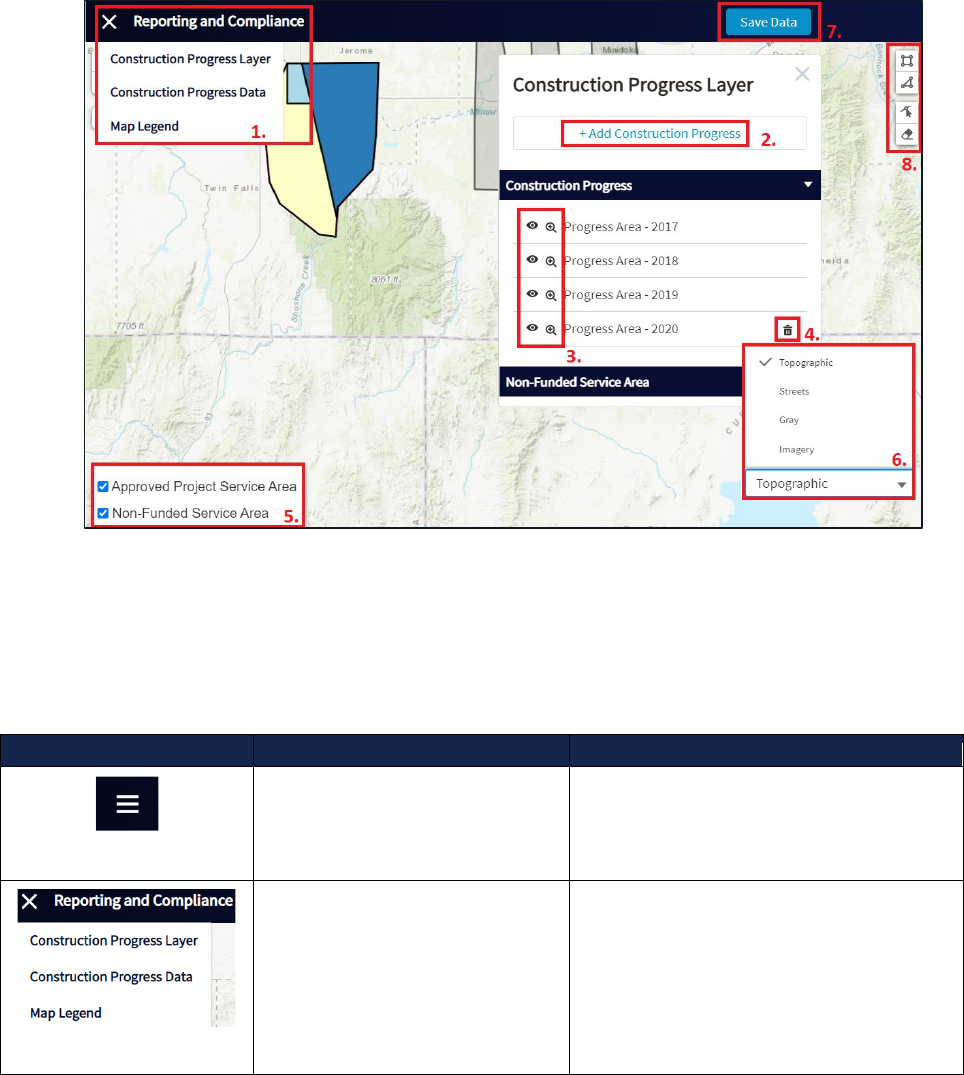
Rural Development Reporting & Compliance User Guide 59
Version 4, April 2024
Figure 39: Image of Entity’s Construction Progress Map
Table 13 Mapping Buttons & Icons and Table 14: Construction Progress Drawing Tools below, to
identify and understand the functions of the different icons and buttons in the map to assist with
reporting the Construction Progress.
Table 13: Mapping Buttons & Icons
This table identifies and explains items 1-7 in Figure 39 above.
Icon & Name
Screen Location
Function
[Map Menu]
1. Top Left of the Map
Displays a drop-down menu of the different
map elements. The Hamburger icon turns
into an “X” icon once the Map Menu is
selected.
Map Menu Options
1. Top left of the map. Displays
after clicking the [Map Menu] icon
Map Menu drop-down options include:
• Construction Progress Layer
• Construction Progress Data
• Map Legend
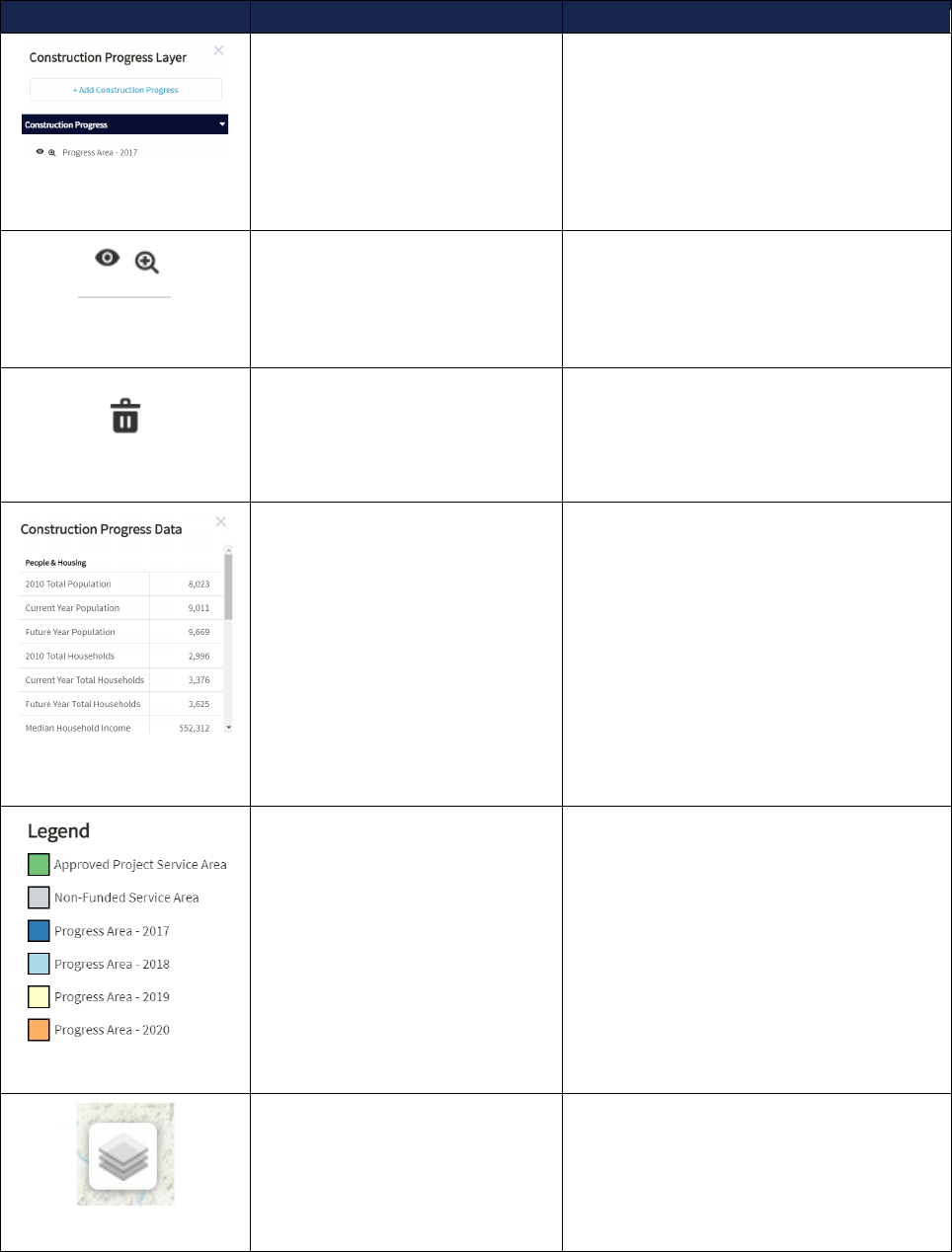
Rural Development Reporting & Compliance User Guide 60
Version 4, April 2024
Icon & Name
Screen Location
Function
[Add Construction
Progress] Button
2. Top middle of the map.
Displays after the Construction
Progress Layer option is
selected from the Map Menu
options.
Construction Progress Layer panel
appears on the map if the Construction
Progress Layer option is selected from
the Map Menu options. Click [+ Add
Construction Progress] to draw or upload a
shapefile of construction progress on the
map.
[Visibility] and [Zoom]
Options
3. Left of Construction Progress
layers.
• Eye icon allows users to toggle the
visibility of the layer on the map.
• Magnifying Glass icon allows users
to zoom into each layer.
[Trashcan] Button
4. Right of Construction Progress
layers.
• Remove the Construction Progress
Area layer; only available for the
current year’s layer
Construction Progress
Data Panel
Top middle of the map. Displays
after construction progress is
drawn or uploaded on the map.
Construction Progress Data panel displays
socio-economic, geographic, and
construction progress data about the
current construction progress area added
to the map during the current reporting
period.
Map Legend Colors
Legend displays on the top middle
of the map if the Map Legend
option is selected from the Map
Menu options
Map Legend panel helps users identify the
different layers on the Construction
Progress map. The different layers include:
Approved Project Service Area
Non-Funded Service Area, if applicable
Construction Progress Area – beginning of
construction to project completion
[Base Layer] Button
Bottom Left of the map.
Displays a pop-up menu of the available
map base layers when selected.
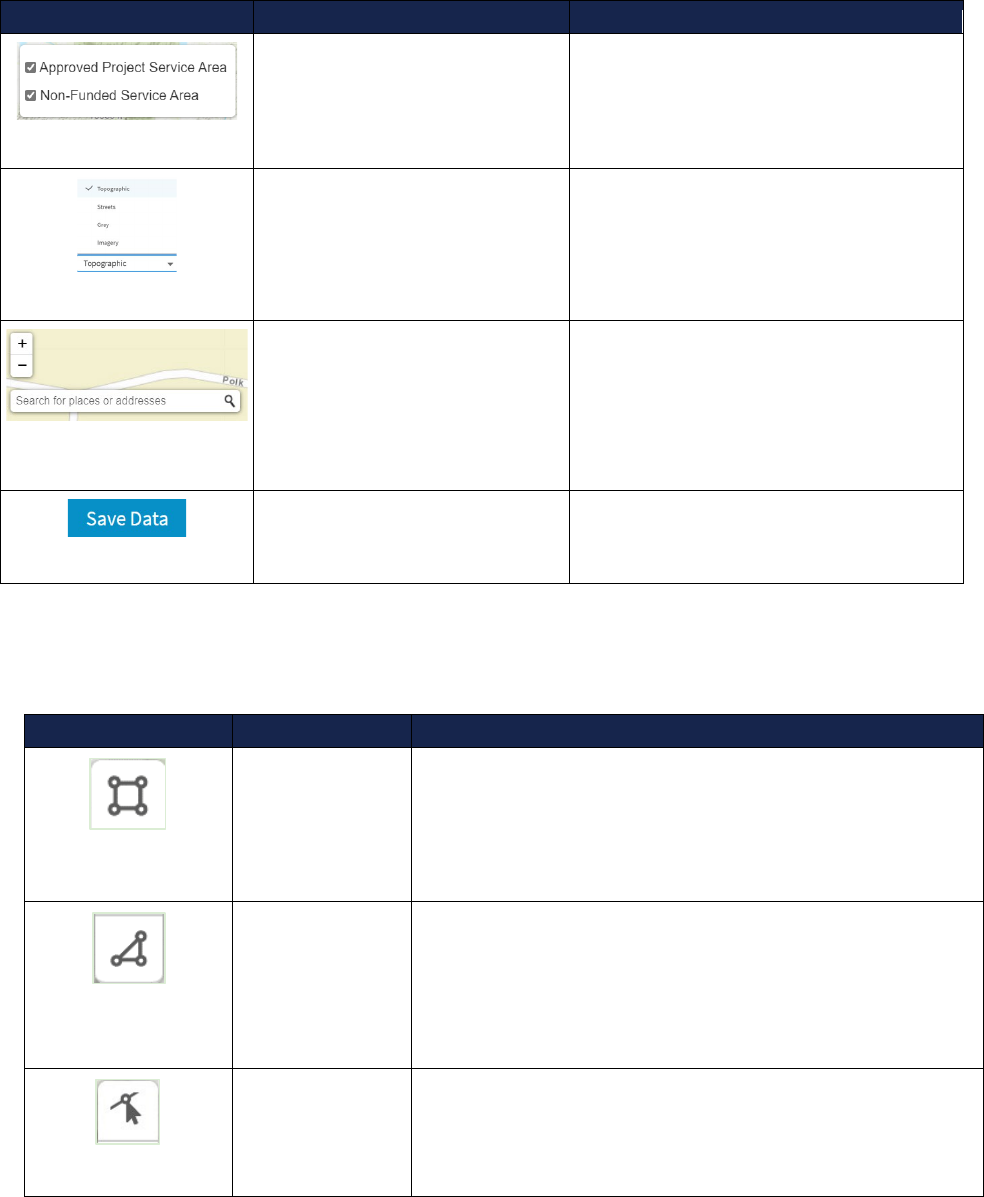
Rural Development Reporting & Compliance User Guide 61
Version 4, April 2024
Icon & Name
Screen Location
Function
Base Layer Options
5. Bottom left of the map.
Displays after clicking the [Base
Layer] icon.
• Base Layer options include:
• Approved Project Service Area,
which is always an option to display on
the Construction Progress Map
Basemap Picklist
6. Bottom right of the map. The
options expand after clicking.
Allows users to change the base map on
the map. Options include: Topographic,
Streets, Gray, and Imagery.
[Zoom In/Out] and Search
Box
Top left of the map. [Zoom]
buttons and [Search Box] display
when Map Menu is not expanded.
Zoom buttons allow users to zoom into and
out of the map. The Search Box expands
when you click it, and it allows users to
search for a place or address on the map.
[Save Data] Button
7. Top right of the map.
Allows users to save recently added,
modified, or removed polygons on the
map.
Table 14: Construction Progress Drawing Tools
This table identifies and explains the components of Item 8 in Figure 39 above.
Icon & Name
Screen Location
Function
[Draw Rectangle]
Tool
Right side of the
map
Allows users to draw a rectangle polygon on the map. When
selected, users must click on the map to place the first vertex,
then drag over the map to cover the area of construction
progress and click again to complete the rectangle.
[Draw Polygon] Tool
Right side of the
map
Allows users to draw any shape polygon on the map. When
selected, you must click on the map to place the first vertex
and every additional click will add a new vertex to the map
connecting it to the previous vertex. To complete the polygon,
the last click must be connected to the first vertex.
[Edit Layers] Tool
Right side of the
map
Allows users to edit the vertices of any layer added to the map.
When selected, you must click on an existing vertex of the
polygon and drag it to its new location. To complete the edit,
click [Finish] next to the Edit Layers icon when done.
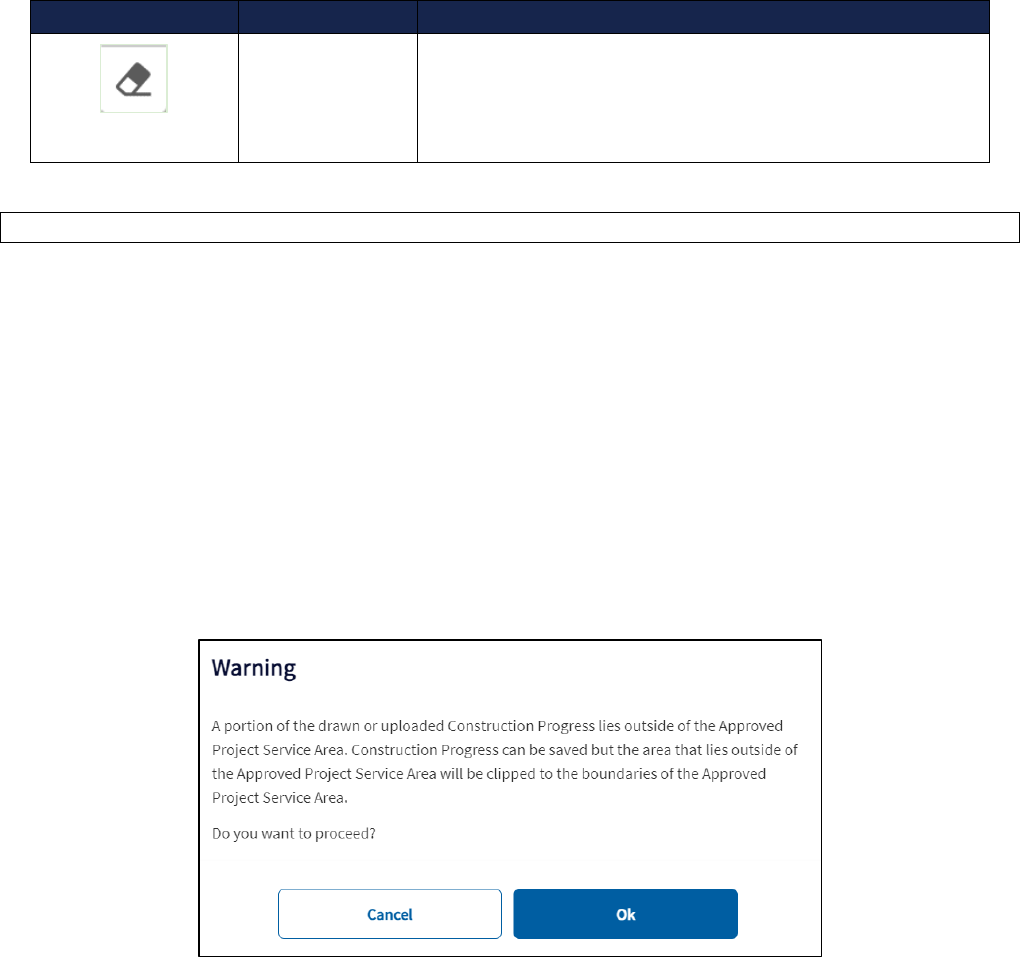
Rural Development Reporting & Compliance User Guide 62
Version 4, April 2024
Icon & Name
Screen Location
Function
[Remove Layers] Tool
Right side of the
map
Allows users to remove a polygon that has been plotted or
uploaded on the map. When selected, you must click on the
desired polygon to delete it.
3.3.3 Reporting Construction Progress to the Construction Progress Map
The Construction Progress Map displays the Approved Project Service Area that was included in the
entity’s approved application. Any Construction Progress Area uploaded or drawn in the map will
automatically clip to the bounds of the Approved project Service Area layer. Map users have the option
to turn these layers on and off while adding construction progress to the map. However, if the Approved
Project Service Area is turned off in the map, the construction progress layer will continue to clip to the
bounds of the Approved Project Service Area once the polygon record is drawn or a shapefile is
successfully uploaded in the map.
As shown in Figure 40 below, a warning message will appear on the map informing the user of the
requirement to only report construction progress within the Approved Progress Service Area. If the
entity wishes to proceed with clipping the portion of the polygon(s) outside of the Approved Project
service Area, click [OK]. Otherwise, click [Cancel] and the user will return to the map with nothing
added to the Construction Progress Area layer.
Figure 40: Construction Progress Report, Construction Progress Map - Warning Message
1. Expand the Map Menu icon located on the top left corner of the map, click the [Construction
Progress Layer] button, and the Construction Progress Layer panel will display, as shown in Figure
41 below.
2. Click the [+Add Construction Progress] button.

Rural Development Reporting & Compliance User Guide 63
Version 4, April 2024
Figure 41: Construction Progress Report, Construction Progress Layer Panel
3. Unless this is the entity’s final Construction Progress Report, select the Construction Progress as
the type of construction progress, as shown in Figure 42 below, to report in the drop-down list. The
Construction Progress type is used to report the construction progress for the Approved Project
Service Area on the map and will appear as part of the Construction Progress Area layer for the
reporting period.
Figure 42: Construction Progress Report, Construction Progress Map, Add Construction Progress
Window
4. Decide whether to upload a shapefile or draw the construction progress polygon(s) on the
Construction Progress Map.
• Uploading a Shapefile: Click the [Upload Files] button to upload an ESRI zipped shapefile or
drag and drop the file in the drop zone located next to the button. The maximum file size of the
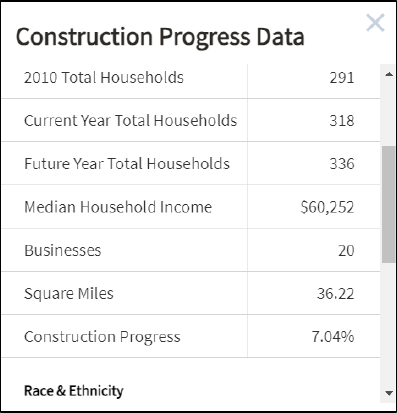
Rural Development Reporting & Compliance User Guide 64
Version 4, April 2024
upload is limited to 25MB. The Shapefile can include more than one non-contiguous
polygon; however, the shapefile must include an accompanying .prj file in which the coordinate
system of the data is defined, and each polygon must be closed and non-overlapping.
• Draw Construction Progress: Check the [Checkbox] to draw the entity’s area on the map and
refer to Table 14: Construction Progress Drawing Tools, for guidance on how to use the drawing
and editing tools on the map.
5. Click the [Add Progress] button to begin adding Construction Progress to the entity’s map.
6. Click [Construction Progress Data] from the Map Menu dropdown at any point after a Construction
Progress Area has been uploaded or plotted on the map to see aggregated geographic,
construction progress, and socio-economic data on the Construction Progress Data panel, as
shown in Figure 43 below.
The Construction Progress Data panel includes demographic data about the area the entity drew or
uploaded on the Construction Progress Map for the current reporting period. If the entity’s
construction progress was saved on the Construction Progress Map prior to July 1, the “Current
Year” date is as of the previous calendar year. If the entity’s construction progress was saved on
the Construction Progress Map on July 1 or after, the “Current Year” date is as of the current
calendar year. The “Future Year” date is five years from the “Current Year”. The “Future Year” data
is projected data.
Construction Progress % complete displays on the Construction Progress Data panel as XX.XX
% once construction progress is mapped during the current reporting period.
Figure 43: Construction Progress Report, Construction Progress Map - Construction Progress Data Panel
7. To save map data, click the [Save Data] button at the top right of the map, as shown in Figure 44
below.
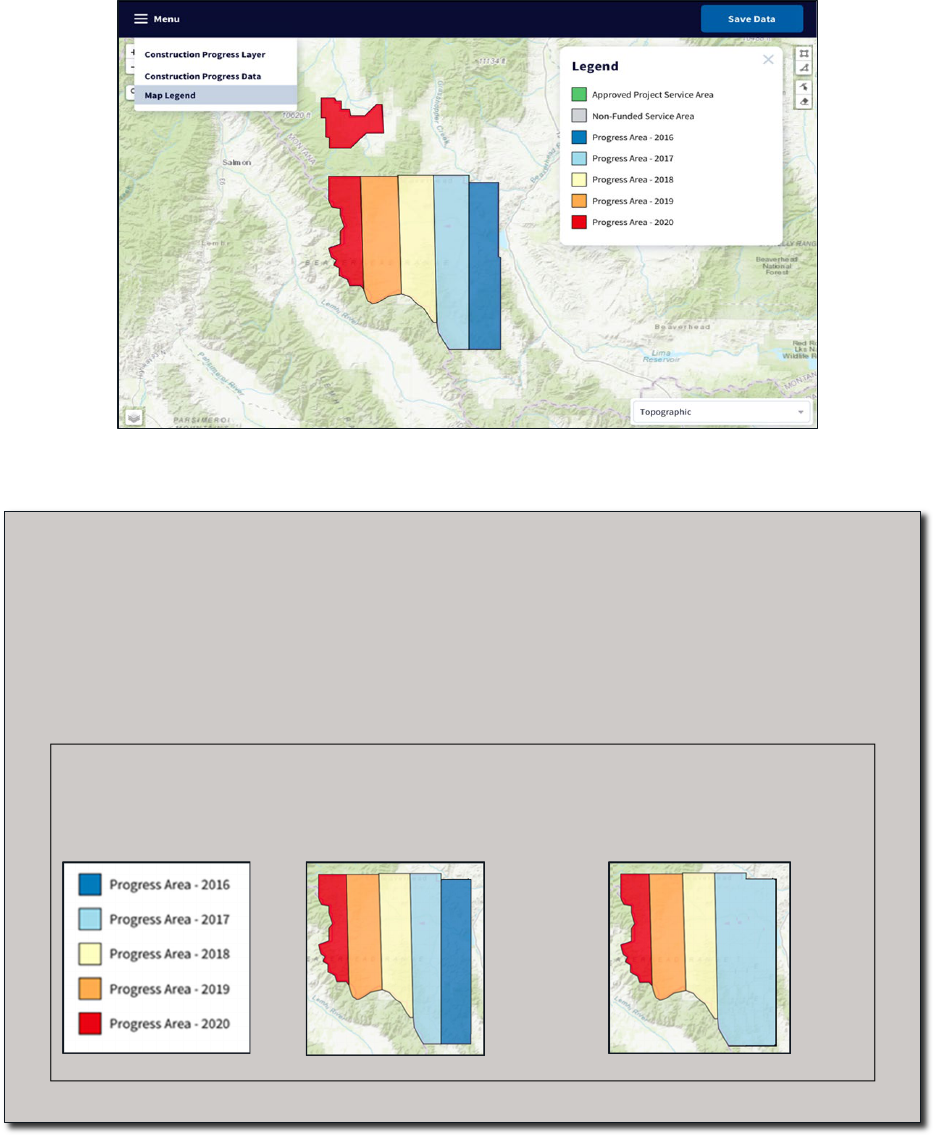
Rural Development Reporting & Compliance User Guide 65
Version 4, April 2024
Figure 44: Construction Progress Report, Construction Progress Map - Construction Progress Legend
and [Save Data] Button
Reporting Construction Progress Correctly on the Map
The percentage (%) of construction progress is calculated by dividing the area of the
“Construction Progress” polygon(s) by the total area of the “Approved Project Service
Area” polygon(s). The only way to show the construction progress as up to 100% complete
during the final Construction Progress Report, each Construction Progress Report
submitted after the first report, should cover the previous reporting period’s Construction
Progress Area in addition to the current reporting period’s Construction Progress Area.
Map Legend of
Example Progress
Areas
All Progress Areas are
mapped: “Progress
Areas 2016 – 2020”
If Progress Area "2016" is turned
off then you will not see the dark
blue area.
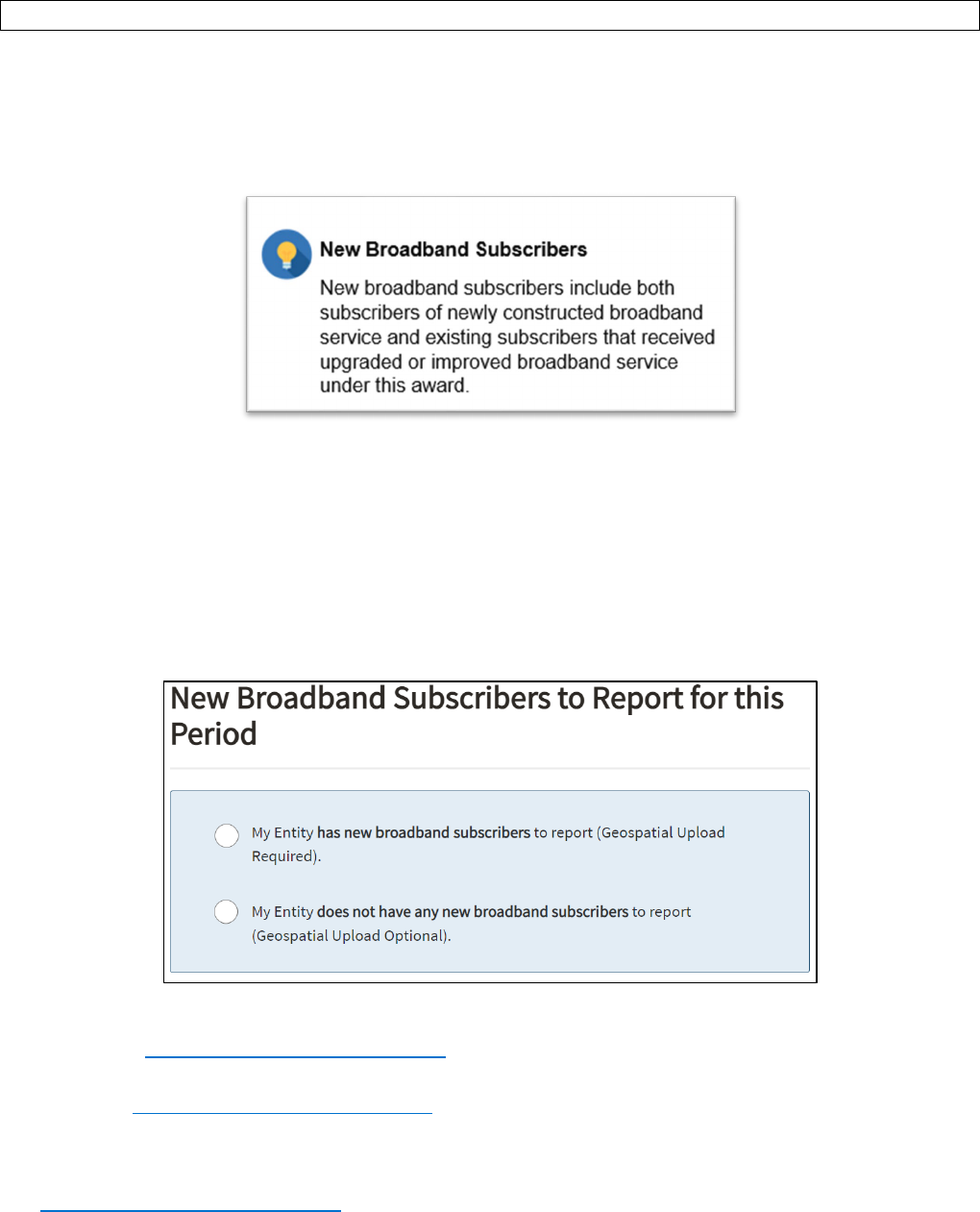
Rural Development Reporting & Compliance User Guide 66
Version 4, April 2024
3.3.4 New Broadband Subscribers to Report for this Period
With the exception of the final Construction Progress Report, the entity is required to complete the New
Broadband Subscribers to Report for this Period section. If the entity connected any new broadband
subscribers, which also includes any existing subscribers who obtain upgraded or improved broadband
service, in the Approved Project Service Area during the reporting period, subscriber locations are
required to be uploaded to the map, as shown in Figure 45 below.
• If new subscribers were added during this reporting period in the Approved Project Service Area,
select the first radio button, “My Entity has new broadband subscribers to report (Geospatial
Upload Required).”, and proceed to Step 1.
• If new subscribers were not added during this reporting period in the Approved Project Service
Area, select the second radio button, “My Entity does not have any new broadband subscribers
to report (Geospatial Upload Optional).”, and proceed to Step 3.
Figure 45: Construction Progress Report, Construction Progress Map Schedule - New Broadband
Subscribers to Report for this Period Section, Options
1. Click the [Upload Files] button under the Geospatial Upload of Subscriber Locations subsection to
upload the Geocoded Subscriber Locations
file by selecting it from your computer or dragging and
dropping in the drop zone. The maximum file size of the upload is limited to 25MB.
2. Once the Geocoded Subscriber Locations file successfully uploads on the map, the subscriber
location data displays on the map. This data can be viewed by clicking the subscriber point of
interest icon, as shown in
Figure 46 below. If the data does not look correct on the map, click the
[Remove Data] button and complete Step 1 again after updating the incorrect records in the
Geocoded Subscriber Locations
file.
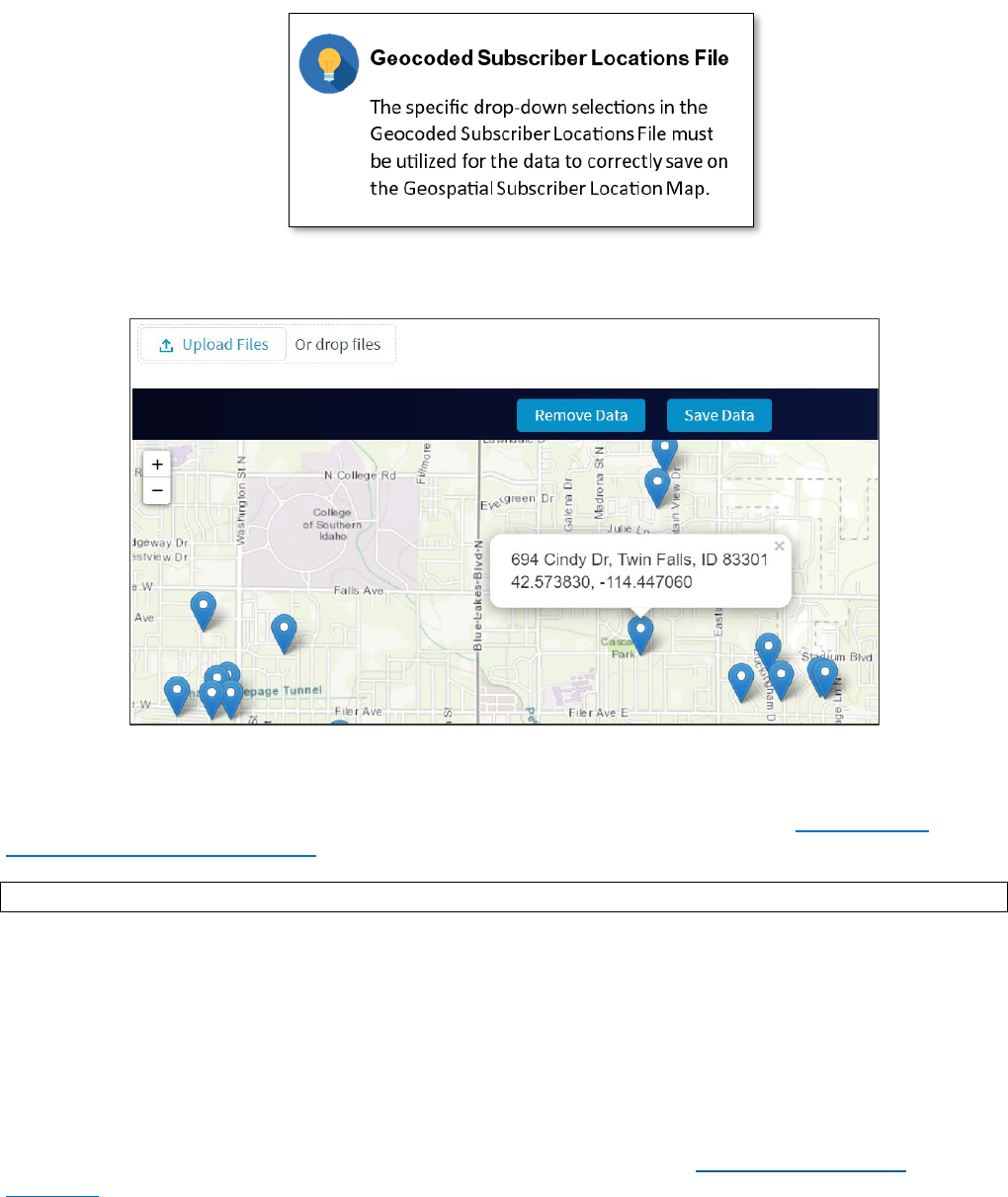
Rural Development Reporting & Compliance User Guide 67
Version 4, April 2024
Figure 46: Construction Progress Report, Construction Progress Map Schedule - Geospatial Subscriber
Locations Uploaded
3. Click the [Save Data] button on the map to save the geocoded subscriber locations data.
To review, certify, and submit the Construction Progress Report to USDA, refer to
Certifying and
Submitting Project-level Reports.
3.3.5 Annual Performance Report
The Annual Performance Report is a project-level report that is used to report the performance of the
project for a period of three years after construction completion. The first Annual Performance Report
will be generated immediately after the Awardee has submitted the Construction Progress Report
that has a Construction Completion Date on the Construction Status schedule. The Annual
Performance Report consists of two sections: Project Performance Narratives and Geospatial Upload
of Subscriber Locations
The Geospatial Upload of Subscriber Locations section is used to report the geospatial location of
residences, businesses, farms, and anchor institutions that are receiving new or improved broadband
service within the Approved Project Service Area. Rural Development’s Geocoded Subscriber
Locations Excel file must be used to report this data on an annual basis. The specific drop-down
selections in the file must be utilized for the data to save properly on the Geospatial Subscriber
Location Map. This file must contain only the data on residences, businesses, farms, and anchor
institutions that were connected during the reporting period in the Approved Project Service Area.

Rural Development Reporting & Compliance User Guide 68
Version 4, April 2024
1. Click the Annual Performance Report link on the Current Reports tab.
2. Enter the information under the “Project Performance Narratives”, as shown in Figure 47
below.
Each narrative can accept a maximum of 4,000 characters and 1 MB of images. Use the tool bar in
the section to format the text as desired.
3. Click the [Save] button in the header to save the narrative responses.
Figure 47: Annual Performance Report – Narratives
4. Click the [Upload Files] button under the Geospatial Upload of Subscriber Locations section to
upload the
Geocoded Subscriber Locations file by selecting it from your computer or dragging and
dropping in the drop zone. The maximum file size of the upload is limited to 25MB.
5. Once the Geocoded Subscriber Locations file successfully uploads on the map, the subscriber
location data displays on the map. This data can be viewed by clicking the subscriber point of
interest icon, as shown in Figure 46 above. If the data does not look correct on the map, click the
[Remove Data] button and complete Step (4) again after updating the incorrect records in the
Geocoded Subscriber Locations file.
6. Click the [Save Data] button on the map to save the geocoded subscriber locations data.
To review, certify, and submit the Annual Performance Report to USDA, refer to Certifying and
Submitting Project-level Reports.
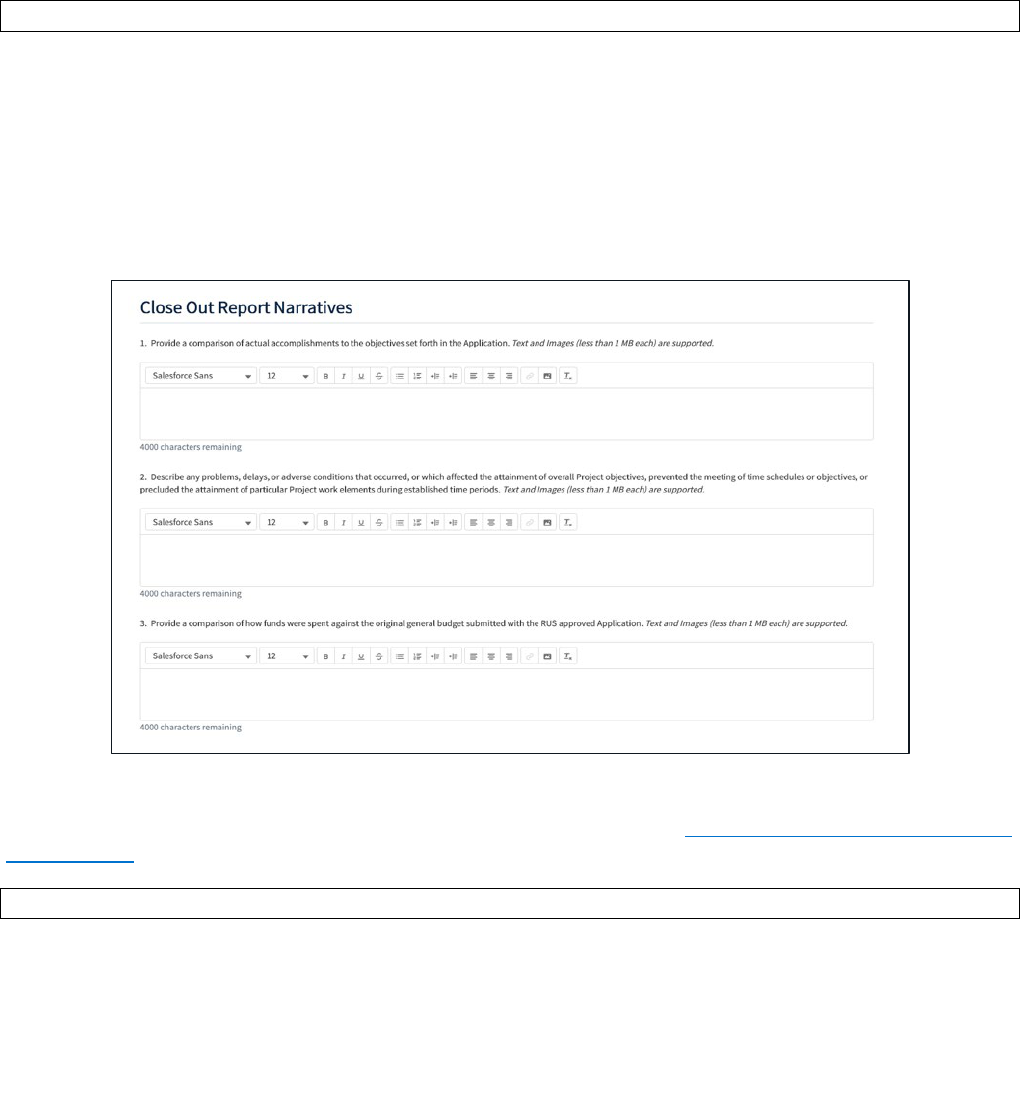
Rural Development Reporting & Compliance User Guide 69
Version 4, April 2024
3.3.6 Close Out Report
The Close Out Report is a project-level report that is used solely by ReConnect award recipients to
make sure all performance goals and objectives of the Federal award have been met.
1. Click the Close Out Report link on the Current Reports tab.
2. Enter the information under the “Close Out Report Narratives”, as shown in Figure 48 below. Each
narrative can accept a maximum of 4,000 characters and image(s) that are up to 1 MB. Utilize the
tool bar in the section to format the text as desired.
Figure 48: Close Out Report – Narratives
3. Click the [Save] button in the header to save the narrative responses.
To review, certify, and submit the Close Out Report to USDA, refer to Certifying and Submitting Project-
level Reports.
3.3.7 Annual Project Performance Activity Report
The Annual Project Performance Activity Report is a project-level report that is used to report to
relate accomplishments to performance goals and objectives of the Federal award.
1. Click the Annual Project Performance Activity Report link on the Current Reports tab.
2. Enter the information under the “Project Performance Activity Report Narratives”, as shown in
Figure 49
below. Each narrative section can accept a maximum of 4,000 characters and 1 MB of
images. Use the tool bar in the section to format the text as desired.
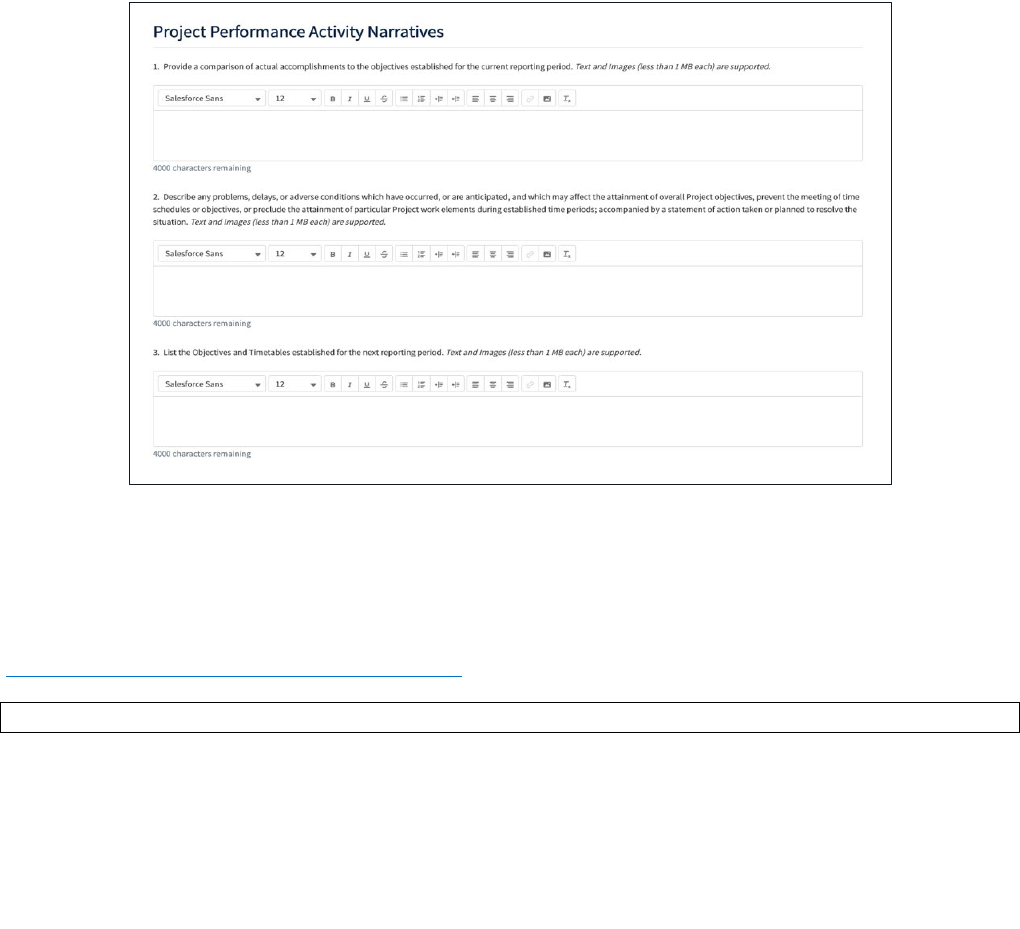
Rural Development Reporting & Compliance User Guide 70
Version 4, April 2024
Figure 49: Annual Project Performance Activity Report – Narratives
3. Click the [Upload] button to upload the SF-425 form for the reporting period by selecting it from your
computer or dragging and dropping in the drop zone. The file format must be a PDF and maximum
file size is limited to 2GB.
4. Click the [Save] button in the header to save the narrative responses and SF-425 upload.
To review, certify, and submit the Annual Project Performance Activity Report to USDA, refer to
Certifying and Submitting Project-level Reports
.
3.3.8 Final Project Performance Activity Report
The Final Project Performance Activity Report is a project-level report that is used to make sure all
performance goals and objectives of the Federal award have been met.
1. Click the Final Project Performance Activity Report link on the Current Reports tab.
2. Enter the information under the “Final Project Performance Activity Report Narratives”, as shown in
Figure 50
below. The narrative section can accept a maximum of 4,000 characters and 1 MB of
images. Use the tool bar in the section to format the text as desired.
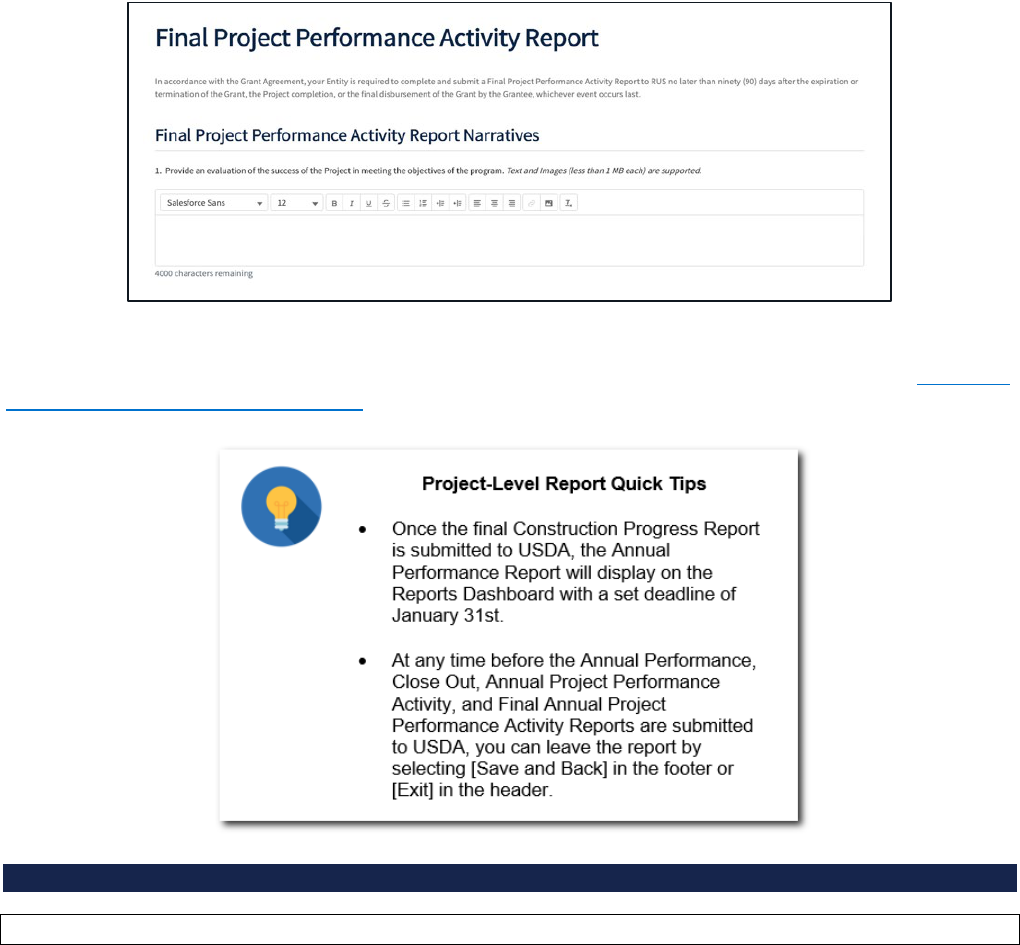
Rural Development Reporting & Compliance User Guide 71
Version 4, April 2024
Figure 50: Final Project Performance Activity Report – Narrative
3. Select the [Save] button in the header to save the narrative response.
To review, certify, and submit the Final Project Performance Activity Report to USDA, refer to Certifying
and Submitting Project-level Reports.
3.4 Certifying and Submitting Financial and System Data Reports
3.4.1 Review Report Page
The Financial Report and the System Data Report are the only two reports that contain a Review
Report page at the end of the report. The Review Report page summarizes the status of each schedule
including the errors and warnings, as shown in the figures below. Errors must be corrected, and
warnings must be corrected or explained on the Data Entry page for the respective report schedule.
The report schedules can be revisited by clicking the In-Report Menu link.
1. If no errors or warnings are triggered, a message “No outstanding errors and/or warnings present”
will display, as shown in Figure 51 below.
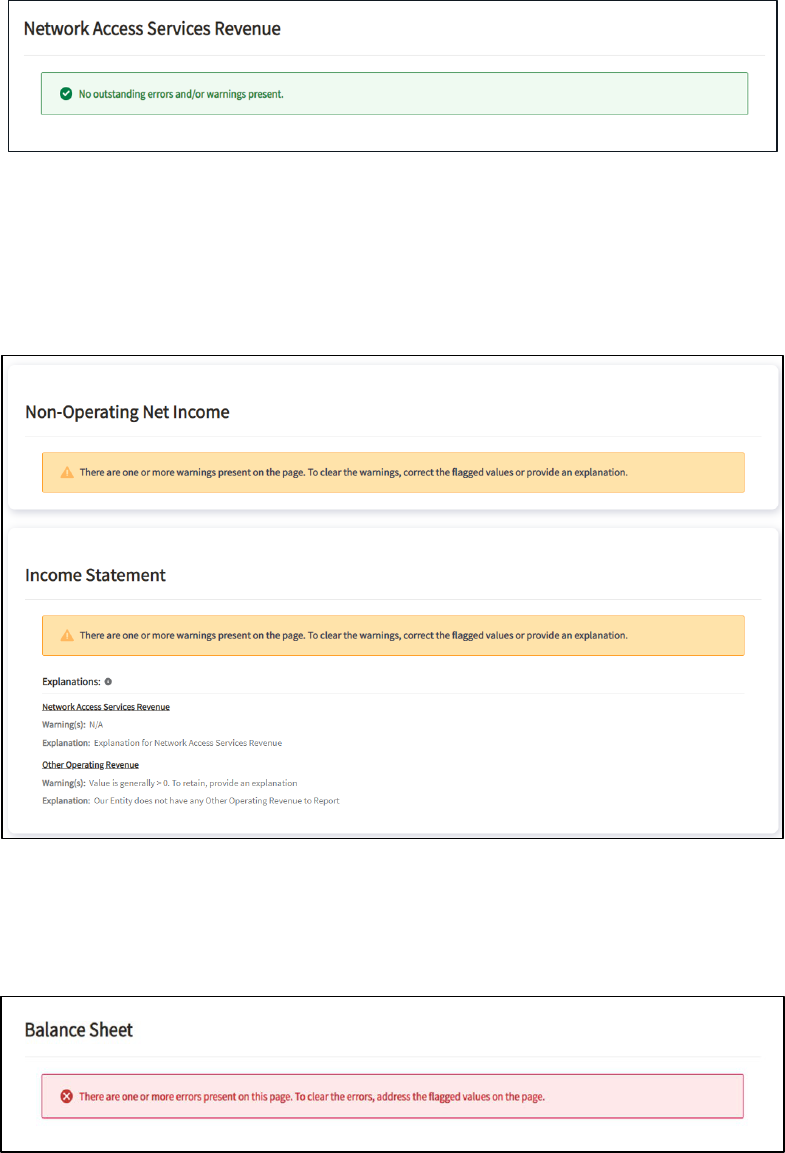
Rural Development Reporting & Compliance User Guide 72
Version 4, April 2024
Figure 51: Example of “No outstanding errors and/or warnings present” Message
2. If any warnings are triggered, a message “There are one or more warnings present on the page. To
clear the warnings, correct the flagged values or provide an explanation” will display as shown in
Figure 52 below. The warnings along with explanations provided by the user also display on this
page. Furthermore, any explanations entered that were not triggered by a warning, display as “N/A”.
Figure 52: Examples of “There are one or more warnings present on the page. To clear the warnings,
correct the flagged values or provide an explanation” Warning Message
3. If any errors are triggered, a message “There are one or more errors present on this page. To clear
the errors, address the flagged values on the page.” displays as shown in Figure 53 below.
Figure 53: Example of “There are one or more errors present on this page. To clear the errors, address
the flagged values on the page" Message
4. If a report schedule has not been started, a message “This page has not been started yet.” displays
as shown in Figure 54 below.
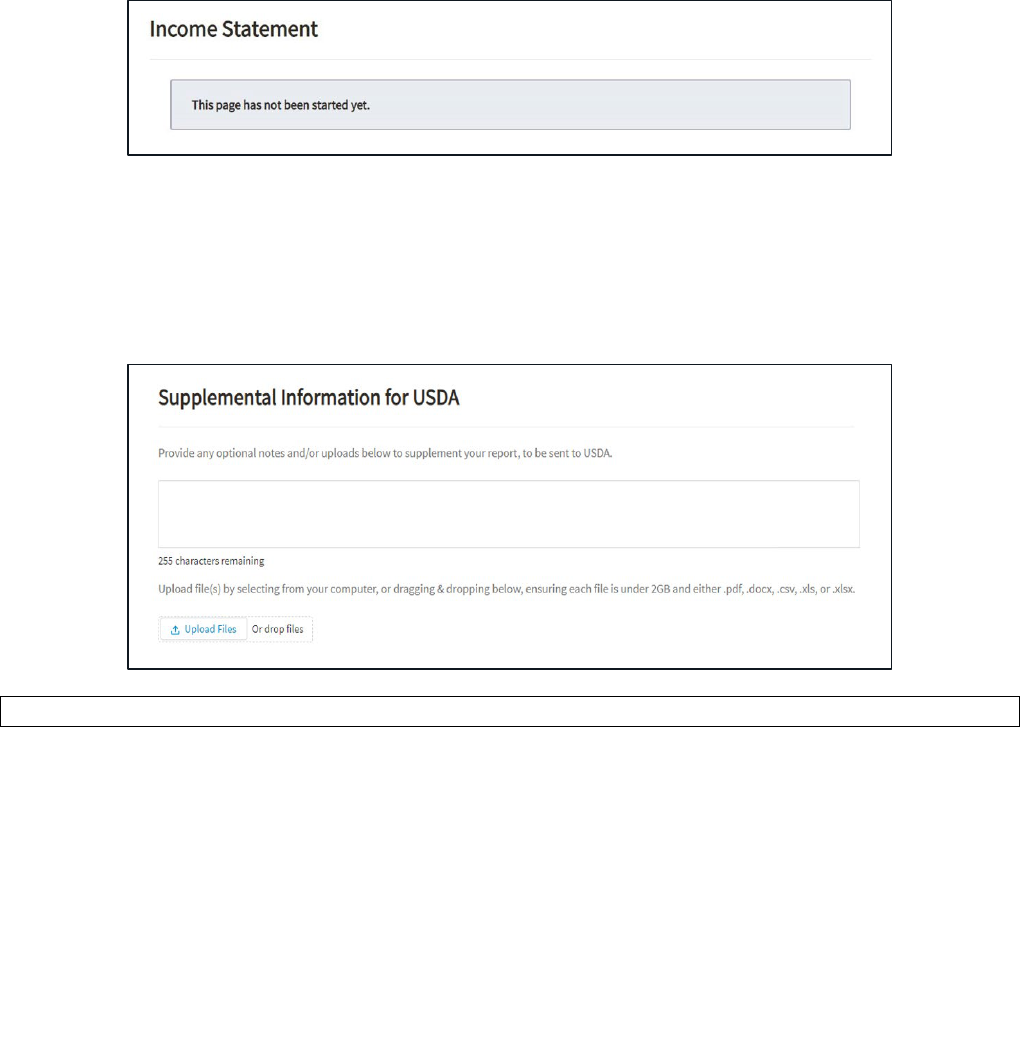
Rural Development Reporting & Compliance User Guide 73
Version 4, April 2024
Figure 54: Example of “This page has not been started yet.” Message
5. Enter notes, if needed, in the “Supplemental Information for USDA” section, as shown in Figure 55
below or click the [Upload Files] button to upload any documents that are relevant to the report by
selecting them from your computer or dragging and dropping them in the drop zone. The file format
must be a PDF, .doc, .csv, .xls, or .xlsx and the maximum file size is limited to 2GB.
Figure 55: Financial and System Data Reports, Review Report Page – “Supplemental Information for
USDA”
3.4.2 Initiate Report Certification
After all errors and warnings have been addressed, notes entered and files uploaded, the report
certification process can be initiated by any user on the entity’s account, except for a user with a
Viewer security role. After initiating report certification, the report can only be edited by the Rep Sign
Cert.
• Click either the [Initiate Certification], [Save and Back], or [Save and Exit] button as shown in Figure
56 below.
o If the [Initiate Certification] button is clicked, a confirmation message, “Are You sure you Want
To Initiate Report Certification?” displays in a window.
Click the [Yes, Initiate Report Certification] button to initiate the certification process. A
success page displays to confirm that report certification was successfully initiated for the
entity’s Rep Sign Cert. The report moves from the Current Reports tab to the Pending
Certification tab on the Reports dashboard. An email notification is generated notifying the
Rep Sign Cert that report certification has been initiated.
Click the [No, Return to Report] button to navigate back to the Review Report page.
o If the [Save and Back] button is clicked, the user is redirected to the previous report
schedule.
o If the [Save and Exit] button is clicked, the changes on the Review Report page are
saved, and the user is redirected to the Reports dashboard.

Rural Development Reporting & Compliance User Guide 74
Version 4, April 2024
Figure 56: Financial and System Data Reports, “Ready to Initiate Report Certification?”
3.4.3 Certifying and Submitting the Report
Once the report certification process is initiated, the Rep Sign Cert is the only user on the entity’s
account who can certify and submit the report by following the steps below:
1. Click the report link for the respective Financial or System Data Report on the Pending
Certification tab on the Reports dashboard. This navigates the Rep Sign Cert to the Review
Report page.
2. Click the [Submit to USDA] button on the Review Report page or click the [Send Back for Edits]
button, as shown in Figure 57 below.
• If the [Submit to USDA] button is clicked, a confirmation message, “Are you sure you want to
submit to USDA?”, displays in a window.
o Click the [Yes, Submit to USDA] button to submit the report. A success page displays to
confirm that the report was successfully submitted to USDA and the report moves from the
Pending Certification tab to the Submitted to USDA tab on the Reports dashboard. An
email notification is generated notifying all users on the entity’s account that the report was
successfully submitted.
o Click the [No, Return to Report] button to navigate back to the Review Report page.
• If the [Send Back for Edits] button is clicked, a confirmation message “Are You Sure You Want
to Send Back for Edits?” displays in a window:
o Click the [Yes, Send Back for Edits] button to return the report for edits. The report moves
from the Pending Certification tab to the Current Reports tab on the Reports dashboard.
An email notification is generated notifying all users on the entity’s account that the report
has been returned for edits.
o Click the [No, Return to Report] button to navigate back to the Review Report page.
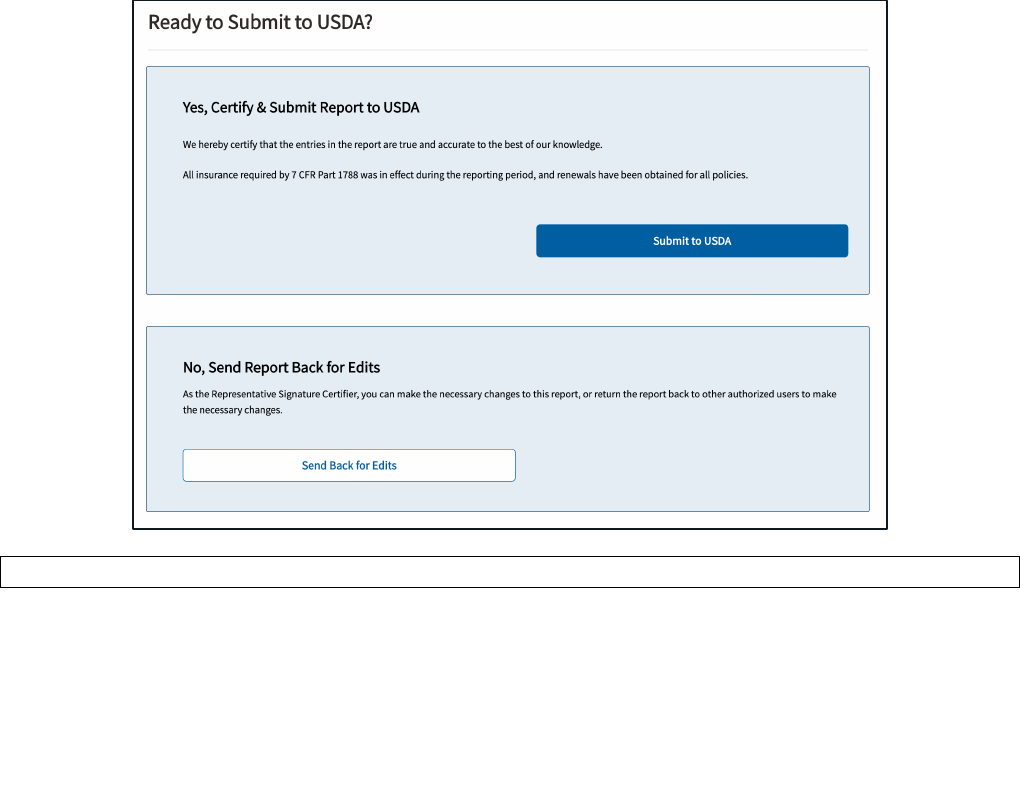
Rural Development Reporting & Compliance User Guide 75
Version 4, April 2024
Figure 57: Financial and System Data Reports, Ready to Submit to USDA?
3.4.4 Quarter 4 Financial Report Certification
When submitting the Quarter 4 Financial Report, the Rep Sign Cert must certify whether a default has
or has not occurred on its current obligations to RUS, as shown in Figure 58 below.
• Select the radio button, “All of the obligations under the RUS award documents have been
fulfilled in all material aspects” if a default has not occurred.
• Select the radio button, “There has been a default in the fulfillment of obligations under the
RUS award documents” if a default has occurred. A document explaining the default must be
uploaded. Click the [Upload Files] button to upload the document by selecting it from your computer
or dragging and dropping it in the drop zone. The file format must be a PDF and the maximum file
size is limited to 2GB.

Rural Development Reporting & Compliance User Guide 76
Version 4, April 2024
Figure 58: Financial and System Data Reports, Yes, Certify & Submit Report to USDA
3.5 Certifying and Submitting Project-Level Reports
3.5.1 Initiate Report Certification
Once all errors and warnings have been addressed, notes entered and files uploaded, the report
certification process can be initiated by any user on the entity’s account, except for a user with a
Viewer security role. After initiating report certification, the report can only be edited by the Rep Sign
Cert.
1. Click the [Initiate Report Certification] button or Click the [Save and Back] button as shown in
Figure 59: Project-Level Reports, Ready to Initiate Report Certification? below.
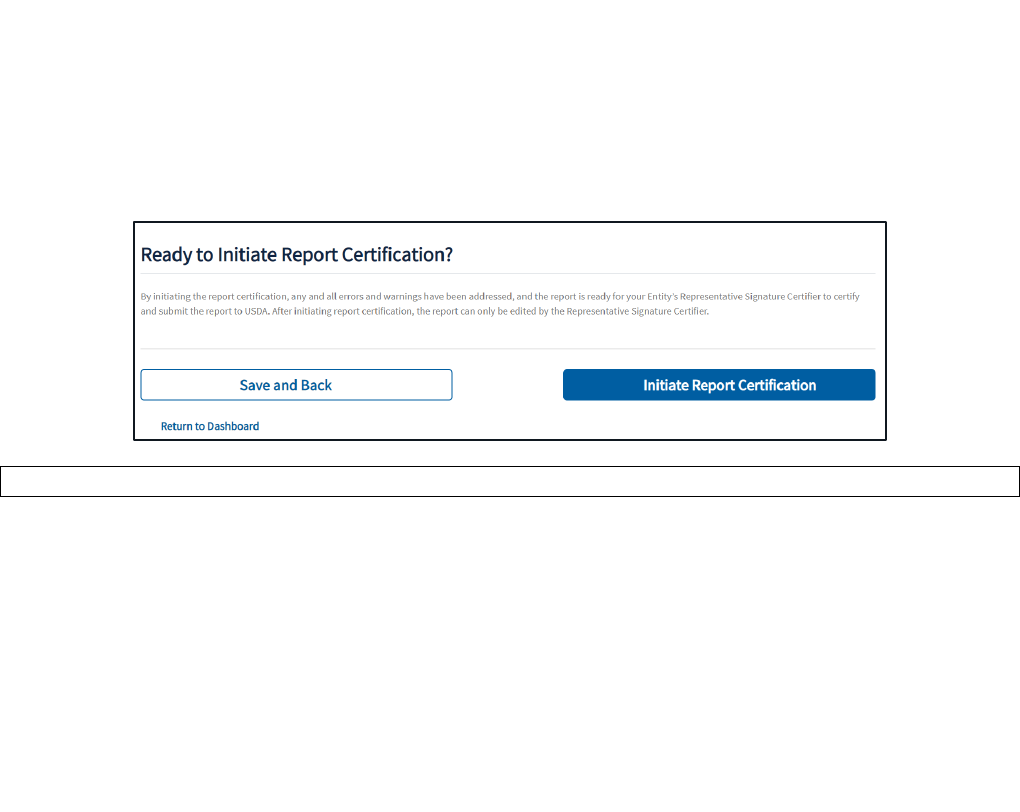
Rural Development Reporting & Compliance User Guide 77
Version 4, April 2024
• If the [Initiate Report Certification] button is clicked, a confirmation message, “Are You sure you
Want To Initiate Report Certification?” displays in a window.
o Click the [Yes, Initiate Report Certification] to initiate the certification process. A success
page displays to confirm that report certification was successfully initiated for the entity’s
Rep Sign Cert. The report moves from the Current Reports tab to the Pending
Certification tab on the Reports dashboard. An email notification is generated notifying
the Rep Sign Cert that report certification has been initiated.
o Click the [No, Return to Report] button to navigate back to the report.
• If the [Save and Back] button is clicked, the user is navigated to the Reports dashboard.
Figure 59: Project-Level Reports, Ready to Initiate Report Certification?
3.5.2 Certifying and Submitting the Report
Once the report certification process is initiated, the Rep Sign Cert is the only user on the entity’s
account who can certify and submit the reports by following the steps below:
1. Click the report link for the respective report on the Pending Certification tab on the Reports
dashboard. This navigates the Rep Sign Cert to the report.
2. Click the [Submit to USDA] button or click the [Send Back for Edits] button, as shown in Figure 60,
below.
• If the [Submit to USDA] button is clicked, a confirmation message, “Are you sure you want to
submit to USDA?”, displays in a window.
o Click the [Yes, Submit to USDA] button to submit the report. A success page displays to
confirm that the report was successfully submitted to USDA and the report moves from the
Pending Certification tab to the Submitted to USDA tab on the Reports dashboard. An
email notification is generated notifying all the users on the entity’s account that the report
was successfully submitted.
o Click the [No, Return to Report] button to navigate back to the Review Report page.
• If the [Send Back for Edits] button is clicked, a confirmation message “Are You Sure You Want
to Send Back for Edits?” displays in a window:
o Click the [Yes Send Back for Edits] button to return the report for edits. The report moves
from the Pending Certification tab to the Current Reports tab on the Reports dashboard.
An email notification is generated notifying all users on the entity’s account that the report
has been returned for edits.
o Click the [No, Return to Report] button to navigate back to the report.
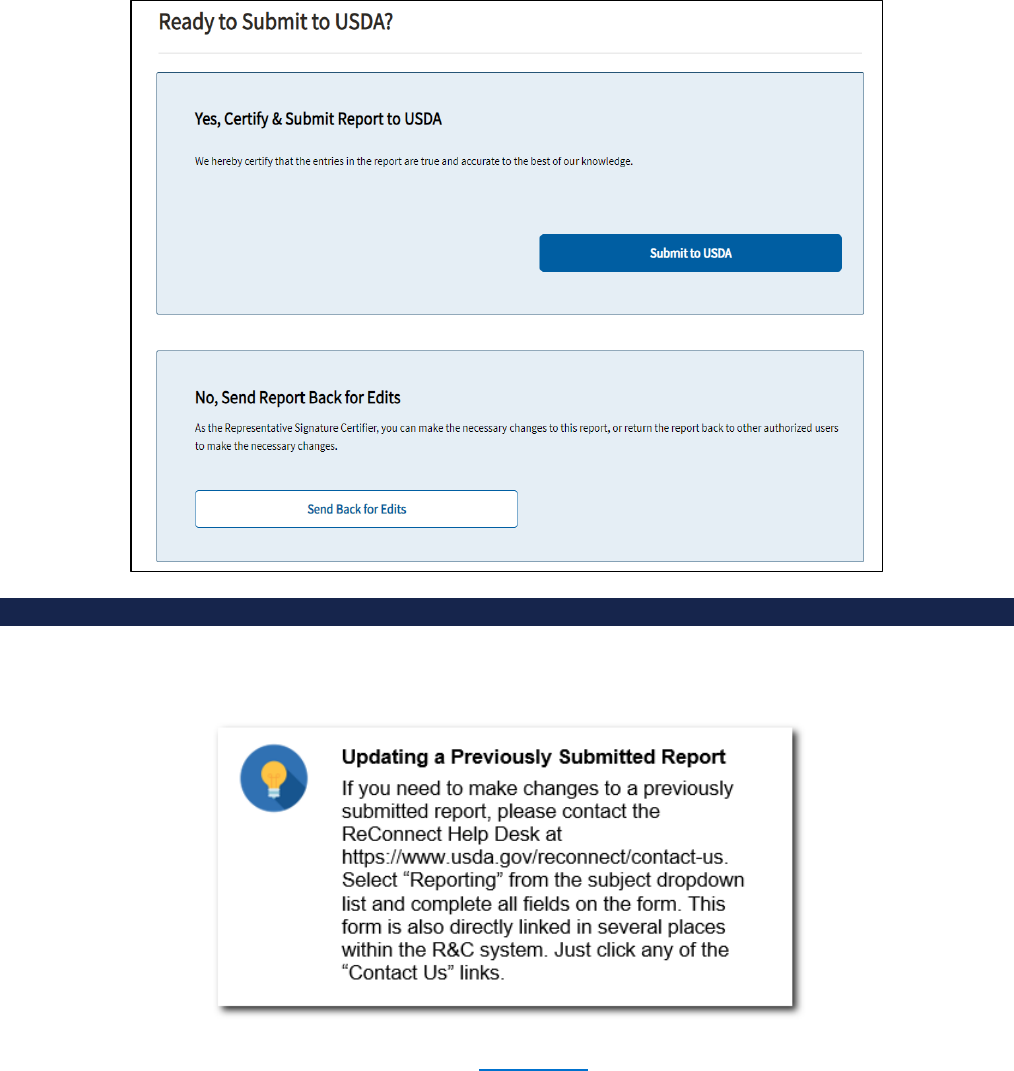
Rural Development Reporting & Compliance User Guide 78
Version 4, April 2024
Figure 60: Project-Level Reports, Ready to Submit to USDA?
3.6 Post-Submission Process
Once a report is submitted to USDA, it will display on the Submitted to USDA tab on the Reports
dashboard. Users can no longer make any updates to the submitted report.
The next section provides instructions on how to Contact Us
.
Upon review of the report, USDA will send an email notification to all users on the entity’s account
either accepting the report or requesting a resubmission of the report.
If a resubmission of a report is requested, the report will move from the Submitted to USDA tab to the
Current Reports tab and flagged with a RESUBMISSION REQUESTED indicator, as shown in Figure
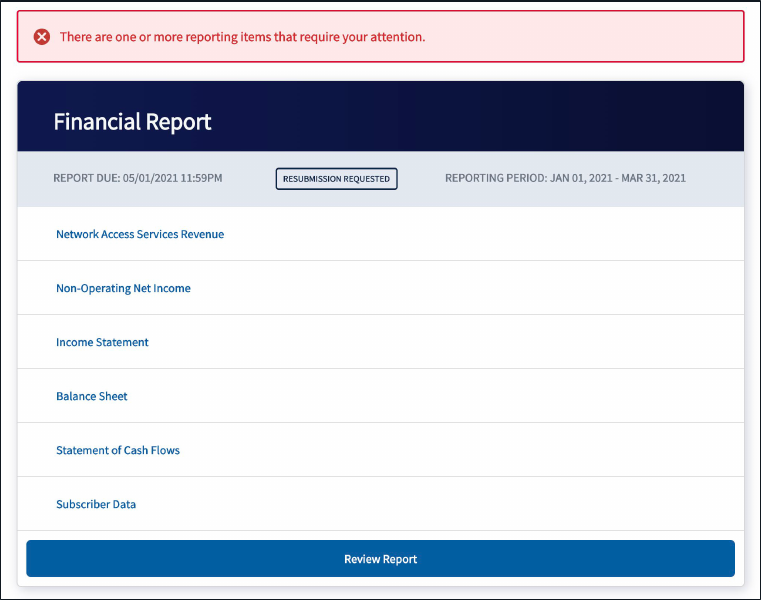
Rural Development Reporting & Compliance User Guide 79
Version 4, April 2024
61 below. USDA will provide notes on the affected line item(s) on the report schedule(s) or on the
Review Report page(s).
Figure 61: Example of Financial Report, Resubmission Requested
Notes from USDA show as a note or link, as listed below:
Financial Report
• USDA Review Findings note on the Review Report page
• View Note from USDA link on individual Report Schedule line items
System Data Report
• USDA Review Findings note on the Review Report page
Audit and Project-level Reports
• USDA Review Findings note on the individual report page
Notes from USDA appear as shown in Figure 62 – Figure 65 below:
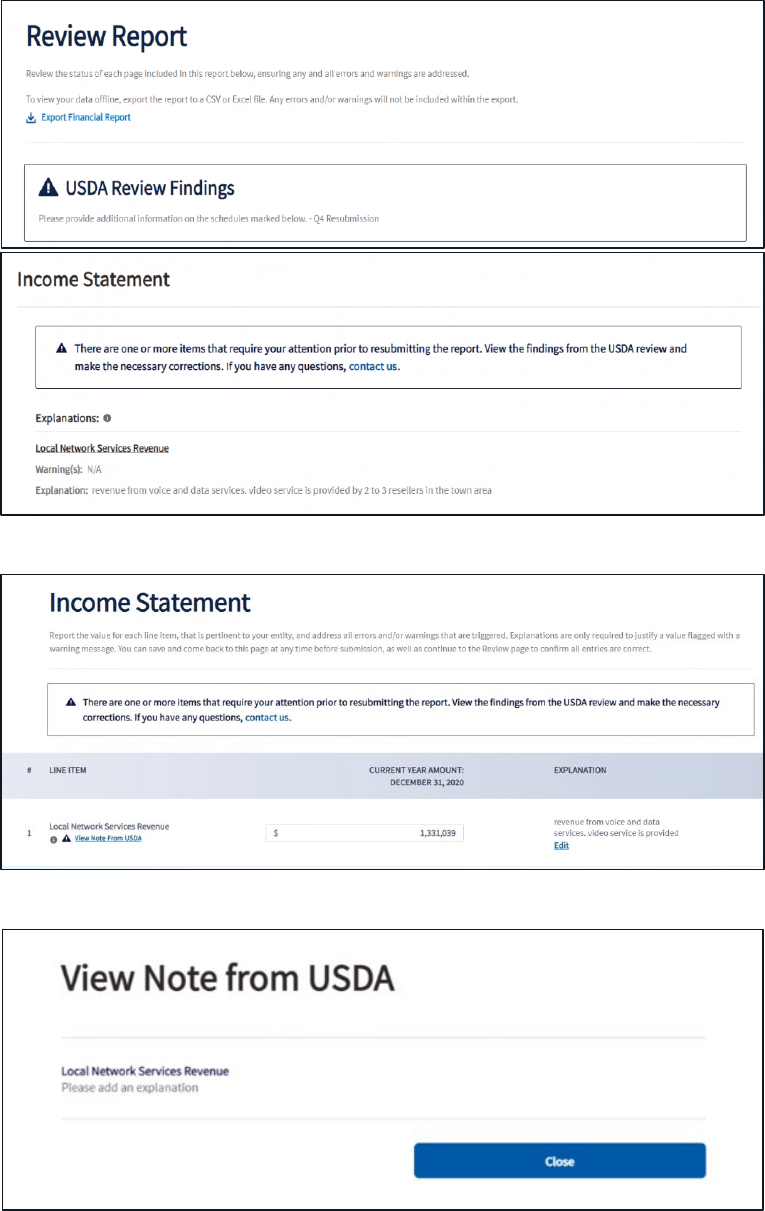
Rural Development Reporting & Compliance User Guide 80
Version 4, April 2024
Figure 62: Review Report Page – Notes from USDA
Figure 63: Example of Income Statement Schedule, View Note from USDA Link
Figure 64: Example of Income Statement Schedule, View Note from USDA Window

Rural Development Reporting & Compliance User Guide 81
Version 4, April 2024
Figure 65: Example of Project-level Report, USDA Review Findings
The entity must review and address all of the USDA notes before reviewing, certifying, and resubmitting
the report.
Contact Us
All Contact Us links in R&C direct users to the Contact Us Form at:
https://www.usda.gov/reconnect/contact-us
. For questions related to R&C, select “Reporting” from the
subject dropdown list. Complete all the fields on the form and also include the user’s entity name and
contact number at the end of the message in the Question box so that USDA can contact the user for
additional details.
Answers to common questions about how to complete reports can be found in the Frequently Asked
Questions document located on the Reporting and Compliance page of the ReConnect website:
https://www.usda.gov/reconnect/reporting-compliance.

Rural Development Reporting & Compliance User Guide 82
Version 4, April 2024
Glossary of Key Terms
Account: A type of record that stores an entity's business information, such as the legal name,
headquarters address, correspondence address, business structure, point of contact details, and other
related information.
Approved Project Service Area: The Proposed Funded Service Area that was approved as part of the
approved application.
Awardee: Referred to as an "entity" in the guide, an organization that has received funding from the
USDA Rural Utilities Service (RUS) and is under contract to meet reporting and compliance
requirements.
Banner Notifications: Static, system-generated messages that notify the user that an error has been
found on the page.
Broadband Subscriber: Any customer that receives fixed, terrestrial broadband service as defined in
the latest federal register notice for the respective financial assistance program, under which, the
submitted project was approved, either exclusively, or as a bundled package with other services.
Construction Progress: Represents the area(s) on the Construction Progress Map that are fully
constructed and ready to deliver broadband service to subscribers as defined in the latest federal
register notice for the respective financial assistance program, under which, the submitted project was
approved.
Construction Progress Map: A mapping tool used to upload a shapefile of or plot construction
progress of the project on an annual basis as part of the Construction Progress Report.
Contacts: Individuals who have been authorized to work on reports associated with an entity receiving
RUS funding. These individuals are linked to the entity's Account in R&C. These individuals are
referred to as external users.
Entity: An organization that has received funding from RUS.
Explanation: Additional information that the entity enters to clarify or justify the data or absence of data
on a line item.
Key Contacts: Individuals linked to an account that the entity has designated as USDA's points of
contact if any questions arise during the reporting process.
Line Item: Represents both the line items and account items on the Financial Report and System Data
Report pages. Entities must address all required line items in order to submit a report.
Reporting & Compliance (R&C) URL: https://reporting-and-compliance.rd.usda.gov/s/
USDA eAuthentication (eAuth): The system used by USDA agencies to enable individual entities and
employees to obtain unverified (Level I) and verified (Level II) accounts that will allow them to access
USDA Web applications, via the Internet. All users must have a verified (Level II) eAuthentication
account in order to access the R&C.
User: An individual authorized by USDA to have access to R&C. External users must also by
authorized by the associated entity.
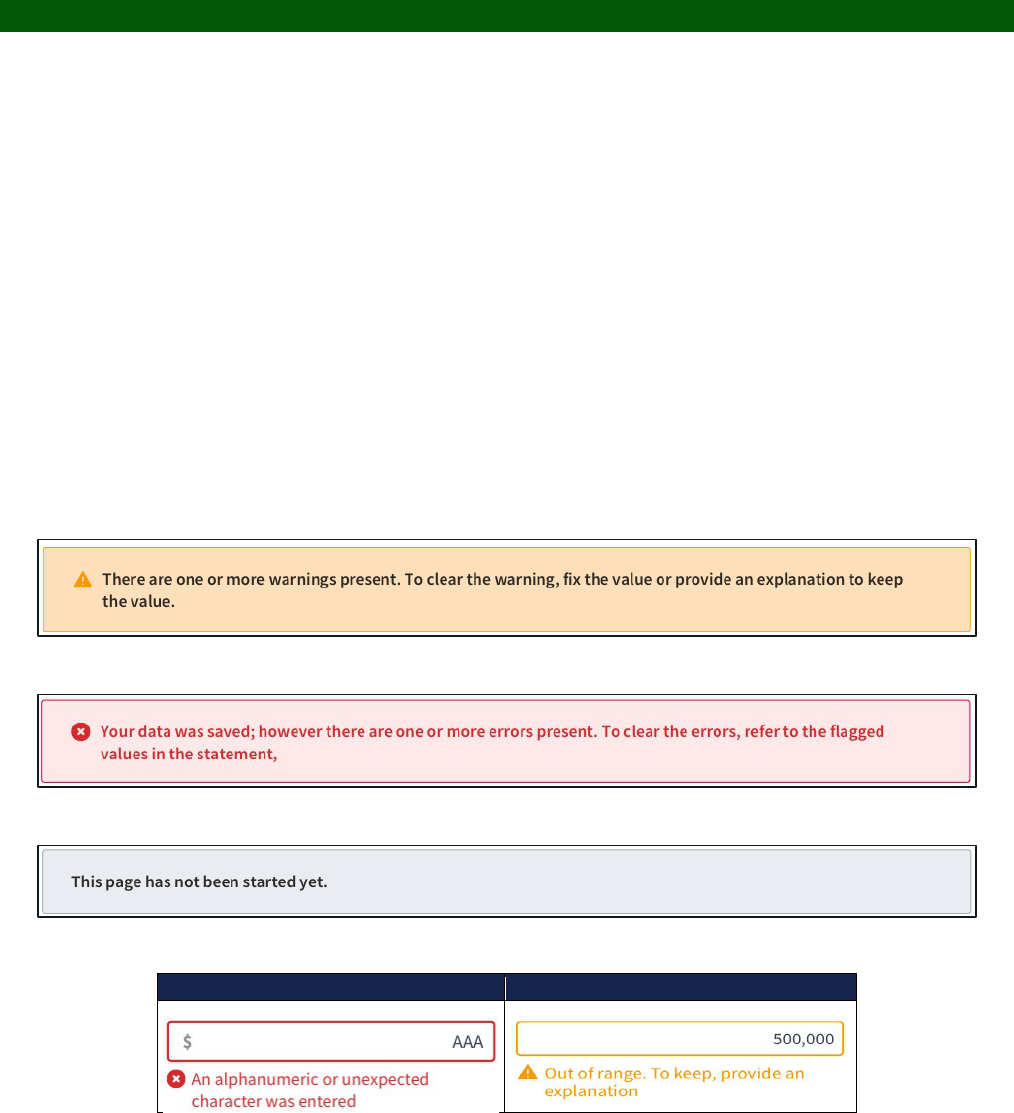
Rural Development Reporting & Compliance User Guide 83
Version 4, April 2024
Appendix A: System-Generated Message Types
Warnings and errors appear in a few different forms. Below are a few key words to help understand the
descriptions of these messages, where they appear, and what they mean.
• Statement: This may also be referred to as a report schedule or a page. This is a list of line items
that require values. Reports may include multiple statements.
• Line item: The Financial Report statements contain line items. Each line item consists of a value
(either for manual input, or auto calculated) and may include an Explanation column.
• Flagged values: This refers to the value(s) within a statement that have generated a warning or
error. The error or warning, which appears beneath the data entry field and describes the issue.
• Explanation: Certain statements include the ability to add descriptions to line items within the
statement. Some explanations are required.
Warnings are amber-colored, errors are red, and informative items are generally grey, blue or green.
Examples of banner notifications (usually at the top of the page):
Figure 66: Warning (Amber) Message
Figure 67: Error (Red) Message
Figure 68: Informative Message
Table 15: Examples of In-line Notifications Associated with Fields
Error (Red) Message
Warning (Amber) Message
Table 16 – Table 19 below provide a comprehensive list of the warnings, errors, and informative
messages available to display in the R&C. Search for the message you received to see its context and
solution.

Rural Development Reporting & Compliance User Guide 84
Version 4, April 2024
Table 16: R&C System Notifications - "Save Successful" Messages (Green color)
Type
Message
Cause
Solution
General
Notification
“[Statement Name]
has been saved
successfully.”
Appears on all pages where values are
entered, or documents are uploaded.
N/A
Financial Report
Notification
“Line item has been
successfully deleted.”
A custom line item has been successfully
deleted.
Occurs on:
• Non-Operating Net Income
• Statement of Cash Flows
N/A
Financial Report
Notification
“No outstanding
errors and/or
warnings present.”
No errors or warnings would prevent
submitting the report.
Occurs on the Review Report page and
appears beneath the name of a specific
statement.
Occurs on the Financial Report
N/A
Construction
Progress Report
Notification
“Construction
Progress Report has
been saved
successfully.”
The status on the Construction Status
page has been selected and the user
clicked [Save and Continue] or [Initiate
Certification].
Occurs on the Construction Progress
Report
N/A
Construction
Progress Report
Notification
“Clipped
successfully. Please
select “Save Data”
on the map to save
your progress.”
Construction progress was successfully
clipped and added to the map.
Occurs on the map in the Construction
Progress Report.
N/A
Construction
Progress Report
Notification
“The polygon has
been successfully
[added/uploaded].
Please select “Save
Data” on the map to
save your progress.”
Construction progress was successfully
added to the map.
Occurs on the map in the Construction
Progress Report.
N/A
Construction
Progress Report
Notification
“The Construction
Progress has been
removed. Please
select “Save Data”
on the map to save
your progress.”
Construction progress was successfully
removed from the map.
Occurs on the map in the Construction
Progress Report.
N/A
Construction
Progress Report
Notification
“Your data has been
saved successfully”
Construction progress was successfully
saved to the map by clicking the [Save
Data] button.
Occurs on the map in the Construction
Progress Report.
N/A

Rural Development Reporting & Compliance User Guide 85
Version 4, April 2024
Type
Message
Cause
Solution
Geospatial
Subscriber
Locations
Notification
"Geocoded
subscriber location(s)
were added to the
map successfully.
Please select "Save
Data" on the map to
complete the
upload."
The uploaded subscriber file successfully
added the subscriber locations to the map.
Occurs on the Geospatial Subscriber
Locations map.
N/A
Geospatial
Subscriber
Locations
Notification
“Your data has been
saved successfully.”
The user clicked the [Save Data] button on
the map and the subscriber locations were
successfully saved to the map.
N/A
Geospatial
Subscriber
Locations
Notification
“Deleted
successfully.”
The user clicked the [Remove Data] button
on the map and the subscriber locations
were successfully removed.
N/A
Table 17: R&C System Notifications - Informative Messages (Light Blue or White colors)
Type
Message
Cause
Solution
Financial
Report
Notification
“There are one or more items
that require your attention
before resubmitting the report.
View the note(s) from USDA
and make the necessary
corrections or
Contact Us if
you need assistance.”
Occurs on all statements.
Appears at the top of the affected
schedule, and on the Review
Report page for the Financial
Report.
View the note(s)
provided by USDA and
correct the report
before resubmitting.
Contact Us if you need
further assistance.
Financial
Report
Notification
“My Entity does not have any
[statement name] to report.”
Occurs on the Review Report
page and appears beneath the
name of a specific statement.
Applies to the following
statements.
• Network Access Services
Revenue
• Non-Operating Net Income
N/A
Financial
Report
Notification
“This page has not been
started yet.”
There is a statement has not
been started.
Occurs on the Review Report
page and appears beneath the
name of a specific statement.
Occurs on the Financial Report
Return to the flagged
statement and address
all required fields.

Rural Development Reporting & Compliance User Guide 86
Version 4, April 2024
Table 18: R&C System Notifications - Warning Messages (Amber color)
Type
Message
Cause
Solution
Financial
Report
Notification
“There are one or more warnings present. To
clear the warning, fix the value or provide an
explanation to keep the value.”
At least one line item
on the statement is
generating a flag.
Occurs on:
• Non-Operating Net
Income
• Income Statement
• Balance Sheet
• Statement of Cash
Flows
To submit the
statement, all
warnings must be
resolved by
correcting the
values or providing
an explanation.
Financial
Report
Notification
“[Statement Name] has been saved
successfully. Please visit and re-save the
Statement of Cash Flows to update the
calculations with changes made on this
statement.”
Changes made to the
Income Statement or
Balance Sheet may
affect the calculations
in the Statement of
Cash Flows.
Occurs on:
• Income Statement
• Balance Sheet
To ensure that the
Statement of Cash
Flows calculates
using the most
recent data, visit the
Statement of Cash
Flows and re-save
the page.
Financial
Report
Notification
“Explanation is required when a value is not
entered”
Occurs on:
• Non-Operating Net
Income
• Balance Sheet
• Income Statement
Either provide a
value or an
explanation for the
blank field
Financial
Report
Notification
“Typically, greater than zero. To keep,
provide an explanation”
Appears beneath fields
on:
• Balance Sheet
• Income Statement
To justify the entry
of zero, provide an
explanation, or
change the value.
Financial
Report
Notification
“Typically, greater than 1. To keep, provide
an explanation”
Appears beneath fields
on the Balance Sheet
To justify the entry
of one, provide an
explanation, or
change the value
Financial
Report
Notification
“Explanation is required when a custom line
item is created”
Appears beneath fields
on:
• Statement of Cash
Flows
• Non-Operating Net
Income
You must provide
an explanation for
this line item.

Rural Development Reporting & Compliance User Guide 87
Version 4, April 2024
Type
Message
Cause
Solution
Financial
Report
Notification
“There are one or more warnings present on
this page. To clear the warnings, correct the
flagged values or provide an explanation.”
There is at least one
warning on a
statement within the
Report.
Occurs on the Review
Report page beneath
the names of each
statement that requires
attention.
Applies to the
Financial Report
To submit the
report, resolve all
warnings by
correcting values or
providing
explanations.
Construction
Progress
Report
Notification
“A portion of the drawn or uploaded
Construction Progress lies outside of the
Approved Project Service Area. Construction
Progress can be saved but the area that lies
outside of the Approved Project Service Area
will be clipped to the boundaries of the
Approved Project Service Area.
“Do you want to proceed?”
Part of uploaded or
drawn construction
progress falls outside
of the Approved
Project Service Area.
No progress can be
reported outside of the
approved service area.
Occurs on the map in
the Construction
Progress Report.
If [Ok] is clicked, the
map will
automatically clip
the progress so that
none of it falls
outside of the
Approved Project
Service Area. If
[Cancel] is clicked,
then the uploaded
or drawn
construction
progress will not be
added to the map.
Construction
Progress
Report
Notification
“Your entity indicated that construction is
complete, but the Approved Project Service
Area is XX.XX% not 100% covered by your
polygon. Please update the map or change
what your entity has indicated it is reporting.”
The selection made on
the Construction
Status page indicated
progress has been
completed, however
the reported progress
on the map has not
covered the Service
Area.
Occurs on the map in
the Construction
Progress Report.
To initiate
certification of the
Construction
Progress Report,
the entire Service
Area must be
covered by
Construction
Progress.

Rural Development Reporting & Compliance User Guide 88
Version 4, April 2024
Type
Message
Cause
Solution
System Data
Report
Notification
“There is a warning present on the page. To
clear the warning, provide an explanation or
change the selection.”
The selection made on
Depreciation Rates
differs from the prior
year selection.
Occurs at the top of
the page and remains
until the missing
explanation is saved to
the statement or the
selection is updated.
Applies to the following
statement:
Depreciation Rates
To submit the
statement, either
provide an
explanation for the
new selection or
revert back to the
original selection.
Table 19: R&C System Notifications - Error Messages (Red color)
Type
Message
Cause
Solution
General Notification
“There are one or more reports that
require your attention.”
At least one report has
either missed the due
date; requires edits
requested by the Rep
Sign Cert; or requires
resubmission
addressing USDA
concerns noted in the
report.
Occurs on the Reports
page
Submit the late
report, re-edit the
report or resubmit it
to USDA with
changes.
General Notification
“[Statement Name] could not be
saved due to a system error.
Please try again.”
Possible reasons for
the system error
include the loss of
internet connection,
loss of server
connection, or servers
down.
Occurs on all pages
where values are
entered, or documents
uploaded.
User should check
their internet
connections and try
again until
successful. If issue
persists
Contact Us
for assistance.
General Notification
“Must be provided” or “Document is
required”
Appears for all required
line items, fields, and
uploads which have
not yet been provided.
Provide the
required value or
upload the required
file.

Rural Development Reporting & Compliance User Guide 89
Version 4, April 2024
Type
Message
Cause
Solution
Financial Report
Notification
“Your data could not be saved as
there are one or more critical errors
present. To clear the errors, refer to
the flagged values in the statement
before proceeding.”
At least one line item
includes a letter or
special character.
Occurs on all
statements.
Remove the
letter(s) or special
character(s) and re-
save the statement.
Financial Report
Notification
“Your data was saved; however
there are one or more errors
present. To clear the errors, refer to
the flagged values in the
statement.”
There is at least one
error on the statement.
Occurs on all
statements, except for
the following:
• Non-Operating Net
Income
• Network Access
Services Revenue
To submit the
statement, all errors
must be resolved by
correcting the
flagged line items.
Financial Report
Notification
“Your Entity indicated that there are
values to report. Please provide
values for all items based on the
selection.”
The selection made on
the statement indicated
there are values to
report; however, no
values were provided.
Occurs on:
• Subscriber Data
All required values
must be provided,
or the selection
must be changed to
resolve the error.
Financial Report
Notification
“An alphanumeric or unexpected
special character was entered”
Appears beneath fields
on:
• Network Access
Services Revenue
• Non-Operating Net
Income
• Income Statement
• Balance Sheet
• Statement of Cash
Flows
• Subscriber Data
Remove any letters
or special
characters from the
entry and save the
change.
Financial Report
Notification
“Must be positive”
Appears beneath fields
on:
• Network Access
Services Revenue
• Non-Operating Net
Income
• Subscriber Data
Replace the
negative value with
a positive number
and save the
change.

Rural Development Reporting & Compliance User Guide 90
Version 4, April 2024
Type
Message
Cause
Solution
Financial Report
Notification
“Must be provided when broadband
subscribers are reported”
Appears beneath fields
on:
• Subscriber Data
Provide a value to
resolve the error.
Financial Report
Notification
“There is already an account with
this name”
The unique custom
account name
provided has already
been used.
Appears beneath fields
on:
• Non-Operating Net
Income
• Statement of Cash
Flows
Assign a different
unique name to
resolve the error.
Financial Report
Notification
“Value must = ‘Total Liabilities and
Equity’”
“Total Assets” must
equal the “Total
Liabilities and Equity”
line item.
Appears beneath the
“Total Assets” field on:
• Balance Sheet
Update values on
the Balance Sheet
(or on sheets that
feed information to
the Balance Sheet)
to ensure that Total
Assets = Total
Liabilities & Equity
and re-save the
page.
Financial Report
Notification
“Value must = ‘Total Assets’”
“Total Liabilities and
Equity” must equal
the:” Total Assets” line
item.
Appears beneath the
“Total Liabilities and
Equity” field on:
• Balance Sheet
Update values on
the Balance Sheet
(or on sheets that
feed information to
the Balance Sheet)
to ensure that Total
Assets = Total
Liabilities & Equity
and re-save the
page.

Rural Development Reporting & Compliance User Guide 91
Version 4, April 2024
Type
Message
Cause
Solution
Financial Report
Notification
“Must equal ‘Cash & Equivalents’
plus ‘Cash-RUS Construction
Fund’”
Appears beneath the
“Ending Cash” field on:
• Statement of Cash
Flows
Ensure that “Cash
& Equivalents” +
“Cash-RUS
Construction Fund”
on the Balance
Sheet = “Ending
Cash” on the
Statement of Cash
Flows. Update
values on
statement(s) and
re-save them.
Follow warnings to
save other
statements that
may occur.
Financial Report
Notification
“The report has one or more errors
and/or unexplained warnings on
the pages below, or a page hasn’t
been started. Refer to the flagged
items on each page to clear the
errors and/or warnings.”
There is at least one
error or warning on a
statement, or a
statement has not
been started.
Occurs on the Review
Report page after
attempting to Initiate
Report Certification or
Submit to USDA.
Occurs on the
Financial Report
To submit the
report, complete all
statements, and
resolve all errors by
correcting values or
providing
explanations.
Financial Report
Notification
“There are one or more errors
present on this page. To clear the
errors, refer to the flagged values in
the statement.”
There is at least one
error on a statement
within the Report.
Occurs on the Review
Report page beneath
the names of each
statement that requires
attention.
Occurs on the
Financial Report
To submit the
report, resolve all
errors by correcting
values or providing
explanations.

Rural Development Reporting & Compliance User Guide 92
Version 4, April 2024
Type
Message
Cause
Solution
Construction Progress
Report Notification
“Construction Status signifies work
has been performed for the current
reporting period. If construction has
not been performed and updates to
the Construction Progress Map do
not need to be made, please
update the construction status.”
The selection made on
the Construction Status
page indicated
progress had been
made or completed,
however no map data
was saved.
Occurs on the
Construction Progress
Report.
To certify and
submit the
Construction
Progress Report,
the status selection
must be changed,
or the required map
data must be
provided.
Construction Progress
Report Notification
“Construction Status signifies work
has not been performed for the
current reporting period. If
construction has been performed
and updates to the Construction
Progress Map need to be made,
please update the construction
status.”
The selection made on
the Construction Status
page indicated
progress had not been
made or completed,
however map data was
saved.
Occurs on the
Construction Progress
Report
To certify and
submit the
Construction
Progress Report,
the status selection
must be changed,
or the provided map
data must be
removed.
Construction Progress
Report Notification
“Please select Completion Date
before Saving.”
The selection made on
the Construction Status
page indicated
progress has been
completed, however no
completion date has
been entered.
Occurs on the
Construction Progress
Report
To advance to the
next page of the
Construction
Progress Report,
enter a date into the
Completion Date
field.
Construction Progress
Report Notification
“Upload Failed. Please upload a file
containing .dbf,. prj, .shp and .shx
files(s)”
The file uploaded is not
in the right format so it
cannot be uploaded to
the map.
Occurs on the map in
the Construction
Progress Report.
To add construction
progress to the
map, the uploaded
file must be a zip
file containing .dbf,.
prj, .shp and .shx
file(s).

Rural Development Reporting & Compliance User Guide 93
Version 4, April 2024
Type
Message
Cause
Solution
Construction Progress
Report Notification
“The polygon(s) added to the map
contain intersecting polygons
and/or overlaps with polygons that
were previously added to the map
for this reporting period. Please edit
or remove the intersecting vertices
before attempting to save your
construction progress.”
The added
Construction Progress
layer overlaps with
another Construction
Progress layer that
was already added for
that year.
Occurs on the map in
the Construction
Progress Report.
To initiate
certification of the
Construction
Progress Report,
the Construction
Progress layers for
the current year
may not overlap.
Geospatial Subscriber
Locations Notification
"File type not supported."
The uploaded
subscriber file is not a
.xls or .xlsx file.
Occurs on the
Geospatial Subscriber
Locations map.
To upload
subscribers to the
map, the user must
upload a .xls or
.xlsx file.
Geospatial Subscriber
Locations Notification
“The file was unable to upload. You
are required to use the Reporting &
Compliance Geocoded Subscriber
Locations Excel file to report the
geospatial location of subscribers."
The uploaded
subscriber file is not in
the same format as the
required Geocoded
Subscriber Location
template file.
Occurs on the
Geospatial Subscriber
Locations map.
To upload
subscribers to the
map, the user must
complete and
upload a Geocoded
Subscriber Location
template file.
Geospatial Subscriber
Locations Notification
"Beginning at row (missing data
rows) there is missing data for one
or more of the fields within the
uploaded file. For the geographical
fields, ensure that either the
Address, City, State, and Zip Code;
or the Latitude or Longitude
coordinates have been provided.
For all other remaining fields,
ensure that data is provided before
uploading the file again. Refer to
the instructions in the Geocoded
Subscriber Locations Excel file for
additional guidance."
The uploaded
subscriber file is
missing values in
required cells.
Occurs on the
Geospatial Subscriber
Locations map.
To upload
subscribers to the
map, the filled out
Geocoded
Subscriber Location
template file cannot
be missing any
values in cells.

Rural Development Reporting & Compliance User Guide 94
Version 4, April 2024
Type
Message
Cause
Solution
System Data Report
Notifications
“Your Entity indicated that there are
values to report. Please provide
values for one or more items.”
The selection made on
the statement indicated
there are values to
report; however, no
values have been
provided.
Occurs on the Review
Statement page and
the data entry page for
the following
statements:
• Depreciation Rates
• Capital Investment
Data
All required values
must be provided,
or the selection
must be changed to
resolve the error.
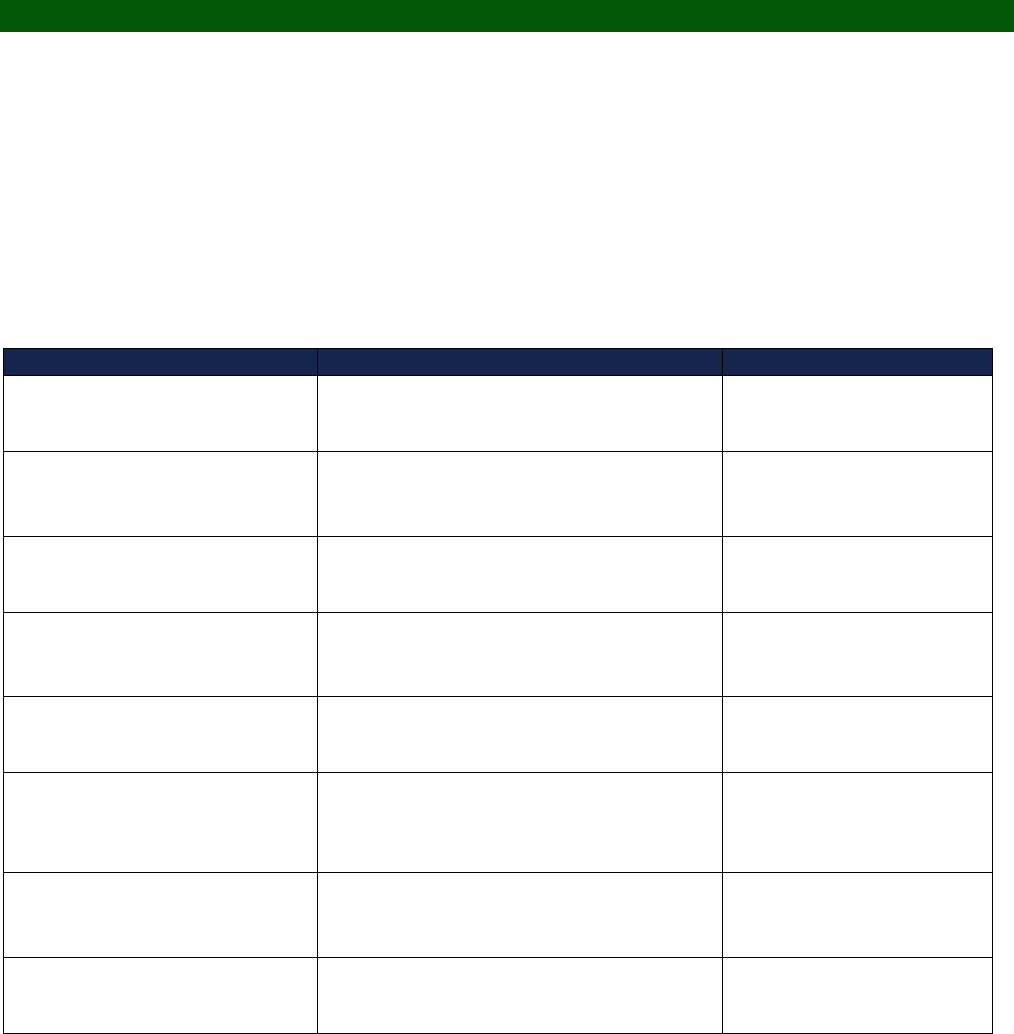
Rural Development Reporting & Compliance User Guide 95
Version 4, April 2024
Appendix B: System-Generated Email Notifications
Email notifications will include the following information:
• Entity Name
• Specific report name (if applicable)
• Reporting period end date (if applicable)
• Action the user needs to take (if any)
• Link to R&C
Email notifications are sent to users in the following circumstances:
Table 20: Email Notifications
Automated Email Name
Event Triggering the Email Generation
Users Receiving the Email
Approved Authorized
Representative Request
This email is generated when the submitted
ARR is approved by USDA.
All users listed on the ARR
Authorized Representative
Request Resubmission
Requested
This email is generated when the submitted
ARR is rejected by USDA.
ARR submitter
New report available
This email is generated when a new report
is available on the Reports dashboard.
All users on the entity's
account
Report Pending Certification
This email is generated when the report
certification is initiated for the Rep Sign
Cert.
Rep Sign Cert
Edits are Required for the Report
This email is generated when the report is
sent back by Rep Sign Cert for edits.
All users on the entity's
account
Report Successfully Submitted
This email is generated when the report is
successfully submitted to USDA by the Rep
Sign Cert.
All users on the entity's
account
Report Resubmission Requested
This email is generated when USDA has
requested the resubmission of a submitted
report.
All users on the entity's
account
Report Accepted by USDA
This email is generated when the submitted
report is accepted by USDA.
All users on the entity's
account
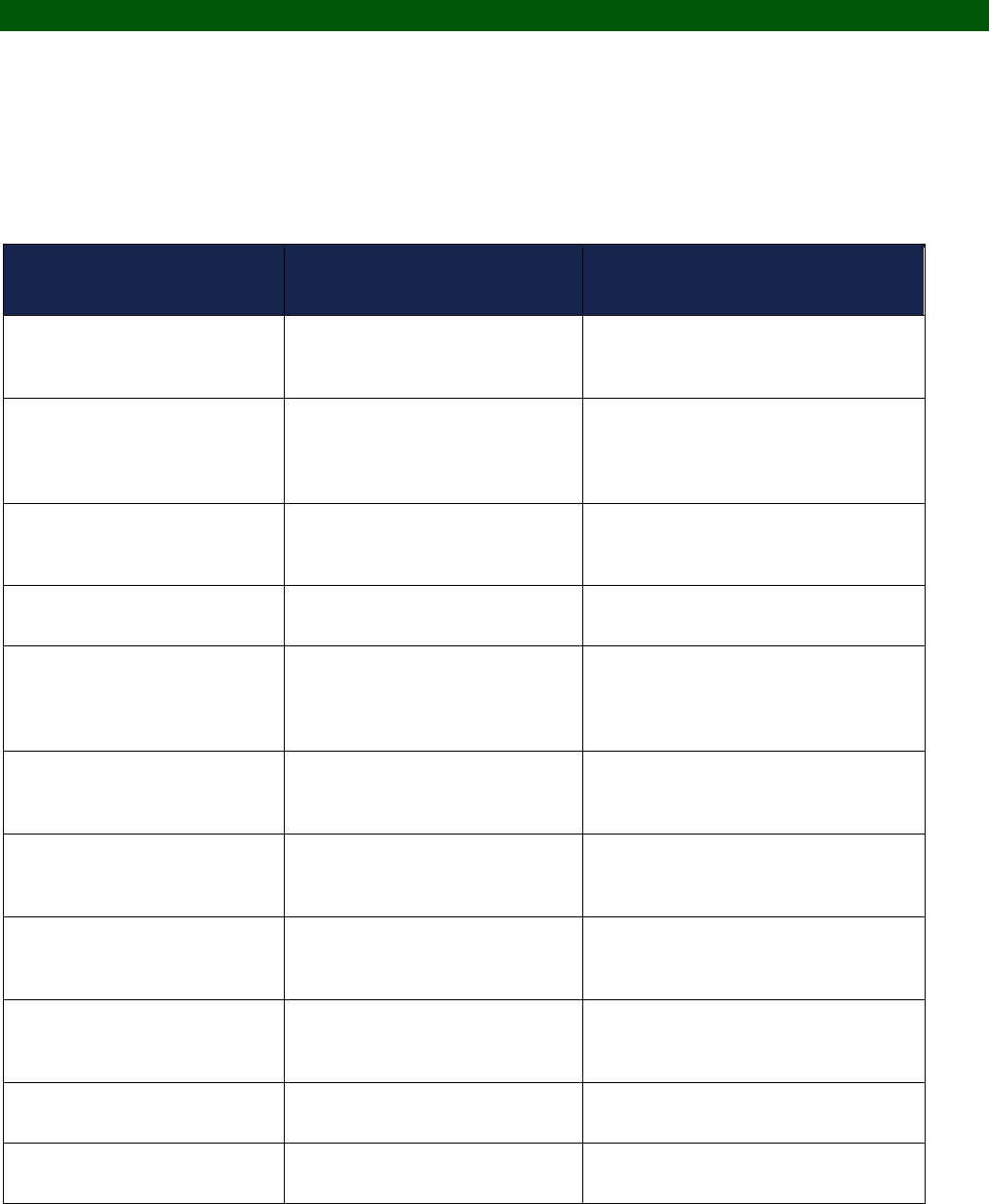
Rural Development Reporting & Compliance User Guide 96
Version 4, April 2024
Appendix C Network Access Services Revenue Line Item Expansion
RUS has updated the Network Access Services Revenue Schedule of the Financial Report. Some Line
Item labels were modified to increase clarity, and new Line Items were added. In addition, the update
provided descriptions of the Line Items and links to detailed information on many of them. Table 21
provides a crosswalk between the schedule’s line items.
Table 21: Network Access Services Revenue Line Items
NOTE: Additions and changes are shown in bold text.
Old Line Item Label
New Line Item Label As Of
Report Ending December 31,
2021
Description/Notes
Federal Subscriber Line
Charges
End User Federal Subscriber
Line Charges
Charges assessed to recover the
interstate costs of providing a line to a
home or business.
End User State Subscriber
Line Charges
As permitted by a state, charges to
recover the intrastate costs of
providing a line to a home or
business.
Federal Consumer Broadband
Only Loop Charges
End User Federal Broadband
Only Loop Charges
Charges assessed for lines without
regulated local exchange voice
service provided.
Federal Access Recovery
Charges
End User Federal Access
Recovery Charges
End user charges to assist with
intercarrier compensation reform.
Model Based Support (CAM or
A-CAM)
Federal USF Model Based High
Cost Support (CAM, A-CAM,
REVISED A-CAM, Enhanced A-
CAM)
High-cost support based on forward-
looking network engineering models.
Federal USF Auction Support
(RBE, CAF II, RDOF)
High-cost support provided for
specific geographic areas to winners
of reverse auctions.
Federal High Cost Loop
Support
Federal USF High Cost Loop
Support
High-cost support for last mile loops
with costs exceeding 115% of the
national average.
Connect America Fund -
Broadband Loop Support
(Formerly ICLS)
Federal USF Connect America
Fund - Broadband Loop Support
(Formerly ICLS)
High-cost support for voice and
broadband only loops.
Federal USF Frozen High Cost
Support
High-cost support frozen at 2011
levels pending transfer to other forms
of high-cost support.
Federal USF Alaska Plan
Support
High-cost support for certain Alaska
telecommunications companies.
State Support
State Universal Service
Support
Support provided by a state's
universal service fund, if any.
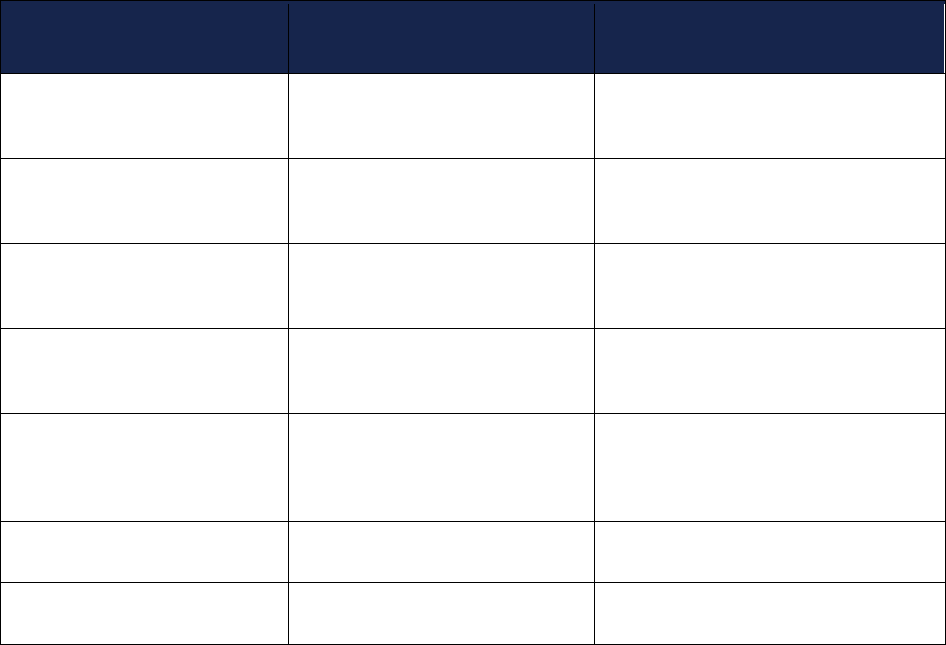
Rural Development Reporting & Compliance User Guide 97
Version 4, April 2024
Old Line Item Label
New Line Item Label As Of
Report Ending December 31,
2021
Description/Notes
Connect America Fund
Intercarrier Compensation
Federal USF Connect America
Fund - Intercarrier
Compensation Support
High-cost support to cover Access
Recovery Charge revenue shortfalls.
Interstate Switched Access
Revenue
Carrier Interstate Switched
Access Charges
Tariffed charges to recover costs for
originating and terminating long
distance calls.
Intrastate Switched Access
Revenue
Carrier Intrastate Switched
Access Charges
As permitted by a state, charges to
recover costs for originating and
terminating long distance calls.
Interstate Special Access
Revenue
Interstate Special Access
Charges (aka, Business Data
Services Charges)
Charges to recover the costs of
providing a dedicated interstate line to
a customer.
Intrastate Special Access
Intrastate Special Access
Charges
As permitted by a state, charges to
recover the costs of providing a
dedicated intrastate line to a
customer.
Other Network Access
Services Revenue
Any network access services revenue
not included above.
Total Network Access Services
Revenue
Total Network Access Services
Revenue
Calculated by the system.

Rural Development Reporting & Compliance User Guide 98
Version 4, April 2024
Appendix D: Accounting Guidance for Grant Revenue
While filling out the requested information within the Financial Report, awardees must be mindful that
their entity type will affect how grant revenue is reported. The following four primary entity types follow
unique accounting requirements, and each would report the grant revenue slightly different in their
audited financial statements, which may require them to report them differently in the required financial
reporting to RUS.
D1: Utility Cooperatives and Regulated Companies
Utility Cooperatives that follow the respective electric and telecommunications RUS Uniform System of
Accounts (USOA) and are exempt from federal income tax under Internal Revenue Service Code
501(c)(12) would follow the guidance allowed under the USOA and Generally Accepted Accounting
Principles for regulated entities (ASC 980). The USOA allows for recognition of the grant as a
“contribution in aid of construction (CIAC)” which reduces the amount of the asset capitalized and is not
reported as income.
D2: Governmental Entities, Indian Tribes, Territories and Possession of the United
States
These entities are required to report under standards promulgated by the Government Accounting
Standard Board (GASB) would recognize the grant as operating revenue at the time of receipt. GASB
Statement 34 requires Enterprise Funds to record capital and operating grants as “program revenues”,
which are revenues from the “program or from parties outside the reporting government’s taxpayers or
citizenry, as a whole, that reduce the net costs of the function to be financed from the general
government’s general revenues.” For governmental entities, grant revenue is typically treated as
operating income.
D3: Not-For-Profit Organizations
Not-for-profit organization, as defined at 2 CFR Part 200.70, means any corporation, trust, association,
cooperative, or other organization, not including Institutions of Higher Learning (IHEs), that:
• Is operated primarily for scientific, educational, service, charitable, or similar purposes in the public
interest
• Is not organized primarily for profit and
• Uses net proceeds to maintain, improve, or expand the operations of the organization.
These entities, along with governmental entities, are considered non-federal entities under 2 CFR Part
200.69. Not-For-Profit organizations, as defined by the Financial Accounting Standards Board (FASB),
which specifically excludes utility cooperatives. The primary accounting standards for these entities
provide that the entity recognize grant revenue as operating revenue but the assets (including cash)
resulting from the grant may be classified as “temporarily restricted” until all grant requirements have
been met.
D5: For-Profit Entities
For-profit entities include all organizational types that are in the business of providing broadband or
other services for a profit (LLCs, Corporations, S Corporations, individually owned and publicly traded
corporations, etc.). These entities report under FASB standards and are subject to the revenue
recognition model. In recognizing revenue, the entity must determine whether it is an exchange
transaction or contribution. RUS grants are a contribution type transaction and RUS’ compliance
requirements for providing service for the economic life of the loan; and building out the entire project

Rural Development Reporting & Compliance User Guide 99
Version 4, April 2024
for the Project Service Area to the specifications acceptable to RUS, would defer recognition of the
grant. Based on the government’s ability to disallow or request grant funds be returned to Treasury,
these entities would defer grant revenue and recognize it over the course of the economic life of the
plant. Grant revenue is not part of the normal course of operations and is not a recurring revenue
stream and, therefore, should be reported as non-operating revenue.
Table 22: Grant Accounting Guidance
Schedule
Line Item
Guidance
Applies To
Guidance
Does Not
Apply To
Guidance/Comments
Income
Statement
Amortized Grant
Revenue
For-Profit
Entities
Cooperatives
using
deferred
revenue
recognition
for grants
Not-For Profit
Entities
Governmental
Entities
Cooperatives
using CIAC
For-Profit: Amortize over the composite
economic life of facilities constructed using
grant funds.
Cooperatives using the deferred
revenue recognition method for grants
should amortize over the composite
economic life of the facilities constructed
using grant funds.
Not-For-Profit; Governmental Entities:
Record the full amount of grant revenue
received in a year on this Line Item.
Cooperatives using the Contribution In
Aid of Construction (CIAC) method
would not use this account.
Balance
Sheet
Deferred Grant
Revenue
For-Profit
Entities
Cooperatives
using
deferred
revenue
recognition
Cooperatives
using CIAC
Not-For-
Profit Entities
Government
Entities
For-Profit: Record the amount of grant
revenue that has been deferred.
Cooperatives using the deferred
revenue recognition method for grants
record the amount of grant revenue that
has been deferred.
Cooperatives-CIAC; Not-For- Profit;
Government Entities: Do not use this line
item because grant revenue is recognized
at the time it was received.
Statement
of Cash
Flows
Capital
Expenditures ––
Plant Constructed
Using Grant
Proceeds
All entities
n/a
Record amounts for plant assets
constructed using grant funds on this Line
Item. This is the cash outflow from grant
proceeds used to construct plant assets.
Statement
of Cash
Flows
Proceeds from
Grant Funds
All entities
n/a
Record grant funds received to construct
plant assets on this Line Item. Exclude
grant proceeds used to reimburse pre-
application expenses.

Rural Development Reporting & Compliance User Guide 100
Version 4, April 2024
Appendix E: Example of Reconciled Statement of Cash Flows
The table below shows how R&C uses previous data and current data to calculate line items in the Statement of Cash Flows. The left
column shows the line item name. The middle column shows an example of the historical calculation, and the right column shows a
“current year” example, with the current year being 2020.
Table 23: Reconciled Statement of Cash Flows Example
Line Item
Historical
Current
Show Prior Year, Prior Period, Statement of
Cash Flows June 30, 2019
Example: June 30, 2020
1. Beginning Cash (for Q1, Q2, Q3, and Q4)
Prior Year, CY-End Q4, 2018
Prior Year, CY-End Q4, 2019
CASH FLOWS FROM OPERATING ACTIVITIES
2. Net Income (Loss)
This Year, This Period Q2, 2019 (YTD)
This Year, This Period Q2, 2020 (YTD)
ADJUSTMENTS TO RECONCILE NET INCOME (LOSS) TO NET CASH PROVIDED BY OPERATING ACTIVITIES
3. Add: Depreciation
This Year, This Period Q2, 2019 (YTD)
This Year, This Period Q2, 2020 (YTD)
4. Add: Amortization
This Year, This Period Q2, 2019 (YTD)
This Year, This Period Q2, 2020 (YTD)
5. Other (Explain)
This Year, This Period Q2, 2019 (YTD) if
entered
Manual entry (YTD)
CHANGES IN OPERATING ASSETS & LIABILITIES
6. Decrease/(Increase) in Accounts
Receivable
((Prior Year, CY-End) – (Current Year, Current
Period)) ((Q4, 2018) – (Q2, 2019))
((Prior Year, CY-End) – (Current Year, Current
Period)) ((Q4, 2019) – (Q2, 2020))
7. Decrease/(Increase) in Materials &
Inventory
((Prior Year, CY-End) – (Current Year, Current
Period)) ((Q4, 2018) – (Q2, 2019))
((Prior Year, CY-End) – (Current Year, Current
Period)) ((Q4, 2019) – (Q2, 2020))
8. Decrease/(Increase) in Other Current
Assets, Interest, and Dividends Receivable
((Prior Year, CY-End) – (Current Year, Current
Period)) ((Q4, 2018) – (Q2, 2019))
((Prior Year, CY-End) – (Current Year, Current
Period)) ((Q4, 2019) – (Q2, 2020))
9. Increase/(Decrease) in Accounts Payable
((Prior Year, CY-End) – (Current Year, Current
Period)) ((Q4, 2018) – (Q2, 2019))
((Prior Year, CY-End) – (Current Year, Current
Period)) ((Q4, 2019) – (Q2, 2020))

Rural Development Reporting & Compliance User Guide 101
Version 4, April 2024
Line Item
Historical
Current
10. Increase/(Decrease) in Other Current
Liabilities
((Prior Year, CY-End) – (Current Year, Current
Period)) ((Q4, 2018) – (Q2, 2019))
((Prior Year, CY-End) – (Current Year, Current
Period)) ((Q4, 2019) – (Q2, 2020))
11. Net Cash Provided/(Used) by
Operations
Calculated field (SUM #2 - #10)
Calculated field (SUM #2 - #10)
12. Capital Expenditures (Excluding Plant
Constructed Using Grant Proceeds)
This Year, This Period Q2, 2019 (YTD) if
entered
Manual entry (YTD)
13. Capital Expenditures - Plant Constructed
Using Grant Proceeds
This Year, This Period Q2, 2019 (YTD) if
entered
Manual entry (YTD)
14. Other Long-Term Investments
((Prior Year, CY-End) – (Current Year, Current
Period)) ((Q4, 2018) – (Q2, 2019))
((Prior Year, CY-End) – (Current Year, Current
Period)) ((Q4, 2019) – (Q2, 2020))
15. Increase/(Decrease) in Intangible Assets
((Prior Year, CY-End) – (Current Year, Current
Period)) ((Q4, 2018) – (Q2, 2019))
((Prior Year, CY-End) – (Current Year, Current
Period)) ((Q4, 2019) – (Q2, 2020))
16. Other Noncurrent Assets
((Prior Year, CY-End) – (Current Year, Current
Period)) ((Q4, 2018) – (Q2, 2019))
((Prior Year, CY-End) – (Current Year, Current
Period)) ((Q4, 2019) – (Q2, 2020))
17. Other (Explain)
This Year, This Period Q2, 2019 (YTD) if
entered
Manual entry (YTD)
18. Net Cash Provided/(Used) by Investing
Activities
Calculated field (SUM #12 - #17)
Calculated field (SUM #12 - #17)
19. Decrease/(Increase) in Notes Receivable
((Prior Year, CY-End) – (Current Year, Current
Period)) ((Q4, 2018) – (Q2, 2019))
((Prior Year, CY-End) – (Current Year, Current
Period)) ((Q4, 2019) – (Q2, 2020))
20. Increase/(Decrease) in Notes Payable &
Lines of Credit
((Prior Year, CY-End) – (Current Year, Current
Period)) ((Q4, 2018) – (Q2, 2019))
((Prior Year, CY-End) – (Current Year, Current
Period)) ((Q4, 2019) – (Q2, 2020))
21. Net Increase/(Decrease) in Long Term
Debt (Including Current Maturities)
((Prior Year, CY-End) – (Current Year, Current
Period)) ((Q4, 2018) – (Q2, 2019))
((Prior Year, CY-End) – (Current Year, Current
Period)) ((Q4, 2019) – (Q2, 2020))
22. Decrease/(Increase) in Unapplied
Payments – Cushion of Credit
((Prior Year, CY-End) – (Current Year, Current
Period)) ((Q4, 2018) – (Q2, 2019))
((Prior Year, CY-End) – (Current Year, Current
Period)) ((Q4, 2019) – (Q2, 2020))
23. Increase/(Decrease) in Other Liabilities &
Deferred Credits
((Prior Year, CY-End) – (Current Year, Current
Period)) ((Q4, 2018) – (Q2, 2019))
((Prior Year, CY-End) – (Current Year, Current
Period)) ((Q4, 2019) – (Q2, 2020))

Rural Development Reporting & Compliance User Guide 102
Version 4, April 2024
Line Item
Historical
Current
24. Increase/(Decrease) in Capital Stock,
Paid-in-Capital, Membership and Capital
Certificates & Other Capital
((Prior Year, CY-End) – (Current Year, Current
Period)) ((Q4, 2018) – (Q2, 2019))
((Prior Year, CY-End) – (Current Year, Current
Period)) ((Q4, 2019) – (Q2, 2020))
25. Proceeds from Grant Funds
This Year, This Period Q2, 2019 (YTD) if
entered
Manual entry (YTD)
26. Less: Distributions (Payment of
Dividends, Patronage Capital Credits
Retired, or any other Distribution)
This Year, This Period Q2, 2019 (YTD) if
entered
Manual entry (YTD)
27. Other (Explain)
This Year, This Period Q2, 2019 (YTD) if
entered
Manual entry (YTD)
28. Net Cash Provided/(Used) by
Financing Activities
Calculated field (SUM #19 - #27)
Calculated field (SUM #19 - #27)
29. Net Increase/(Decrease) in Cash
Calculated field (#11 + #18 + #28)
Calculated field (#11 + #18 + #28)
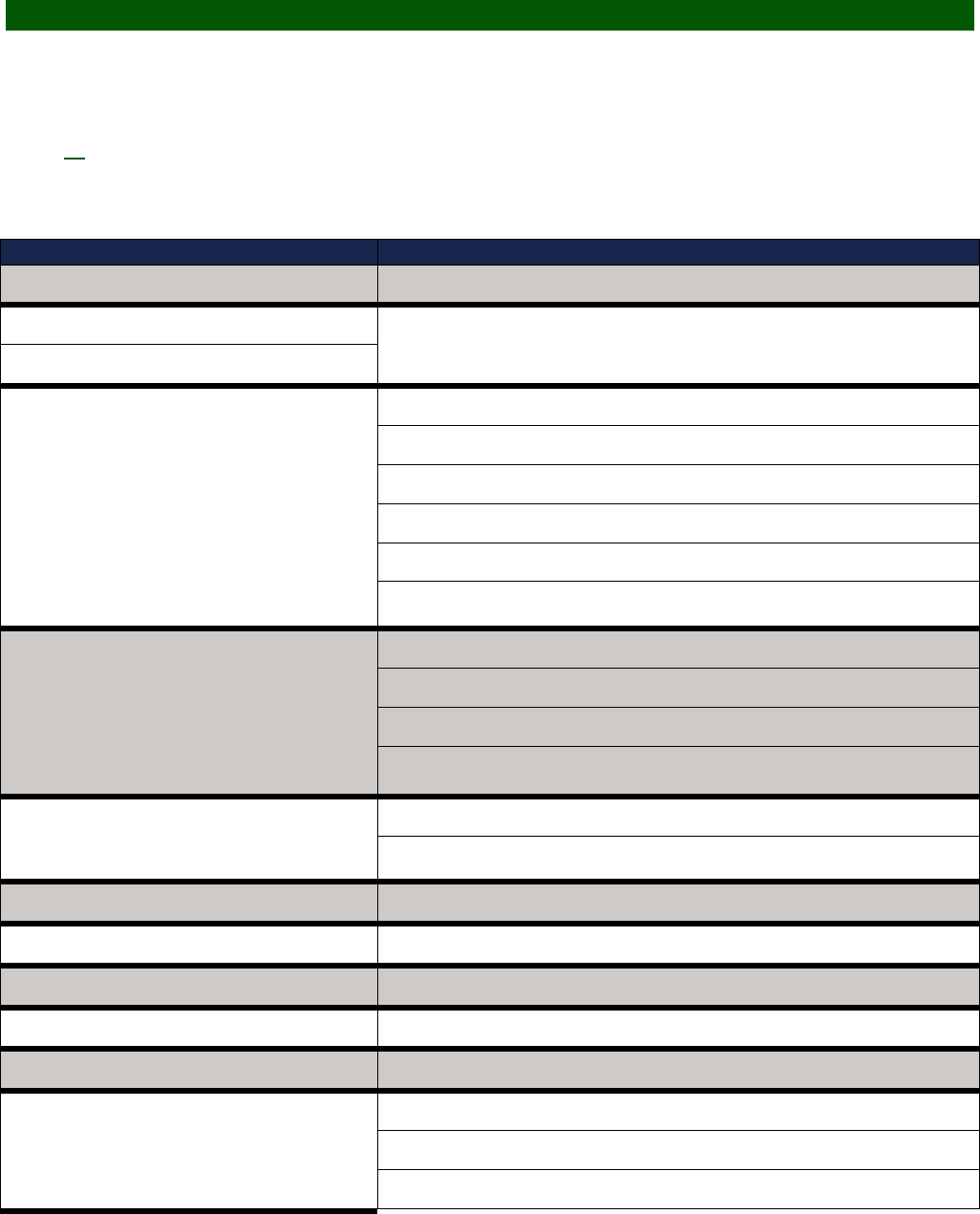
Rural Development Reporting & Compliance User Guide 103
Version 4, April 2024
Appendix F: Depreciation Rates Crosswalk
Depreciation rates may be reported differently in the Data Collection System (DCS) and R&C. Table 24
is a crosswalk that shows how depreciation rates in DCS correspond to those used in R&C on the
System Data Report, Depreciation Rate Schedule.
Table 24: Depreciation Rate Categories Crosswalk Between DCS and R&C
NOTE: An empty cell in the table denotes that either DCS or R&C does not have a corresponding
category.
DCS Reporting Category
R&C Reporting Category
1a. Motor Vehicles
Support Assets – 44 Motor Vehicles
1b. Aircraft
Support Assets – 45 Special Purpose Vehicles
1c. Special Purpose Vehicles
1d. Garage and Other Work Equipment
Support Assets – 42 Construction Vehicles
Support Assets – 43 Construction Equipment
Support Assets – 49 Test Equipment
Support Assets – 50 Portable Generators
Support Assets – 51 Tools
Support Assets – 5 Other Support Assets
1e. Buildings
Buildings – 26 New Construction
Buildings – 27 Pre-Fab Huts
Buildings – 28 Improvements
Buildings – 29 Other - Buildings
1f. Furniture and Office Equipment
Support Assets – 46 Office Equipment
Support Assets – 47 Office Furniture
1g. General Purpose Computers
Support Assets – 48 Billing System
2a. Digital
Network & Access Equipment – 5 Video Equipment
2b. Analog and Electro-Mechanical
Network & Access Equipment – 1 Switching Equipment
2c. Operator Systems
3a. Radio Systems
Network & Access Equipment – 7 Satellite Equipment
3b. Circuit Equipment
Network & Access Equipment – 2 Routing Equipment
Network & Access Equipment – 3 Transport Equipment
Network & Access Equipment – 4 Access Equipment

Rural Development Reporting & Compliance User Guide 104
Version 4, April 2024
DCS Reporting Category
R&C Reporting Category
Network & Access Equipment – 6 Power Equipment
Network & Access Equipment – 8 Other Network & Access
Equipment
4a. Station Apparatus
Customer Premises Equipment – 36 Video Set Top Boxes
Customer Premises Equipment – 37 Modems and Routers
Customer Premises Equipment – 45 Other Customer Premises
Equipment
4b. Customer Premises Wiring
Customer Premises Equipment – 38 Inside Wiring
4c. Large Private Branch Exchanges
Customer Premises Equipment – 39 Multi-Terminal Adapter (VoIP)
4d. Public Telephone Terminal Equipment
4e. Other Terminal Equipment
Customer Premises Equipment – 40 Smart Meters
5a. Aerial Cable - Poles
Outside Plant – 23 Poles
5b. Aerial Cable - Metal
Outside Plant – 9 Copper Cable - Aerial
Outside Plant – 12 Coaxial Cable - Aerial
5c. Aerial Cable - Fiber
Outside Plant – 15 Fiber Cable - Aerial
5d. Underground Cable - Metal
Outside Plant – 11 Copper Cable - Underground
Outside Plant – 14 Coaxial Cable - Underground
5e. Underground Cable - Fiber
Outside Plant – 17 Fiber Cable- Underground
5f. Buried Cable - Metal
Outside Plant – 10 Copper Cable - Buried
Outside Plant – 13 Coaxial Cable - Buried
5g. Buried Cable – Fiber
Outside Plant – 16 Fiber Cable - Buried
5h. Conduit Systems
Outside Plant – 19 Conduit Systems
5i. Other
Outside Plant – 18 Fiber - Submarine Cable
Outside Plant – 20 Ducts (Vacant)
Outside Plant – 21 Drops
Outside Plant – 22 Cabinets/Underground Vaults
Outside Plant – 24 Make-ready
Outside Plant – 25 Other Outside Plant
Towers – 30 Guyed Towers
Towers – 31 Lattice Towers
Towers – 32 Monopole/Self Supporting Tower
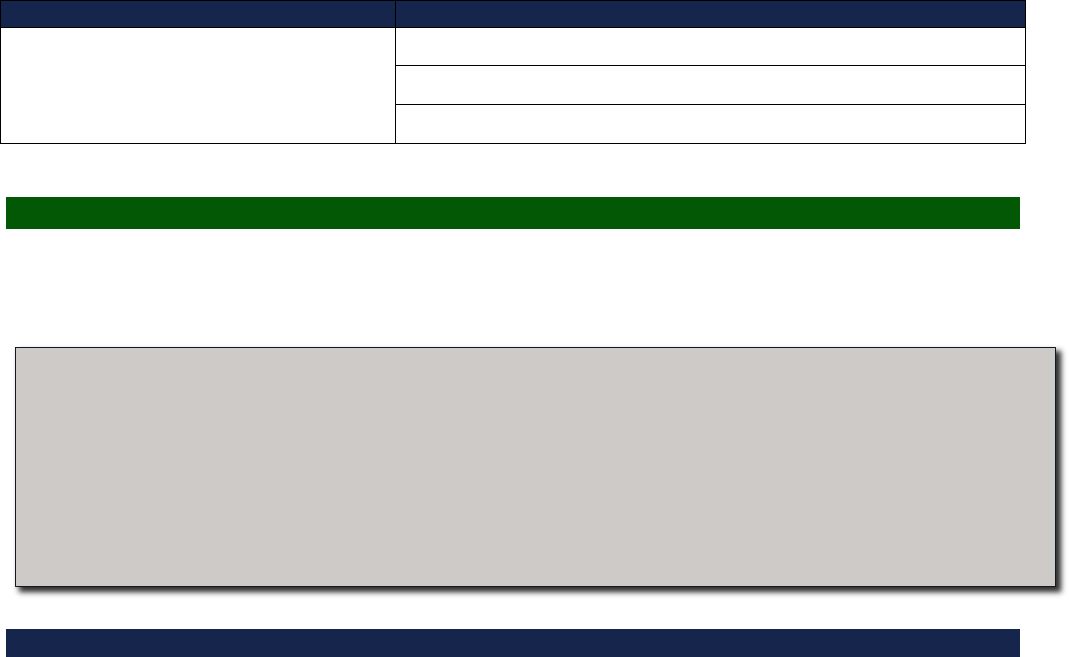
Rural Development Reporting & Compliance User Guide 105
Version 4, April 2024
DCS Reporting Category
R&C Reporting Category
Towers – 33 Wood Poles
Towers – 34 Improvements
Towers – 35 Other Towers
Appendix G: Generate and Export R&C Reports to PDF
You can export R&C reports to PDF for all project and account level reports from each stage in the
R&C report lifecycle. The PDFs will be automatically saved when your Rep Sign Cert submits the report
to USDA and will be available to download or print.
G1: Create and View a PDF for an UNSUBMITTED Report
In order to generate and access a PDF for a report that has not been submitted to USDA, the following
criteria must be met:
1. The user must be assigned a role associated with the account.
2. The report must be listed under either the Current or Pending Certification tabs.
If all the above conditions are met, use the following steps to create a PDF in the unsubmitted reports
process:
1. Click the [View Reports] button on the Home dashboard.
2. Click the tab that contains the report for which you want a PDF. See Figure 69 below.
***As of the Publication Date of this Manual***
The ability to create and save PDFs of R&C reports is a new feature within R&C. RUS deployed this
new feature on October 26, 2022. It is available for all reports generated by R&C or submitted by
awardees after October 26, 2022.
RUS is in the process of generating PDFs of all reports submitted prior to October 26, 2022.
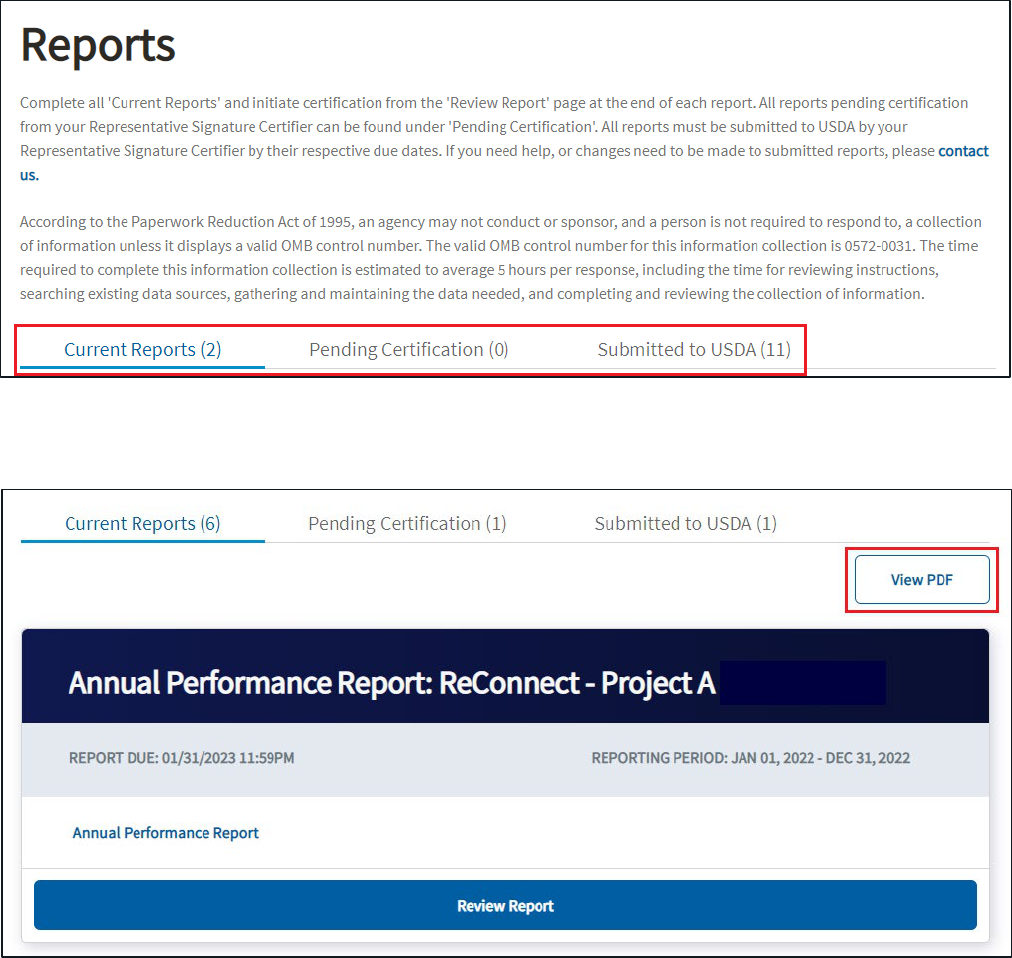
Rural Development Reporting & Compliance User Guide 106
Version 4, April 2024
Figure 69: Report status options
3. Click the [View PDF] button on the Reports dashboard as shown in figure 70.
Figure 70: PDF Button on the Reports Dashboard
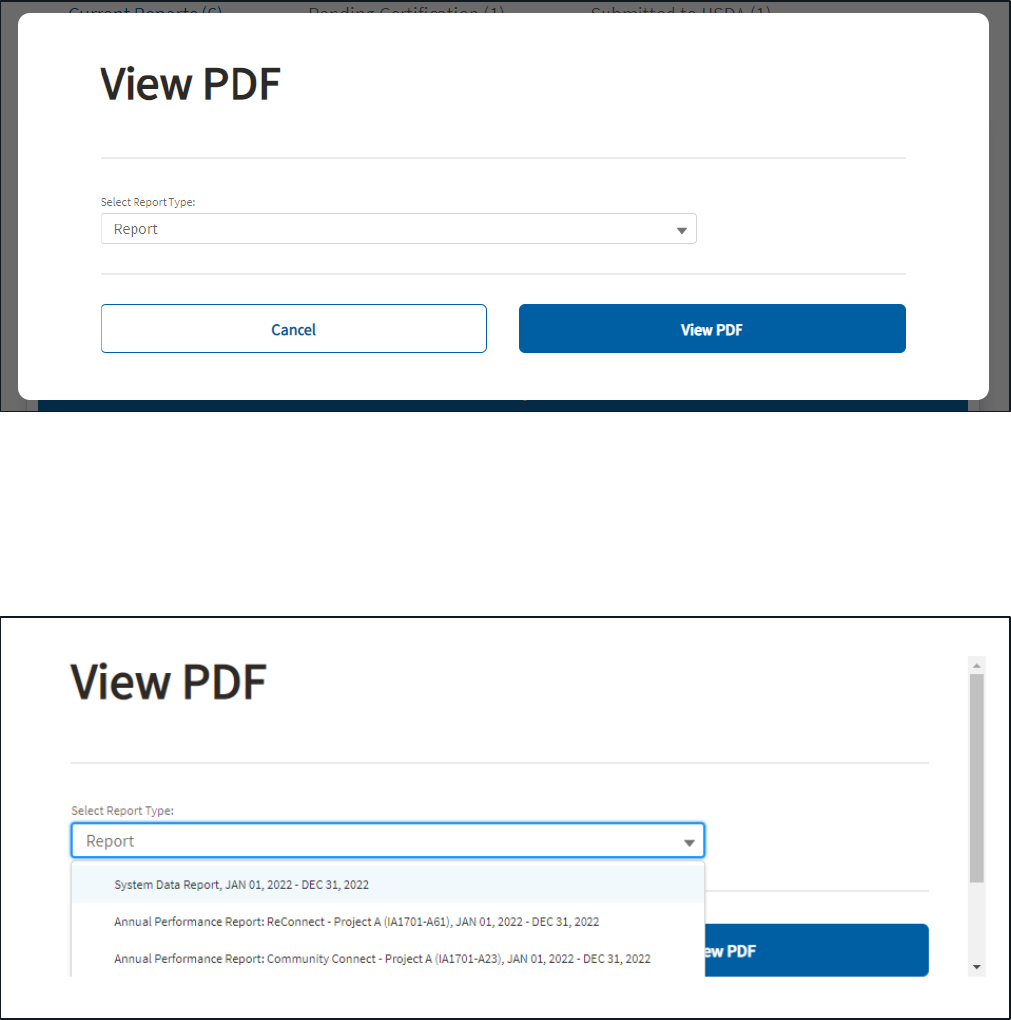
Rural Development Reporting & Compliance User Guide 107
Version 4, April 2024
4. A popup window will open as shown in figure 71.
Figure 71: Popup Window
5. Click the down arrow in the Select Report Type field. A dropdown will appear as shown in figure
72. Select the appropriate report.
Figure 72: Dropdown View

Rural Development Reporting & Compliance User Guide 108
Version 4, April 2024
6. Click the [View PDF] button after selecting the appropriate report as shown in figure 73.
Figure 73: View PDF Button
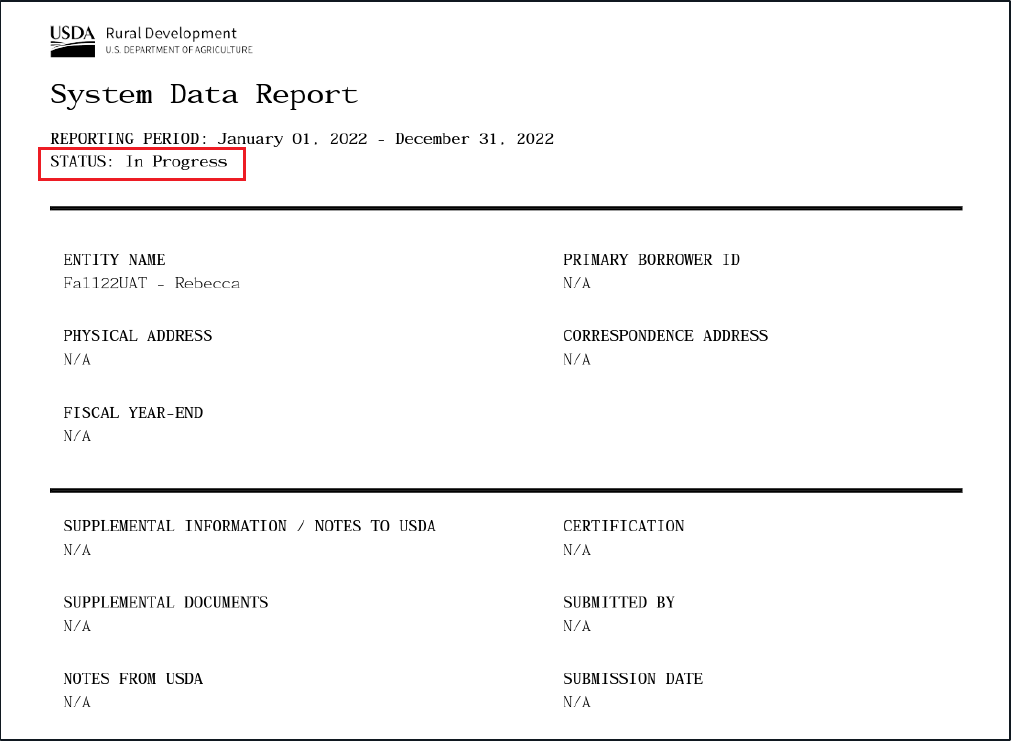
Rural Development Reporting & Compliance User Guide 109
Version 4, April 2024
7. A PDF of the report will open in a browser new tab. The report status is visible in the upper left-
hand corner of the report as shown in figure 74.
Figure 74: PDF Report with Status

Rural Development Reporting & Compliance User Guide 110
Version 4, April 2024
8. You can download or print the PDF by using the download and print tools in the upper right-
hand corner of the document as shown in figure 75.
Figure 75: PDF Print and Download options
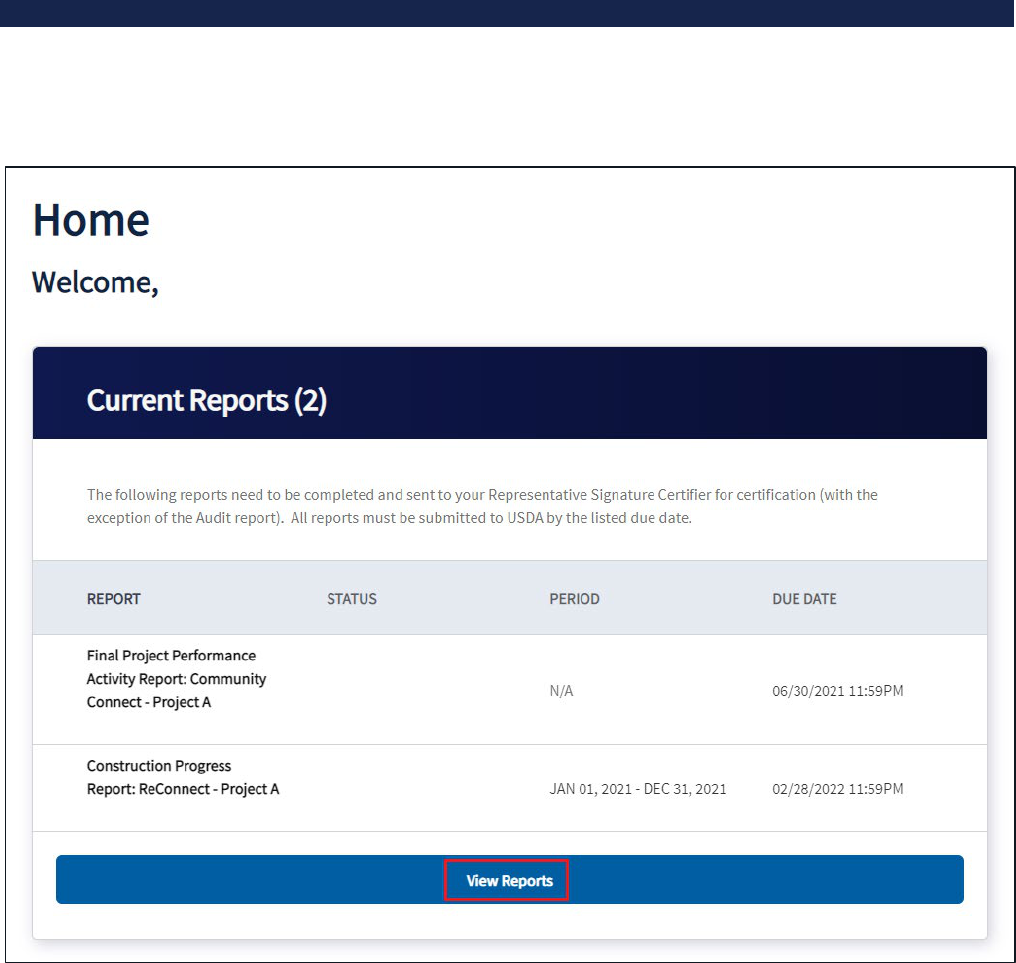
Rural Development Reporting & Compliance User Guide 111
Version 4, April 2024
G2: View a PDF for a SUBMITTED Report
The following process should allow a user to generate a PDF for reports submitted to USDA:
1. Click the [View Reports] button at the bottom of the Home dashboard as shown in figure 76.
Figure 76: View Reports Button
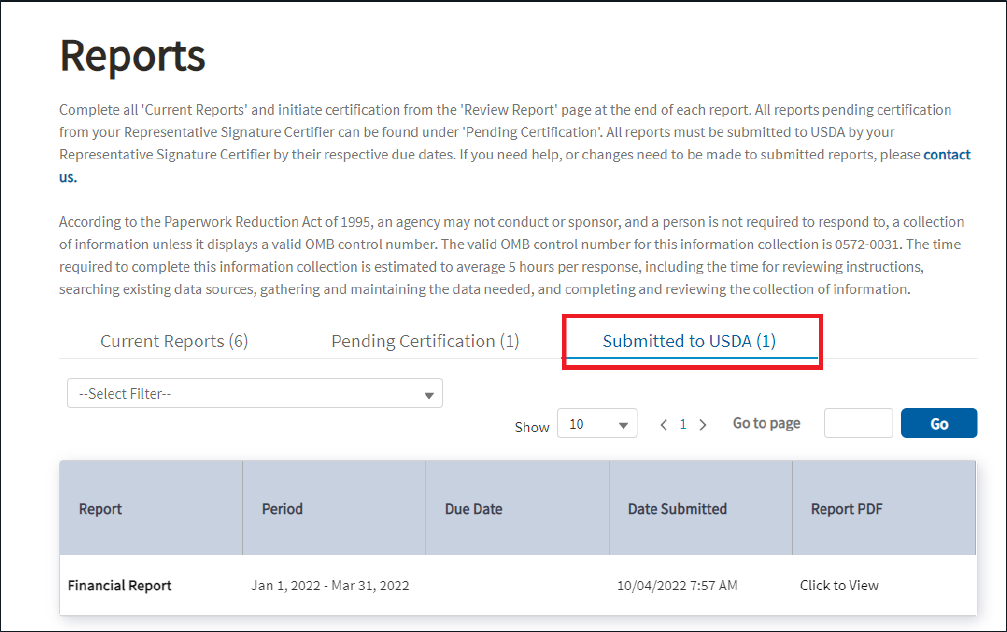
Rural Development Reporting & Compliance User Guide 112
Version 4, April 2024
2. Select the Submitted to USDA tab as shown in figure 77.
Figure 77: Submitted to USDA Tab
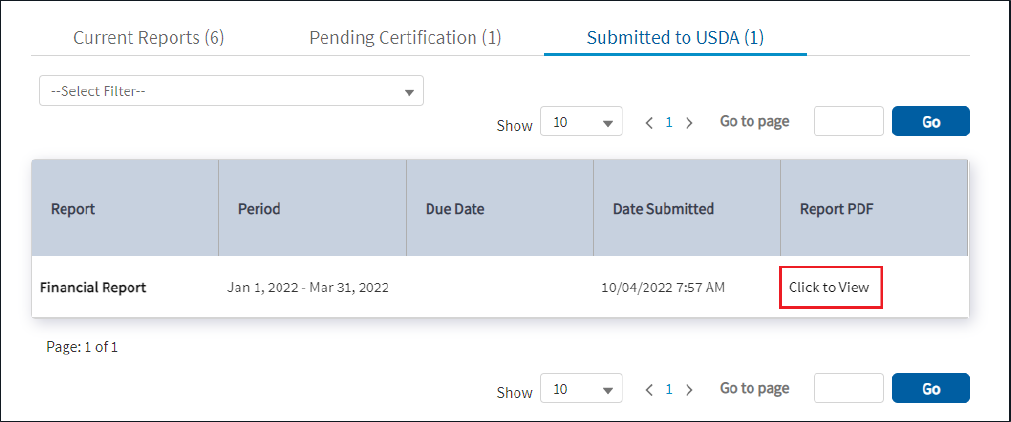
Rural Development Reporting & Compliance User Guide 113
Version 4, April 2024
3. Select the “Click to View” link associated with the report you wish to view under the “Report
PDF” column as shown in Figure 78.
Figure 78: PDF location for reports submitted to USDA
4. The PDF will open in a new tab where it can be viewed, printed, or downloaded as shown in
Figure 75 above.
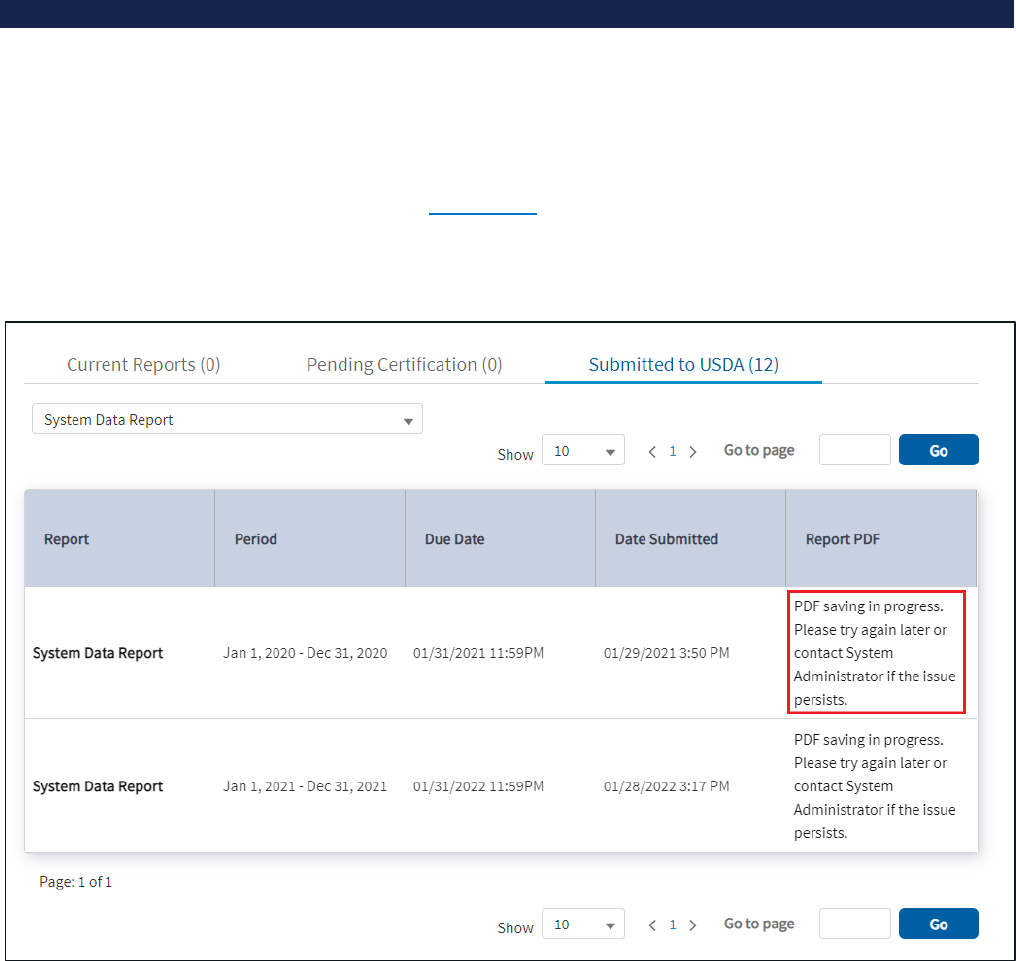
Rural Development Reporting & Compliance User Guide 114
Version 4, April 2024
G3: PDFs of Resubmitted Reports
If you resubmit a report after USDA returned the report to you, it may take a few minutes for R&C to
generate a PDF of the resubmitted report. While R&C is generating the PDF of the resubmitted report,
the link in the “Report PDF” column will show the message, “PDF saving in progress. Please try again
later or contact System Administrator if the issue persists.” as shown in Figure 79.
R&C will only show you the PDF of the most recently submitted report. If you need a copy of a
previously submitted report, please use the Contact Us
link to request it.
Figure 79: PDF Saving in Process Message
